

A Yachting Experience
Unlike anything else in the Carolinas.

Charters, Cruises, Overnight Stays & Amazing Memories
We deliver exceptional experiences you'll never forget, with private Yacht Charters sailing from Wilmington, NC.

Charters & Cruises
Whether it's a sunset cruise down the Cape Fear River or a multi-day trip exploring the Outer Banks & Beyond, we have the yacht and experience to fit any desire and any budget.

Overnight Stays at the Dock or on Anchor
Whether you want to be tied to the dock in downtown Wilmington, NC, close to the bars and local attractions, or on anchor in a cove that only the locals know about, join us and stay as long as you'd like. With all of the comforts of home, our beautiful 72 foot yacht is the perfect place to spend your evening.

WHY CAROLINA YACHT CHARTERS
Memories, Comfort & One Gorgeous Yacht
As the premier Yacht Charter in the Wilmington, NC, we know that nobody truly offers what we do. Our beautiful Mangusta 72 features three staterooms, three bathrooms, a full kitchen, a living room, and an entertainment area that will have your guests in awe. Able to sleep 8 and carry up to 12, bring the family and some friends - we have the room!

Our Yacht In Numbers
Up to 13
WEIGHT in POUNDS

An Experience You'll Never Forget
Contact us & begin your journey.
Thanks for submitting!
You've Got Questions, We've Got Answers
Guest Limits
Port City Marina
10 Harnett Dr
Wilmington, NC
Slip Location: Northern most slip on the river, towards Live Oak Pavilion
13 Guests for Charters
7 Guests for Overnight Stays
25 Guests for Dock Parties & Events
Frequently Asked Questions
What options do you offer?
We offer 2, 4, 6 and 8 hour cruises/charters as well as local overnight charters, destination overnight charters, and overnight stays at our dock which is conveniently located in walking distance to the bars and restaurants downtown.
Where can I view pricing?
Most of our prices can be found by clicking this link , with the exception of our overnight bookings. We offer overnight bookings at the dock and on charter, and both of those options we quote out depending on your itinerary. Please email us through the contact form on the site or at [email protected] to learn more.
What itineraries can we do?
We have a number of itineraries available for you to choose from, and we will recommend some to you depending on the time and year and day which your cruise is, the predicted weather, and how long you book the yacht for. Some sample itineraries are a sunset cruise, a yacht party next to a nearby private island, a day trip to Bald Head Island, a yacht party at Masonboro Inlet, a cruise along Wrightsville Beach, or multiple day trips to Myrtle Beach, Ocracoke, Charleston and beyond.
What do I need to bring?
Guests should bring any alcohol or food they'd like to eat, we should have just about everything else like all necessary safety equipment, the crew, etc. Soft drinks, water and ice are included and already onboard.
When should I arrive?
We recommend arriving about 15 minutes prior to your departure time so that you can get settled and receive your safety briefing before we depart.
What if I have more than 13 people?
While the Coast Guard does not allow us to carry more than 13 guests at sea, we absolutely can have a dock party with more than 13 guests. While we won't be able to leave the dock, you can still party the night away on a yacht!
What's Included?
All bookings include fuel, docking fees, the cost of the captain, his mate, and full use of the yacht and its water toys which include 2 kayaks, 2 paddle boards, a floating dock, music throughout the boat and free internet, YoutubeTV and Netflix. If you hire the chef or hostess, their services and food will be included as well.
What's NOT Included?
The price online does NOT include tax, gratuity, or alcohol. Food is not included unless you hire the chef. Lastly, we do not have any decorations onboard so please bring any decorations you wish to put up depending on your occasion.
Can we choose the time of our charter or cruise?
Yes, absolutely! Any time that you want to leave and return, we can make that happen!
What's NOT allowed?
While we want you to have the most amazing time aboard our beautiful yacht, a few things are strictly forbidden such as: Unsupervised Dock parties with more than the approved number of persons, sleeping more than 7 people onboard overnight, smoking, drugs, fireworks and flushing anything besides toilet paper down the toilets.
Where do I park and how much is it?
Complimentary parking is included and you will park in the Port City Marina parking. If there is a parking attendant there, let them know that you're there for a Carolina Yacht Charters cruise.
Are children and kids allowed?
While children and kids are allowed, please know that boats do present a safety risk to our kiddos. They must always wear a live preserver and should never be allowed outside without direct adult supervision.
What Add-Ons Are Available?
We have a number of things available to add on to your experience! All options must be quoted out depending on your party size and the length of your trip. Add-Ons include:
A chef, with all food included
A hostess to serve you and make drinks
Email: [email protected]
10 Harnett St
Wilmington, NC 28401
Sign up to receive news and updates!

COASTAL SOLS
Sailing cruises
Inspiring conscious living through coastal experiences
intro to sailing
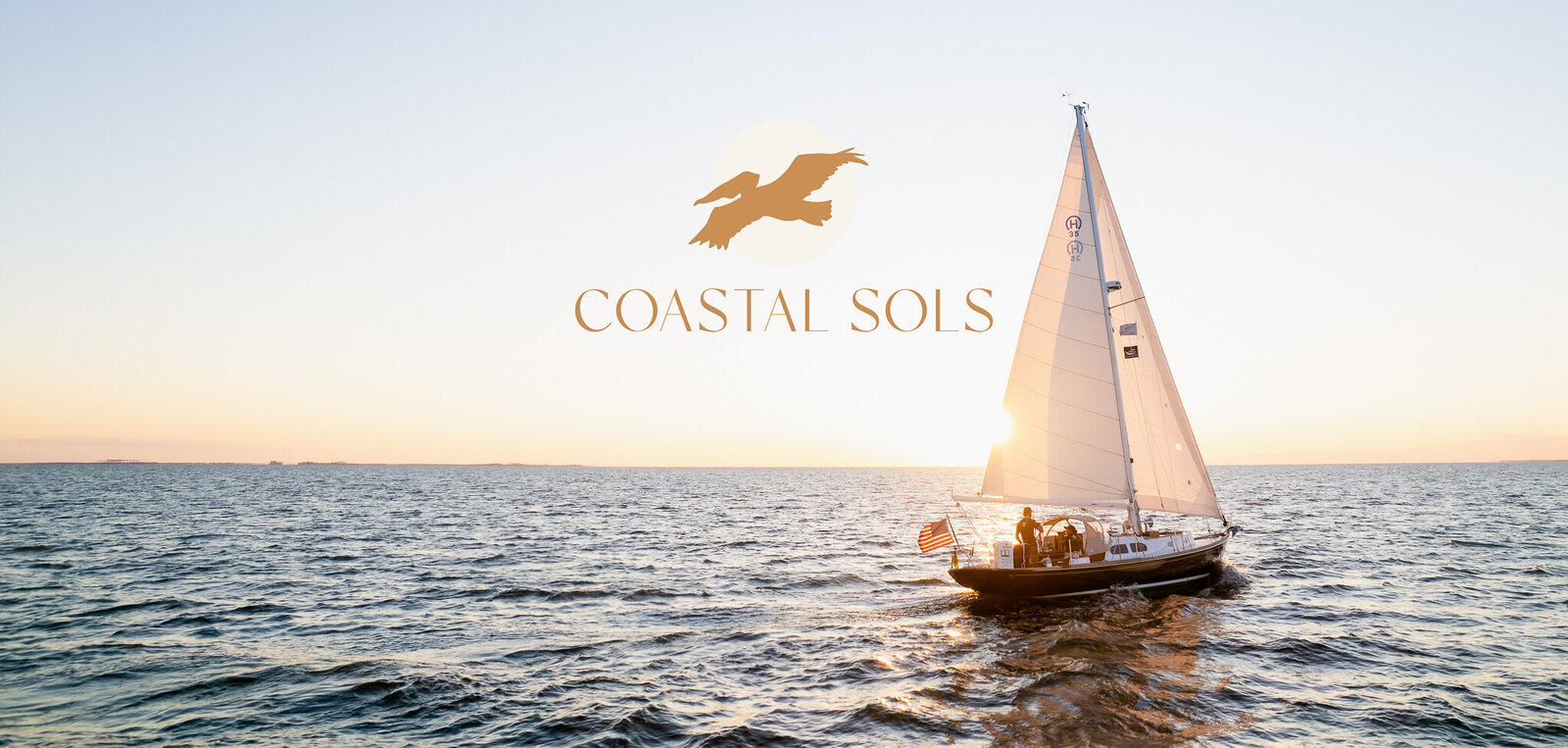
Our mission is to inspire conscious living through coastal experiences. The ocean constantly reminds us of who we are. It gives us a purpose, a sense of adventure, and connects us to something bigger than ourselves. Our vision is to create a community of Coastal Sols, who appreciate, discover, and continue to protect our oceans for future generations.
CLICK HERE TO view all of our offerings
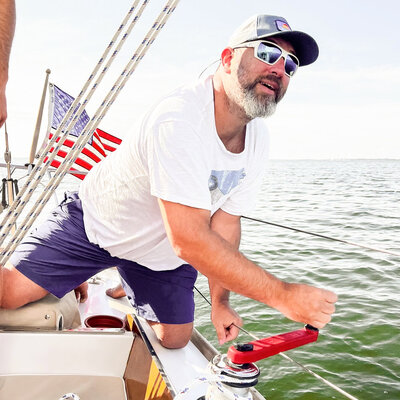
intro to sailing course
This course teaches you basic terminology and practical water techniques. it consists of two consecutive 3-hour days on the water. .
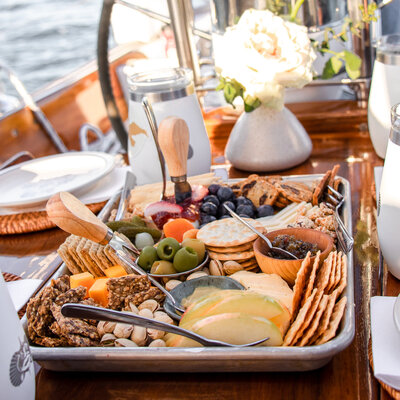
private Sunset Sails
Join us for a unique and memorable evening on the water with your friends and loved ones as we take in all the feels that nature has to offer. .
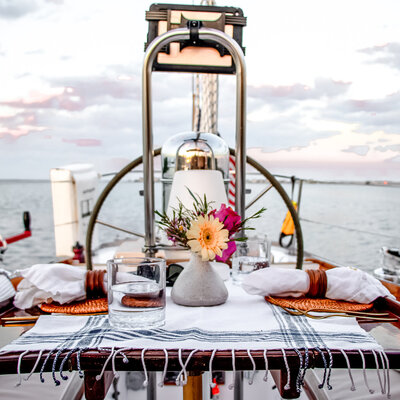
private Sunset Sail & Dinner at Anchor
This is truly an authentic coastal experience. join us for an exclusive sunset sail and dinner catered especially for you., -jacques cousteau.
“The sea, once it casts its spell, holds one in its net of wonder forever. ”
© 2024 Coastal Sols
Like what you see?
Let's go sailing.
follow our journey

navigate
sailing cruises
into to sailing course

Outer Banks Sailing: Hatteras Island
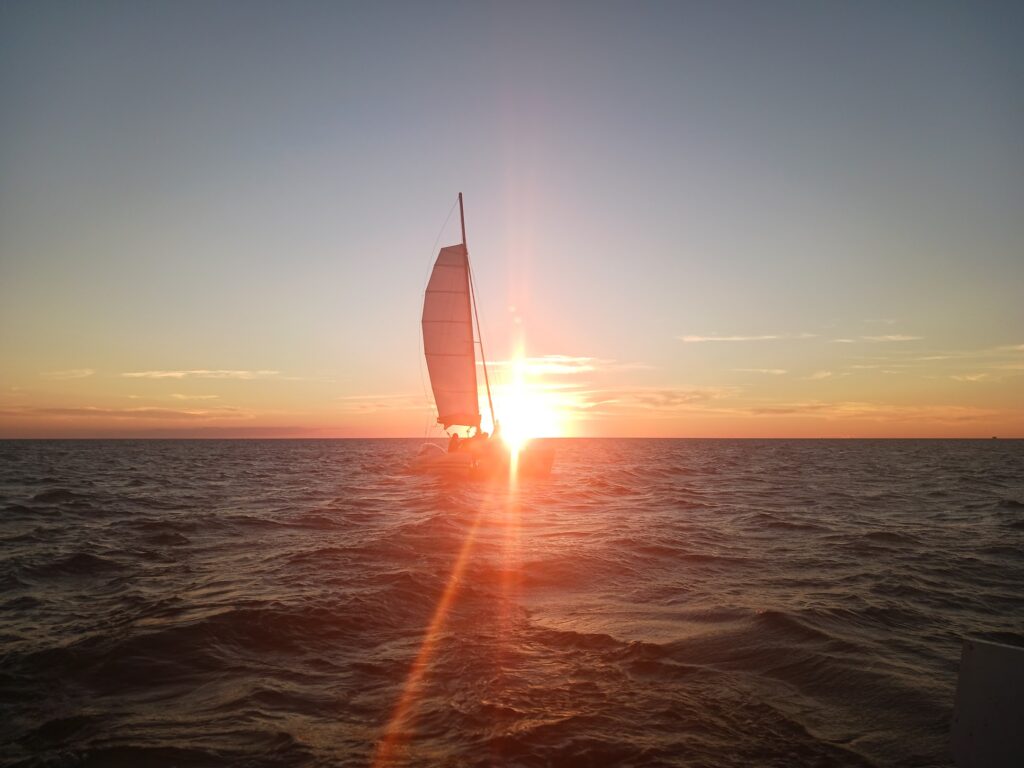
What to Expect
Expect to make Outer Banks Sailing from Hatteras Island your new vacation tradition. Our new location leaving from Buxton Harbor on Hatteras Island delivers adventure and memories you won’t forget. Fun for the whole family, our stable catamarans are roomy, stable and perfect for shallow Outer Banks sound-side sailing.
Plan to jump in, chill out, and kick back. Kids are welcome, grandpa’s are just fine also. Everyone enjoys this #SailStiletto experience. Sunset sails are our most popular experience.
Guest Testimonial
Once in a lifetime experience. The search for your ultimate OBX vacation activity starts here. Captain J took my whole family out for a sunset cruise (5yr old and 7yr old). He provided us with not only stunning views of the July sunsets but an evening filled with memories and laughter. You want be sorry for placing this on your things to do list. Thx again Captain J for making my children a forever memory. Terry Lambert
Reserve Your Sailing Charter On Cape Hatteras
Phillips Boatworks offers catamaran sailing charters on Hatteras Island in 2 hour and 4 hour experiences. We have a schedule that includes morning, afternoon, and sunset sails. Our most popular sails are the sunset sailing experiences. All our sails leave from our new location in Buxton at the historic fish house location in Buxton Harbor, 48926 NC Highway 12, Buxton, NC 27920
What is the advantage of a longer 4 hour sail? The 4 hour sailing experience offer more time for swimming and exploring off the sailboat. Our catamarans are lightweight performance boats that are easily beached. On the 4hr sails, we typically pull the boat up on a sandbar so that our guests can hop off the boat, take a swim, harvest some clams, and learn more about the local soundside marine life.
Why choose the shorter 2hr sail? The 2 hour sails are great for a relaxing sailboat ride. The scenery and experience is gorgeous. Because we sail, our tours are silent and perfect for videography, photography, and conversation. If you don’t need to hop into the water and just want to kick back and relax, the 2-hour sail is perfect for your group.
Sunset Sails
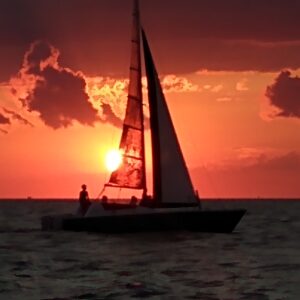
Morning Sails
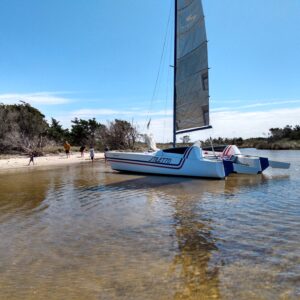
Afternoon Sails
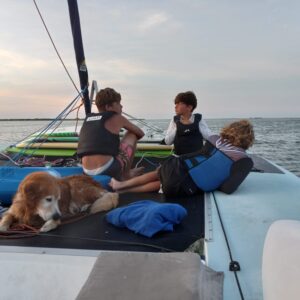
HAVE A LARGER GROUP? NO PROBLEM!
Larger group charters are available up to 12 guests.
Phillips Boatworks has two Stiletto-27 catamarans at our new Buxton Location. We can take larger groups with up to 12 adults sailing together in a tandem flotilla . Learn about Flotilla Sailing for larger group Sailing Charters on Hatteras Island.
The experience is even more special when your photos capture the second boat as you snap photos of your crewmates. The photography opportunities are spectacular.
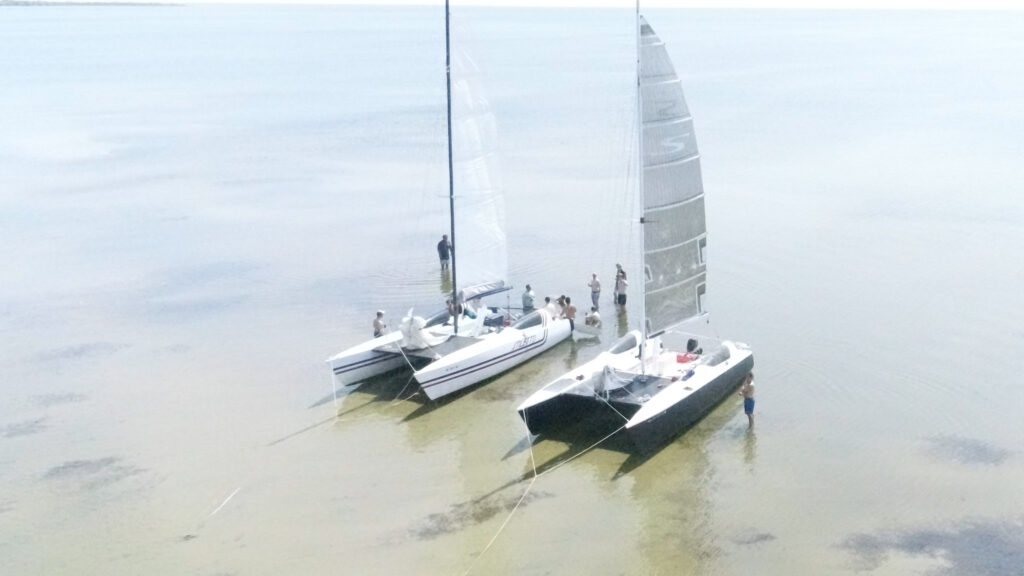
Outer Banks Sailing: Hatteras Island – Check Availability
Click any green date that you want to sail and the “tickets” will show the options available for that day. Hit the “book now” button to reserve your date. **NOTE: we do have a second boat. If you need a specific date and time which is not available or have a large party over six guests, you can check availability on our second boat, Stiletto Classic by clicking here
IS THE SAIL YOU WANTED ALREADY BOOKED? NO PROBLEM!
If the date that you want to sail is not ‘green’ or the sunset sail you hoped to book is not available, please check out other boat. You can do that by clicking here to check availability on our second boat .
Click any green date that you want to sail and the “tickets” will show the options available for that day. Hit the “book now” button to reserve your date. **NOTE: we do have a second boat. If you need a specific date and time which is not available or have a large party over six guests, you can check availability on the other boat by clicking here
Wednesday 09-18-2024
fetching availabilty of 4hr Morning Half Day (8am)
fetching availabilty of 2hr Morning Sailing (10am)
fetching availabilty of 2hr Afternoon Sailing (12:30pm)
fetching availabilty of 4hr Afternoon Half Day (12:30pm)
fetching availabilty of 4hr Sunset Sail – Explore, Adventure, and Sunset
fetching availabilty of 2hr Sunset Sail
oBX Boatworks
Build the boat you really want, design. craft. experience.
We are proud to customize each boat in a way that realizes the vision of its owner, rather than a "one size fits all approach." Let our custom boats portray your vision for the perfect nautical experience.
OBX designs and crafts boats drawing on the experience of a noted naval architect, design engineers, and master craftsmen. Our boats are crafted using a proprietary platform no other company has.
Yes, we sell boats, but our ultimate goal is to create the opportunity for an OBX owner to be part of memorable life experiences with family members, friends and business associates. We help design experiences.
OBX Boatworks Carolina Bay Skiff
The OBX Boatworks Skiff is a Carolina inspired inshore fishing machine and a perfect compliment to our Offshore Fishing Boats.
Center Console Sport-Fishing Boat
The 31 Center Console is a strong stable fishing machine in a trailerable package. This is the mid-sized model in our Center Console fleet.
The OBX 34 Center Console. Pure Carolina Design, Infused Construction, An Offshore fishing machine with a large cockpit and luxury cabin.
Fully Composite Sport-fishing Boat
34 OBX Boatworks Express. Pure Carolina Design, Infused construction, A true offshore Family Fishing Machine
Custom Boats & Exceptional Quality
We build custom boats with care, meticulous design, and expert craftsmanship to provide each client with an exceptional work of art, machinery, and experience. Instead of forcing a prospective owner to settle for a one-size-fits-all option, Brad Flater (Owner of OBX) draws on his expertise as a Naval Architect to customize each boat in a way that realizes the vision of its owner. We have several custom boat models that we have designed and crafted with each clients vision in mind. Let us help customize the boat of your dreams.
Custom Boat Models

Welcome to the OBX Family
While we seem to be living in a world obsessed with the future, all too often we undervalue the importance of our past. At OBX BOATWORKS, we reflect and embrace our past to inspire and design the future.
Brad Flater, President/CEO
Yes, we sell boats, but our ultimate goal is to create the opportunity for an OBX owner to be part of memorable life experiences with family members, friends and business associates.
Featured Articles & Resources
Our blog is full or resources, information, and all things "boating." Feel free to like and share our posts and subscribe to our email newsletter below to stay up to date with the latest and greatest of all things OBX Boatworks.
Seaworthy O. Henry Magazine
High Point’s Brad Flater grew up dreaming of designing boats.
Carolina Boat Building Legacy Continues With OBX Boatworks
We had the pleasure of having our company recognized on by Coastal Carolina Fisherman Magazine regarding keeping the tradition and legacy alive.
OBX 31 Center Console - Best Boat Florida Sportsman
We had the pleasure of having our OBX 32 Center Console Sportsfishing Boat recognized on by Florida Sportsmans' Best Boat review.
OBX Boat Xchange
Sail the Outer Banks with us on our 41 ft Gulfstar! We sail from the downtown Manteo Waterfront located on Roanoke Island in the Outer Banks of North Carolina.
Our sail charters are sunset cruises and are available for 2-1/2 hours, with glorious sunsets over the water as we return to the Manteo Waterfront! Enjoy a private sail charter with us, up to 6 guests, sailing on the Roanoke and Albemarle Sounds.
And yes, a private sail charter means just that, it will be just you and your family/friends, we do not put other people on board 'to fill the boat up". It's your cruise, your boat! Feel free to roam about the boat while we are underway, we have found that couples really enjoy sitting on the foredeck under the genoa (forward sail), with only the sound of the breeze through the sails and the splash of water on the bow.
If you have interest in sailing the boat we enjoy letting people have a turn at the helm, adjusting lines, learning how to work the chart plotter and radar. Feel free to bring your own food and drinks, people usually will bring a cooler with them. We are pet friendly! Sunset Sails return back to the Manteo Waterfront right at sunset, rates are $100 per person ($350 minimum) up to 6 guests. Call (252) 473-2719 for reservations. Our Outer Banks Cruises leave the Manteo Waterfront Marina, our slip is at the end of Budleigh St, behind Poor Richard's Restaurant and the Tranquil House Hotel ( see photos at right).
Let's go sailing!
If you schedule and the weather is iffy, we will call that day to confirm, no charge for cancelling due to weather.
Private Sail Charters!
Enjoy a great day of OBX sailing with your friends, and see the Outer Banks from the water!
Sail the Outer Banks
- Sea'Scape Photos
- Guest Comentaries
(252) 473-2719
Early Bird Special!! 10% off all Rentals, use code: 10off at checkout
OUTER BANKS BOAT RENTALS, JET SKIS, & MORE BE YOUR OWN CAPTAIN!
Check out our featured rentals, link gallery.

KAYAK AND PADDLEBOARD RENTALS
Discover the serenity of Hatteras Island with our premier kayak and stand-up paddleboard (SUP) rentals. Immerse yourself in the tranquil waters of the Pamlico Sound, surrounded by breathtaking views. Our rental services include top-quality equipment, ensuring a safe and enjoyable experience. Explore the untouched beauty of Hatteras at your own pace, equipped with all the essentials – paddles and life jackets provided.
READ WHAT PEOPLE ARE SAYING ABOUT US!

Pontoon rental
"We had a great outing on the Pamlico Sound with the hard top pontoon. Easy to drive, able to fit coolers, fishing gear and 16 people. It was fabulous!"
Good Service, Great Rates
"This is a top notch operation. Looking to get out on the water in the OBX, call Charlie's. Reservations are a good idea. The fleet was worn but serviceable. The folks were great and their rates are the lowest we found. Worth the trip."
Great experience
"Very nice and knowledgeable staff. Very friendly and an overall great experience. Would definitely use them again."
Jet ski rental
"Great people and great jet skis! We got there and they put us in a ski in a matter of 10 minutes. Of course call ahead if you have a big party. Worth the prices!"
Private Charters
Join us on one of our private outer banks sailing cruises on the gorgeous waters of the outer banks.
Our Private charters are the perfect way to give your family, friends, and other companions an experience they won’t soon forget. Sail the waters of the Currituck Sound on a private tour — just for you and your crew. Spend your time enjoying each other’s company amongst the dazzling shoreline with limited development, refreshing breeze and inviting energy.
Celebrate a special occasion or simply take advantage of the wonderful Outer Banks weather. Guests of our private charters will feel like the water is completely theirs during this exclusive cruise.
Please call: 252-261-2900
GETAWAY CHARTERS
Surfer Girl is available for charter on the waters of the Currituck Sound
The charters are perfect for:
BACHELOR/ETTE PARTIES FAMILY CRUISES ROMANTIC GETAWAYS CORPORATE EVENT BIRTHDAYS & ANNIVERSARIES
CHARTER TIME 2-3 Hrs - Starting 10 AM up to Sunset CHARTER COST (Min 8, up to 18 people) - Starting at $560 ADDITIONAL HOUR COST - Please call 252-261-2900
Online or hardcopy waiver at time of purchase
Charters Book through Nor'Banks Sailing and Watersports in Duck, NC
CUSTOM CHARTER
Set sail on a trip that was made just for you. With a custom charter, you can explore the Outer Banks or celebrate any occasion just the way that you envision.
Call us about additional activity packages- Lily pads, SUP tour or lesson, wake board, tubing and more
ACTIVITY PACKAGES
Each charter has a number of additional toys that you can book these consist of - Lily pads, SUP tour or lessons, wake board, tubing and more
Please call us to add these to your charter - 252-261-2900
FAQ - WHAT YOU NEED TO KNOW
How long is each charter.
Scheduled day sail and sunset cruise are approximately 2-3 hours long. We ask that you board at least 15 minutes before departure. Depending on the weather your tour may be a bit longer or shorter.
DO YOU ACCEPT CREDIT CARDS AND CHECKS?
We do accept credit cards and checks, but cash is greatly appreciated! You can book a trip through Nor'Banks Sailing and Watersports. Just follow our booking links.
DO CHILDREN AND INFANTS COUNT AS A PASSENGER?
Yes, they do. The United States Coast Guard considers every person, except for the Captain, as a passenger.
WHERE ARE YOU LOCATED?
Nor’Banks Sailing and Watersports , 1314 Duck Road, Duck, NC 27949
We encourage you to carpool, bike or walk to our facility. Parking is tight as we must share with our partner businesses.
WHERE DO YOU SAIL?
We will sail in the Currituck Sound. A wide and long body of water with limited development.
WHAT TIME SHOULD I ARRIVE FOR MY CRUISE?
Please arrive no later than 15 minutes before your cruise is scheduled to depart. If you’re running late, please contact us and let us know because we’re likely holding the entire boat for you.
HOW MANY PEOPLE CAN WE ACCOMMODATE?
We have a capacity of up to 18 people on board, plus our 2 crew.
CAN I BRING MY OWN FOOD/DRINKS/ALCOHOL?
Beer, white wine, etc is allowed. No red wine allowed on board (stains the deck). No liquor please.
DO YOU HAVE FOOD/DRINKS AVAILABLE FOR PURCHASE ON BOARD?
Not at this time. But you are welcome to bring your own beer, wine, sodas, etc. No red wine or hard liquor please.
CAN I BRING MY DOG?
We love pets too, but others may not. Sorry, no pets allowed on board unless it is a licensed/certified service animal.
WHAT SHOULD I WEAR?
Spring and fall- layered clothing and a light jacket. Summer time- light clothes, shorts, sunglasses or a hat for the sun. We will ask you to leave your shoes at the dock. Please no spray sunscreen.
DO YOU PROVIDE LIFE JACKETS?
We have life jackets on board for everyone- Infants, children and adults. They are not required to be used unless there is an emergency. If you feel you need to wear one, please ask the captain and one will be provided to you.
WHY MIGHT MY SAIL BE CANCELLED?
The most common reason a sail is cancelled is due to poor weather conditions that would make sailing uncomfortable and/or dangerous. We never enjoy canceling a sail, but if we must, we will call to inform our guests. We also encourage guests to call ahead the day of their sail to confirm their reservation and verify conditions. If this were to happen we would happily reschedule or refund your cruise.
WHAT HAPPENS SHOULD IT START RAINING DURING MY SAIL?
Sailors often get wet when they sail. We have a covered area on board, but also encourage you to bring a poncho or rain jacket if it is forecasted to rain.
CAN I PROPOSE MARRIAGE TO MY SWEETIE WHILE ON BOARD?
Yes! If you inform the captain of your plans, he can find you a quiet, isolated spot on the boat. Don’t forget the champagne!
DO YOU HAVE A BATHROOM ON BOARD?
We do, if it is urgent and you cannot wait. However, we encourage you to use the rest room prior to departure.
DO YOU OFFER GIFT CERTIFICATES?
Ask the mate or captain or contact us for more details.
SHOULD I TIP THE CAPTAIN AND CREW?
Yes. They work for tips. Tips are personal and depend on how satisfied you are not only with the sailing experience that the captain has provided. Typical tip is 18-25% of your charter or ticket.
CAN WE SWIM FROM THE BOAT?
Swimming is allowed from the boat, please coordinate with the captain for this activity prior to taking off from the dock.
Great Location
" * " indicates required fields
1314 Duck Road, Duck, NC 27949 252-261-2900
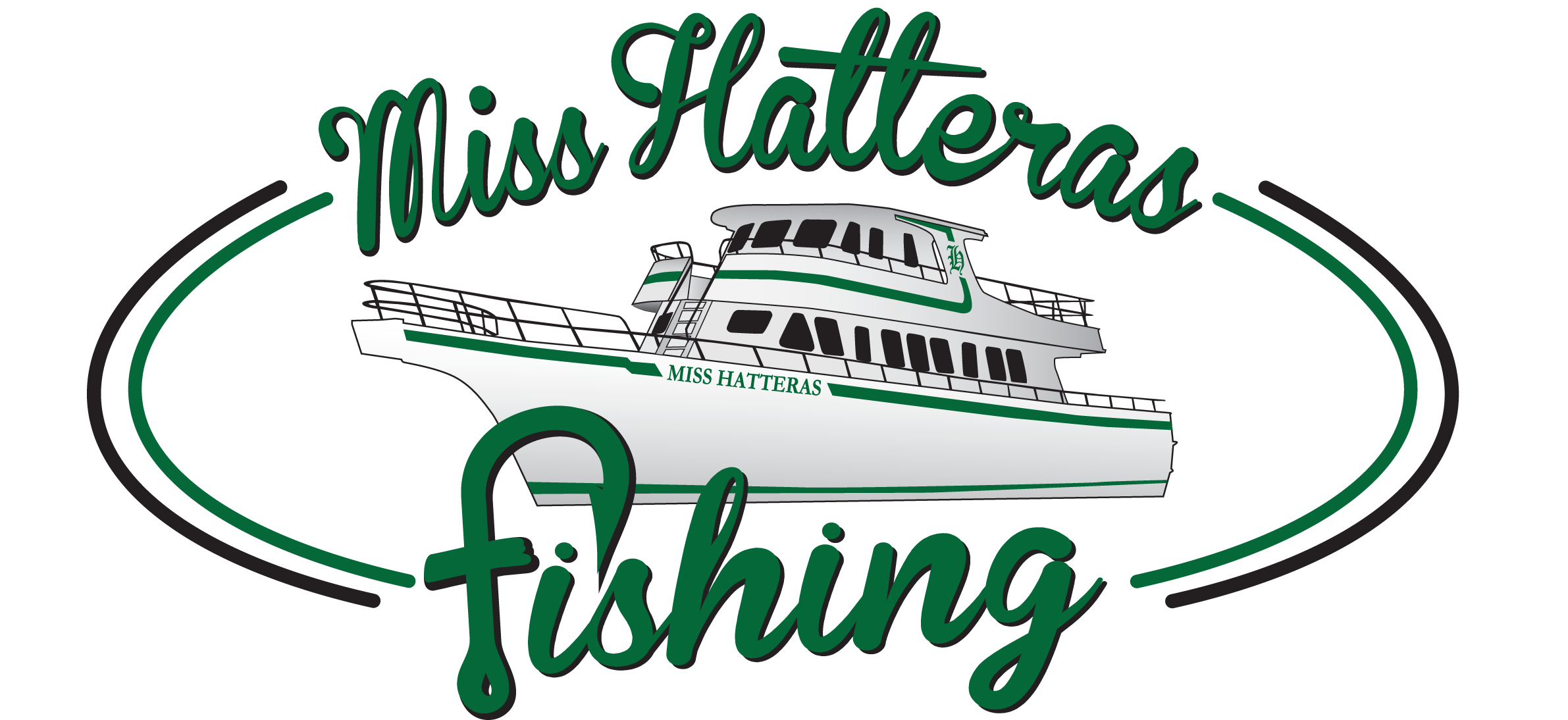
Are you looking for a fishing adventure in the Outer Banks?
We've been taking visitors and locals on affordable fishing trips and scenic cruises on the miss hatteras head boat in the heart of the outer banks for over 30 years., fishing trips for any age and skill level.
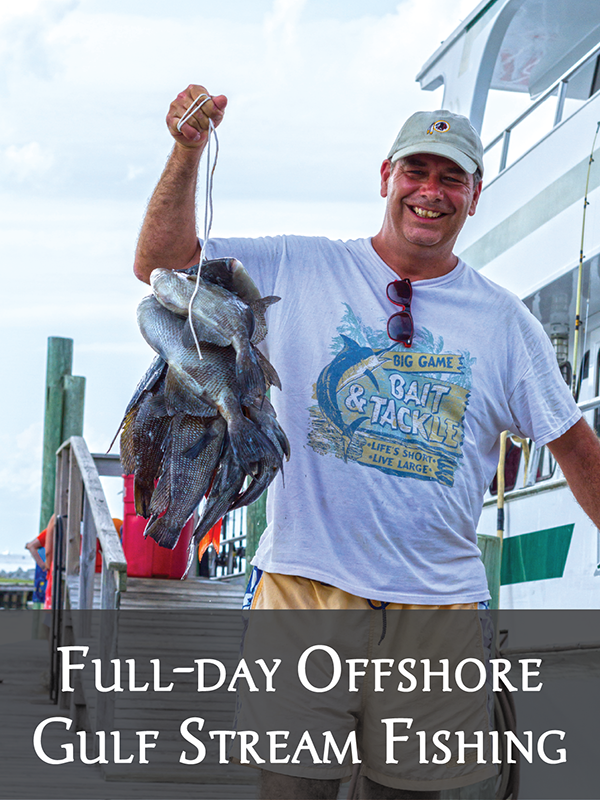
Scenic cruises are fun for the whole family!

Make memories that will last a lifetime.
We offer affordable fishing trips and scenic cruises near you for tourists and locals aboard our head boat in the outer banks of north carolina..
For over 30 years we’ve been operating our party boat in the Outer Banks of North Carolina, taking both first-time visitors and regular customers on offshore and inshore fishing trips, as well as on our popular evening scenic cruises.
On the Miss Hatteras, we provide an affordable, fun, and memorable experience for everyone who steps onboard our boat. Whether you’re an experienced angler, a first-time fisher-person, or if you’re just looking to relax and watch dolphins play at sunset in the Pamlico Sound, our goal is to make your day the best it can be, whatever activity you choose.
There are numerous options for sightseeing and fishing in the Outer Banks, but we often see our customers year after year, and we’d like to add you to the list this year! For more information about our services, or to make a reservation on our head boat, click here to contact us or give us a call at (252) 986-2365 .
Take a fishing trip in the Outer Banks!
Or enjoy a scenic cruise with the family!
Join us on-board for a fishing adventure in the Outer Banks!
Enjoy a day of fishing, a scenic sunset cruise, or plan a private event aboard the miss hatteras head boat in the outer banks of north carolina., tales from the sea, fishing reports, information about the outer banks, and more.
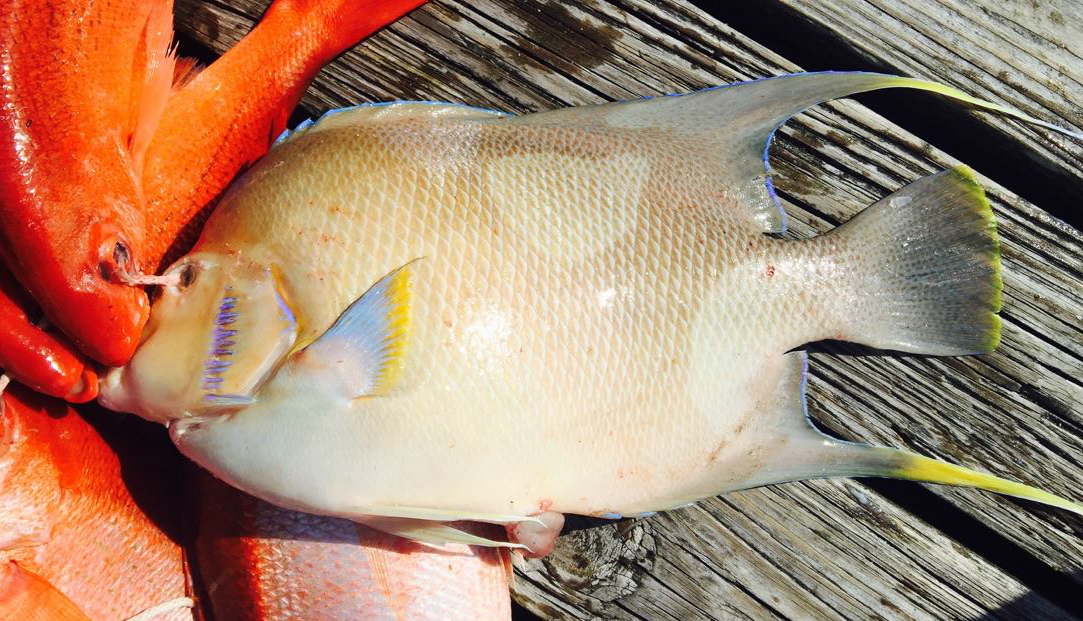
A rare catch on our full-day offshore Gulf Stream trip aboard the Miss Hatteras!
About a month ago on our full-day offshore Gulf Stream trip, one of our lucky anglers caught an extremely rare catch! Here's what he had to say about
Wanchese, North Carolina
Bluewater yacht sales at safe harbor outer banks.
The Bluewater Yacht Sales Wanchese yacht brokerage office is an authorized dealer for new Back Cove , Jarrett Bay Boatworks , Regulator , Sabre , Viking and Valhalla models.

Bluewater Yacht Sales - Wanchese, NC
Get Driving Directions
Our Wanchese Team

Sales Professional
Testimonials
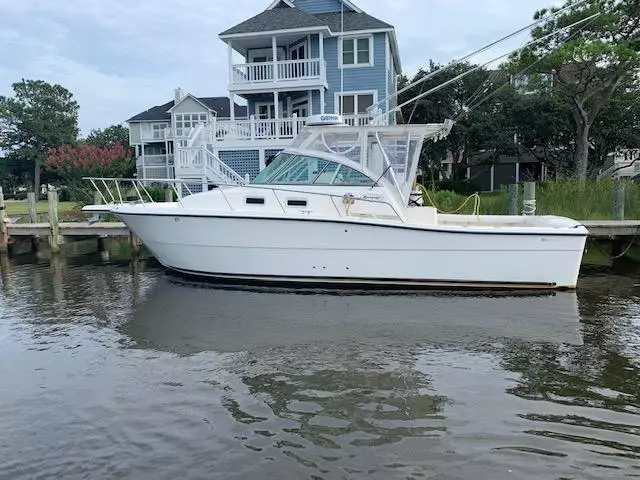

Boating's Best Brands

Waterfront Office Locations
- Baltimore 410.342.6600
- Annapolis 443.716.7965
- Ocean City 410.390.3043
- Hampton 757.723.0793
- Virginia Beach 757.937.2570
North Carolina
- Wanchese 252.216.2960
- Beaufort 252.728.2645
- Morehead City 252.728.2645
- Wilmington 910.256.6643
- South FL 561.845.0606

On The Water Bayliss 60′: Sequentis
On the water bayliss 82′: catch 23, on the water bayliss 75′: wave paver, on the water bayliss 67′: overtime, boat in production bayliss 64′: max bet, boat in production bayliss 75′: big deal.
Every detail, no matter the size, won’t go unnoticed on a boat. Paying attention to details helps us gain satisfaction about the quality of our product. In the end, our favorite part of the collective task is the privilege that comes in building something that will outlive us all.

John Bayliss
Global Headquarters

800 / 830 Motoryacht
Unique destinations are the essence of yachting, and the Outer Reef 800/830 Classic (24 meter) Motoryacht is Fully Ocean Capable, providing complete Trans-Atlantic range: the consummate adventurer is limitless in his or her choices of itineraries. Owners and crew are as comfortable on board as on land, with this model boasting the largest crew quarters and flybridge available within the industry.
Cruising Speed: 9 – 18.5 knots Max Speed: 14.5 – 22.5 knots
Exterior Gallery

Interior Gallery

800 / 830 Motoryacht STANDARD SPECS
SUBJECT TO CHANGE WITHOUT NOTICE SELECT A SPEC OPTION BELOW
| LOA: | 80’ 0” (24.38 m) / 83’ 0” (25.3 m) |
| Beam: | 21’ 0” (6.4 m) |
| Draft: | 5’ 6” (1.67 m) |
| Displacement: | 179,000 lbs (81 metric tons) |
| Fuel Capacity: | 3,000 gallons (11356 lts) |
| Water Capacity: | 500 gallons (1893 lts) |
| Holding Tank Capacity: | 250 gallons (946 lts) |
HULL CONSTRUCTION
- Hand laid-up FRP hull with PVC core sandwich construction above water line
- Solid laminate, commensurate for hull size, made in female mold
- Vinylester barrier lamination for osmosis protection
- Simulated planked hull
- Full length longitudinal engine stringers and athwartship stringers
- Gel coated finish above waterline
- Two (2) coats of black antifouling paint over five (5) coats of epoxy primer below waterline
- Integrally molded rub rails with stainless steel capping
- Full length keel extends below running gear
- Stainless steel rudders and struts with two (2) Seatorque enclosed drive shaft systems
- CE-approved stainless steel portlights
- Boat construction from only 3 major molds
- Divinycell PVC cored construction with cook gelcoat
- All deck and hull area hardware attachments are finished with solid lamination – no coring
- Bilge area finished smooth and coated with bright white epoxy paint
- Windows with 3/8" tempered safety glass in salon and ½' tempered safety glass in pilothouse
- Quiet Roll™ integrated spray rail system
- Vessel Vanguard marine maintenance system
- ABT Trac 38hp hydraulic bow and stern thursters
- ABT Trac 250 stabilizers with 7.5 sq. ft. fins
- Northern Lights uplift water separator exhaust
- Underwater exhaust system with bypass and FRP mufflers
- Copper bonding system to all underwater fittings with zinc anodes
- Two (2) Seatorque enclosed drive shaft systems and two (2) Nibral propellers
- Rigid fresh water pipes and color coded copper fuel lines
- Stainless steel struts with bearings
- Headhunter 24v DC and Mach-5 115v AC fresh water pumps with accumulator tanks
- Two (2) 24v DC automatic shower sump systems with external pump
- Accessible wiring raceway throughout
- One (1) holding tank with a max capacity of 250 US gallons (946 lts) with two (2) macerator/discharge pumps. One (1) is wired and plumbed for backup redundancy
- One (1) stainless steel water tank with a max capacity of 500 US gallons (1893 lts)
- Three (3) aluminum fuel tanks with a total capacity of 3,000 US gallons (11356 lts)
- Lexan sight gauges on fuel tanks
- Inspection and cleaning ports on all tanks
- Fuel fills built into house sides in FRP cabinet
ENGINE ROOM
- Acoustically insulated stand-up engine room lined with sound absorbing material
- Edura beige coin dot flooring
- Twin John Deere 6135 (750 hp) diesel engines with ZF transmissions
- Fiberglass drip pans under engines
- Northern Lights generator – one (1) 30kw (60hz) w/ sound shields (one (1) 24kw (50hz) for AU-EU)
- MarineAir chilled water air conditioning system
- Two (2) sea chests
- Ball-valve bronze seacocks on all through-hulls below waterline located in sea chests
- Oil change pump for engines and generators
- Two (2) 100amp isolation transformers
- 5 kw inverter/charger (24v DC to 115v AC 60Hz) (5 kw inverter/charger 24v DC to 220v AC 50Hz for AEU)
- Two (2) Racor 75/1000 max dual fuel filters with gauges for main engines
- Two (2) Racor 75/1000 max single fuel filters for generators
- Fuel polishing system
- Fuel management system
- Fireboy fire suppression system including both intake and outlet air shutdown system with aluminum louvers
- Four (4) automatic bilge pumps 24v DC and emergency bilge suction on engine
- a) In the guest passageway bilge forward of the water tank 1- 2700 GPH
- b) In the forward master bilge 1-2700 GPH
- c) In the forward engine room bilge 1-3700 GPH
- d) Forward crew bilge 1-2700 GPH
- Fire system and bilge high-water alarm system with warning panel
- Fresh water hose bibb
- Two (2) engine banks with two (2) 8D batteries for each bank
- One (1) house bank with eight (8) 8D batteries with a total 1020 amp-hours (24VDC)
- Two (2) generator banks with one (1) battery each
- One (1) 24v and one (1) 12v battery charger
- Two (2) battery isolators
- Two (2) 20 gallon water heaters with heat exchanger off one main engine
- Four (4) 24v DC blowers
- Eight (8) LED overhead Lights –110v AC/24v DC (220v AC/ 24v DC for AU-EU) with two (2) two-way switches
- Two (2) 110v AC GFI outlets (220v 50hz for AU-EU) with water proof covers
- 316 Stainless steel safety rails around engines
- Work bench space
- Two watertight bulkheads
- Watertight aluminum engine room doors with sight windows
AFT DECK AREA
- Aft deck with teak decking
- Built-in swim platform with teak decking
- Stainless steel removable swim ladder on swim platform
- 2" 316 stainless steel removable safety rails on swim platform
- Stairway built-in to port and starboard side from swim platform to aft deck with FRP gate doors
- Aft deck FRP bench seating with storage beneath
- Exterior furniture fabric for aft deck and Portuguese seats (deducted from décor allowance)
- Fixed aft deck table – teak with stainless steel bases (Wood species other than teak, such as wenge, cherry, walnut, etc, are optional)
- FRP sliding door to salon with glass window top and bottom
- FRP weather tight door on transom
- Transom shower in recessed box with hot and cold water supply
- Fresh water wash down outlet
- Shorepower inlets for 110v/220v 60hz (220v 50hz for AU-EU)
- Two (2) Glendinning 100 amp cable masters with 75' of cable on transom
- Glendinning electronic engine controls via hand held remote
- Six (6) LED courtesy lights with two (2) two-way switches
- Five (5) LED overhead lights with one (1) standard switch inside the salon
- Two (2) 110v AC GFI outlets (220v 50hz for AU-EU)
- 316 Stainless steel heavy duty cleats secured to stainless steel backing plates inside bulwarks
- Deck scuppers piped out through transom at boot stripe
- 316 Stainless steel handrail to and from aft deck
- Molded with teak decking
- Stainless steel handrails alongside decks
- Weathertight doors opening into pilothouse port and starboard
- House side fixed windows with tinted tempered glass
- Two (2) sets of 316 stainless steel spring-line chocks per side
- Four (4) 316 stainless steel hawser holes with stainless steel cleats per side recessed in bulwarks
- Fuel fill fittings for tanks recessed into house side
- 316 stainless steel overhead safety rails at side steps
- Four (4) LED courtesy lights along walk ways
- Eight (8) LED overhead lights with two (2) standard switches
PORTUGUESE BRIDGE
- Portuguese bridge molded with teak decking
- Locker doors in aft face of Portuguese bridge
- 316 Stainless steel handrail on top of Portuguese bridge
- Hinged door through Portuguese bridge to foredeck
- ½" Clear tempered glass in forward facing windshields
- Windows are fixed with FRP recessed frames - no FRP trim around for easy removal and installation of glass
- Three (3) LED courtesy lights with one (1) standard switch
- Foredeck with white non-skid surface
- 316 Stainless steel CE-approved skylight/emergency hatch from the VIP stateroom below
- 316 Stainless steel rail on bulwarks increasing in width going forward
- 316 Stainless steel stanchions to support handrail
- Deck lockers forward either side of anchor platform finished in white epoxy paint
- 316 Stainless steel anchor chute/roller at bow
- 105 lb plow-type anchor with 350' long 1/2" high test chain
- Maxwell VWC-4000 Hydraulic vertical windlass with foot switches and remote controls for dual stations
- Salt water wash down pump with outlet
- Fresh water wash down with outlet
- Salt water and fresh water 316 SS faucets inside foredeck lockers
- Three (3) LED courtesy lights
- One (1) 110v AC GFI outlet (220v 50hz for AU-EU) in inside settee
- Deck drains plumbed to boot-stripe to prevent black streaks
- Exclusive Deluxbridge® full-beam width deck with white non-skid surface and ample storage space
- 316 Stainless steel safety rails
- Venturi windscreen with 316 stainless steel rails
- Molded FRP steering console with engine controls
- Electronics console
- Glendinning electronic engine controls
- 5" magnetic compass
- Hypro hydraulic steering system
- 316 Stainless steel destroyer steering wheel
- One (1) Stidd helm seat, model 500-200, naugahyde with matching powder coated base
- ACR 300 24v DC searchlight with dual station controls
- Fire system repeater alarm
- Two (2) L-shaped settees with exterior furniture fabric for cushions (deducted from décor allowance) and two (2) tables
- Five (5) Aquasignal navigation lights in accordance with appropriate collision regulations
- Kahlenberg dual trumpet air horn with compressor
- FRP radar mast
- Hard top over flybridge
- 316 Stainless steel mast with bow and anchor lights
- 316 Stainless steel sliding hatch and stairs starboard side down to pilothouse with four (4) LED courtesy lights and two (2) twoway switches
- Six (6) LED overhead lights with one (1) standard switch
- Two (2) LED service lights under flybridge steering console with one (1) standard switch
- One (1) LED courtesy light on step down to boat deck
- One (1) 12v DC outlet (220v 50hz for AU-EU)
- Gate door to boat deck
- Deck with white non-skid surface
- 316 Stainless steel hand rails
- Deck box on port side
- Cabinets behind settees for wash basin, refrigerator, icemaker and/or BBQ grill
- 800KGS/1700lb aluminum painted davit with 4 way hydraulic control with rotating base, luff, lift, pendant switch and a 12' telescoping arm, with wireless remote
- Swing gates forward of optional dinghy with 1 ½" stainless steel pipe
INTERIOR ALLOWANCE
- Interior décor allowance $80,000. This is a "Use or Lose" allowance for the purchase of interior and exterior soft goods (cushion fabrics, bed covers, shams, pillows, etc). This allowance is not transferable to any designer other than Outer Reef's designated in house designer
- Three (3) Fireboy CO detectors
- Sliding door entrance from aft deck
- Fixed windows in house sides with medium 3/8" tinted tempered safety glass
- Teak valance over windows with LED rope lighting
- Twelve (12) LED overhead lights with two (2) two-way dimmer switches and one (1) standard dimmer switch
- LED rope lighting at valance with one (1) standard switch
- Access hatches to allow for engine removal
- Vinyl headliner
- One (1) free standing fixed teak coffee table (Wood species other than teak, such as wenge, cherry, walnut, etc, are optional)
- Entertainment center cabinet starboard with additional storage cabinets
- Two (2) end tables (built in)
- Loose-laid furniture (deducted from décor allowance)
- Air conditioning control panel
- Teak cabinetry and lockers
- Six (6) 110v AC outlets (220v AC for AU-EU)
- One (1) TV outlet
- Carpeted floor (deducted from décor allowance)
- Teak wall paneling with satin finish
- Drawers with full extension guides and push button latches
- Teak cabin doors and cabinet doors
- Chrome door handles on all interior lockers
- Granite or corian countertops with stainless steel under mount sinks
- Breakfast bar attached to galley counter facing forward
- Drawer for soap and sponges in front of the sink
- Chrome Grohe Europlus II faucet with pull out spray
- Eight (8) LED overhead lights with two (2) standard switches and one (1) two-way dimmer switch
- Teak cabinets and cabinet doors with chrome push-button locks
- Two (2) 110v AC GFI outlets (220v AC GF for AU-EU)
- Teak and holly sole
- 36" counter-depth side x side refrigerator
- 24" dishwasher with stainless interior
- 30" built-in microwave
- 30" electric cooktop
- 30" built-in oven
- 15" trash compactor
- Garbage disposal with switch
- 606L side x side refrigerator with IceBeam door cooling
- 600mm fully integrated dishwasher
- 600mm touch control ceran cooktop
- 600mm slide-out range hood
- 600mm 65L stainless steel oven with full glass
- 600mm stainless steel microwave
- 380mm stainless steel automatic trash compactor
- Stainless steel garbage disposal with switch
DAY HEAD (STARBOARD)
- Granite countertop with white Kohler under-mount sink
- Chrome Grohe center-set single lever faucet at sink
- Teak framed mirror
- Storage cabinet under sink
- Wallcovering
- Headhunter 24v electric white toilet with sanitary hose for all discharge plumbing
- Ventilator blower
- One (1) 110v AC GFI outlet (220v AC GF for AU-EU)
- Two (2) LED overhead lights with one (1) standard switch
- U-shaped settee on raised platform
- Teak table with single 316 stainless steel pedestal (Wood species other than teak, such as wenge, cherry, walnut, etc, are optional)
- Nine (9) LED overhead lights with one (1) standard switch, one (1) dimmer switch and two (2) two-way dimmer switches
- Two (2) LED red night lights with one (1) dimmer switch
- One (1) chart light
- LED red and white bridge lights
- Two (2) 110v AC outlets (220v AC GFI for AU-EU)
- One (1) USB outlet
- One (1) 12v DC outlet
- Custom Outer Reef wood steering wheel at pilothouse helm
- Hypro hydraulic power assist steering system
- Engine display screens
- Overhead electronics console
- Wiring routes to facilitate equipment installation
- Main electrical distribution panels with gauges and circuit breakers for AC and DC
- Alarm and advisory panel
- Transom doors on AC, DC and advisory panels
- Glendinning electronic engine controls with back up gear and throttle with synchronizer
- Three (3) stainless steel Exalto dual speed (intermittent) self-parking windshield wipers with wash down system
- ½" clear tempered glass in forward facing windshields
- Control for bow thruster
- Generator control panel
- 24v DC to 12v DC converter
- Windlass up/down switch and control circuit breaker
- Bilge pump control on advisory panel
- Equipment running advisory panel
- Teak stairway to flybridge to starboard
- Weathtertight doors opening out to port and starboard
- Curved teak stairway leading to accommodations
LOWER HALLWAY
- Curved teak stairway from pilothouse with five (5) LED courtesy lights and two (2) two-way switches
- Five (5) LED overhead lights with two (2) two-way switches and one (1) standard switch
- Combination of wall covering and teak wall paneling with satin finish in stairwell and hallway
- Cabinet for storage or optional stackable washer and dryer
- Storage under first two steps of the stairwell below
- Access doors to staterooms
FULL BEAM MIDSHIP MASTER STATEROOM
- King size berth
- 7" layered foam mattress
- Drawer storage under the berth
- LED rope lighting under the bed and at valance with one (1) standard switch and two (2) two-way dimmer switches
- Two (2) walk-in closets
- Six (6) built in cabinets
- Automatic interior lights in lockers
- Two (2) built-in vanity desks on each side of the stateroom with drawers
- Drawers with center guides and stops
- Door stops and holders
- Teak framed door
- Cantalupi chrome reading lights
- Four (4) CE-approved portlights with removable insect screen
- Shoji screens
- Five (5) 110v AC outlets (220v AC for AU-EU)
- Nine (9) LED overhead lights with three (3) three-way dimmer switches, two (2) two-way dimmer switches and one (1) standard switch
- Nightstand teak tables with two drawers each
- Dyson V8 Absolute vacuum cleaner
MASTER HEAD (ENSUITE)
- Ensuite head with shower
- Clear tempered glass shower door with towel bar
- Molded white FRP shower
- Grohe Relaxa Plus chrome pulsator hand shower with hose and soap dish
- Ventilator fan in shower
- Granite countertop with two (2) white Kohler under-mount sinks
- Chrome Grohe center-set single lever faucet at sinks
- Teak framed mirror with medicine chest
- 24v DC ventilator blower
- Two (2) 110v AC GFI outlets (220v AC GFI for AU-EU)
- Five (5) LED overhead lights with three (3) standard switches
- Separate compartmented toilet area with CE-approved portlight
VIP STATEROOM FORWARD
- 316 Stainless steel CE-approved skylight
- Tapered queen-size berth
- Teak storage drawers under the berth
- Two steps on each side of the berth for easy access
- LED rope lighting under the bed and at valance with one (1) standard switch
- Two (2) hanging lockers with teak-faced doors
- Two (2) 110v AC outlets (220v AC for AU-EU)
- Five (5) LED overhead lights with two (2) two-way dimmer switches and one (1) standard dimmer switch
- Two (2) Cantalupi chrome reading lights
VIP HEAD (ENSUITE)
- Clear glass shower door with towel bar
- One (1) 110v AC GFI outlet (220v AC GFI for AU-EU)
- Three (3) LED overhead lights with two (2) standard switches
GUEST STATEROOM PORT
- Two (2) CE-approved portlights with removable insect screens
- Two (2) twin berths with storage drawers underneath
- 7" layered foam mattresses
- One (1) built-in nightstand
- One (1) hanging locker with teak-faced doors
- Automatic interior light in locker
- Two (2) LED overhead lights with one (1) two-way switch and one (1) two-way dimmer switch
PORT HEAD (ENSUITE)
CREW QUARTERS AFT
- One (1) CE-approved portlights with removable insect screens
- Two (2) transverse berths, one (1) twin and one (1) queen, with storage drawers underneath
- LED rope lighting under bed with one (1) standard switch
- One (1) TV outlet
- Six (6) LED overhead lights with two (2) two-way switches and two(2) standard switches
- Storage space behind galley with storage cabinets and room for optional washer and dryer
- Steps leading to transom
CREW GALLEY
- L-shaped settee on raised platform
- Five (5) LED overhead lights with two (2) standard switches
- Undercounter refrigerator
- 12" electric cooktop
- 30" built-in convection microwave
- One (1) CE-approved portlight with removable insect screen
- Tecma Marine 24v electric white toilet with sanitary hose for all discharge plumbing
- Four (4) LED overhead lights with two (2) standard switches and two (2) two-way switches
CRUISING/SAFETY PACKAGE
- Six (6) 15" x 41" Polyform F-series black fenders
- Twelve (12) 15' x ½" black fender lines
- Four (4) 3/4" x 35' double-braid nylon black dock lines
- Two (2) 3/4" x 50' double-braid nylon black dock lines
- Twelve (12) Safeguard type I orange life vests for adults over 90 lbs
- Six (6) Kiddie Mariner 2 ¾ lb M10 fire extinguishers
- One (1) Bernard oil discharge placard (US Model Only)
- One (1) Bernard waste discharge placard (US Model Only)
- Two (2) Jim-Buoy 24" white ring buoys
- Four (4) Perko chrome/brass 4-ring buoy holders
- One (1) Orion alert/locate flare kit
- One (1) Orion circumnavigator first aid kit
- One (1) Orion safety blaster horn
STANDARD MARETRON PACKAGE
- Engine - generator integration onto the Garmin screens
- AC/DC power monitoring
- Tank level monitoring
- Wi-Fi interface
- Engine exhaust, transmission and SeaTorque shaft temperature monitoring
- 8” Maretron screen in the crew area (where applicable)
- Navigation lights, bilge pump monitors
- All monitors projected onto the Garmin screens
- Further information available upon request
800 / 830 Motoryacht Videos
800 / 830 Motoryacht Virtual Tours
Click one of the buttons below to preview one of our Virtual Tours
800 / 830 Motoryacht News

California and PNW Yachts

September 2008

800 / 830 Motoryacht Testimonials
OPEN FOR BOOKINGS THROUGH NOVEMBER 30TH

OBX PONTOON MAN
Private pontoon boat rentals in outer banks, north carolina.
Crabbing•Fishing•Tubing•Tours
- Most Popular
Pontoon Rentals
Explore the Outer Banks with confidence! An Outer Banks pontoon boat rental is the perfect choice for anyone looking for a fun and memorable day out on the water.
- Tags 4 Hour , 8 Hour , 7 Day
Sail Away with OBX's Pontoon Boats
- Tags 4 Hour
- User All Ages
Four Hour Charter
This fishing, crabbing, tubing, and dolphin tour is perfect for seasoned angler or a newcomer to the sport, there’s something for everyone in the crystal-clear waters and abundant wildlife of the Outer Banks, NC.
- Tags 2 Hour
Private Tubing Trips
Escape to the pristine waters of the Outer Banks and experience the ultimate adventure with our Private Tubing Trips! Immerse yourself in nature, soak up the sun, and feel the rush of the waves as you glide across the water on a tube.
Sunset Cruise
Escape the hustle and bustle of everyday life and embark on an unforgettable sunset cruise along the breathtaking Outer Banks. Soak in the beauty of the brilliant colors painting the sky as the sun dips below the horizon.
We’re glad your here! Captain Randy Graham is ready to show you the best inshore crabbing, fishing, tubing and tours on the Outer Banks. Captain Randy’s 22ft Crest ® OBX Pontoon Boat rental can comfortably accommodate up to 6* passengers on half day or full day charters.
Customers can also rent the pontoon boat by themselves if they so desire.
Parties up to 12 may be accommodated. Please contact Captain Randy at (252) 619-7987 to make arrangements.
Outer Banks boat tours located in Nags Head, NC. Charter inshore pontoon boat tours can be made all year long, view our half day OBX fishing and crabbing and tubing, full day Outer Banks Inshore fishing, crabbing and tubing, two hour tours or Outer Banks sunset evening cruises
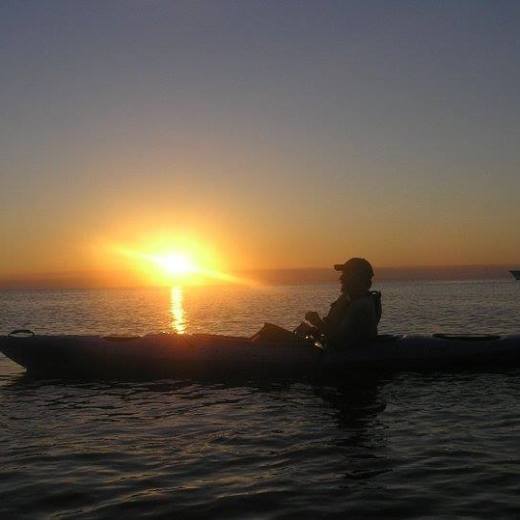
OBX's Best Pontoon Boat Experience! ★★★★★
Captain Randy took us on the best adventure. We've been coming to the OBX for 30+ years and saw things we've never seen. We saw dolphins, and osprey nests, a hermit crab island, caught fish, went tubing, and brought up a few crab pots. It was an excellent morning. Worth every penny. We also loved the cruise through the fishing marina in Wanchese. Loved hearing all the stories.
Captain Randy was great! We went out on the tubes, we saw dolphins and we even learned first hand how to bring in crabs! We have 4 kids, ranging from 12 to 23 years and fun was had by all. On the way home, all 4 kiddos said this was the best adventure we have done in all our years visiting the OBX!
Captain Randy took my family and friends for a great afternoon ride. We did tubing, saw dolphins, explored two small island beaches, crabbed, and fished. He was very knowledgeable of the sights in the ICW and attentive to making the experience fun for all! We came away with 40+ blue crabs, which made a great meal to top off the day. Highly recommend Capt. Randy for a fun-filled day!
I went with a group of 6 and at no time was I bored. We went fishing, tubing, crabbing, island hoping, dolphin watching and clamming. He told us all about the big ships we passed and he seemed to know everybody else out on the water. All in all it was a really great way to start the day, would recommend!

NAI Global Lists Rare Outer Banks Land Acquisition
Monday, 16 September 2024 12:00 PM

NEW YORK, NY AND COROLLA, NC / ACCESSWIRE / September 16, 2024 / NAI Global announces a rare land listing of 177+ acres for sale in North Carolina's Outer Banks, a region known to millions of Americans as a destination getaway that is largely comprised of multi-million-dollar homes, residential condominiums, resort hotels and supporting commercial development.

The unimproved land spans approximately 177+ acres on five parcels of varying sizes, two of which face the Atlantic Ocean providing direct beach access. Located near Corolla in Currituck County, the parcels are approved for a by-right development which allows for 1,250 hotel rooms, as many as 782 single-family-homes and nearly 428,000 square feet of commercial development. Municipal water and sewer are provided for each parcel.
Section T has the highest building height permitted in the Outer Banks. All of these sections have the right to rearrange density on a pre-approved basis. One of the parcels has the potential to build a marina/boat launch facility with water access to Currituck Sound, which is an allowed use under the development agreement with Currituck County.
The waterfront parcels are 82.6 acres and 44 acres respectively. The option exists for a buyer to develop one or more exclusive family compounds, or pursue a larger development as currently permitted.
"We don't see many properties like this come to market, especially for a remarkable resort area of the U.S. The buyer will have numerous options to build estate properties, exclusive resorts and income-producing commercial properties. Normally with land sales, one of those options may exist, but it is rare that all three options exist within a single acquisition," said Alex Waddey, President and CEO of NAI Global.
In addition to Alex Waddey and NAI Global's Capital Markets Team, the exclusive selling agents are Dean Geis, President of NAI Geis Realty Group, and the North Carolina Real Estate Broker is Robbie Perkins, CCIM, SIOR, Shareholder and President of NAI Piedmont Triad.
The for-sale listing is unpriced. It is believed to be the largest land listing of unimproved property with direct-Atlantic Ocean access in the Eastern U.S.
Approval has been obtained and plans are in process to build an additional bridge to serve the northern Outer Banks - called the Mid-Currituck Bridge, that would stretch across Currituck Sound. The bridge would be a 7-mile span connecting the mainland with the Outer Banks near Corolla, a short distance from Ocean Sands. This would substantially reduce travel time and improve access. Currently, this area of the Outer Banks is served by the Wright Memorial Bridge on U.S. 158 at the southern end of Currituck County into Dare County - a region made famous by the Wright Brothers for launching the first successful flight of an aircraft, which took place near Kitty Hawk.
About NAI Global
NAI Global is a leading global commercial real estate brokerage firm. NAI Global offices are leaders in their local markets and work in unison to provide clients with exceptional solutions to their commercial real estate needs. NAI Global has more than 325 offices strategically located throughout North America, Latin America, Europe, Africa and Asia Pacific, with over 5,800 local market professionals, managing more than 1.1 billion square feet of property and facilities. Annually, NAI Global completes over $20 billion in commercial real estate transactions throughout the world.
NAI Global provides a complete range of corporate and institutional real estate services, including brokerage and leasing, property and facilities management, real estate investment and capital market services, due diligence, global supply chain and logistics consulting and related advisory services. To learn more, visit www.naiglobal.com .
Contact: Gary Marsh, Marsh Marketing 415.999.3793 or [email protected]
SOURCE: NAI Global

Contact Us Today
If you have questions or want to learn more about our products, our team’s here to help.
WHO WE SERVE
PRESS RELEASE DISTRIBUTION
PRESS RELEASE OPTIMIZER
MEDIA SUITE
MEDIA DATABASE
MEDIA PITCHING
MEDIA MONITORING
IR WEBSITES
COMPANY SPOTLIGHT
PRESS RELEASE SAMPLE
PRESS RELEASE TEMPLATE
CUSTOMER REVIEWS
CONNECT TODAY!
Content licensing, join our newsletter, 866-694-3099.
ACCESSWIRE | All Rights Reserved
- --> Login or Sign Up
- Login or Sign Up -->
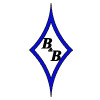
- Outer Banks Cruisers
- Outer Banks 20
Outer Banks 20 (Plans and Templates)

- B&B Annual Messabout
- Capsize Camp
- All Kayaks and Canoes
- Diva 15'8" Kayak
- Grand Diva 17'6" Kayak
- Moccasin 12' Canoe
- Flyfisher 13' Canoe
- Moccasin 14' Canoe
- Moccasin Double 15'6" Canoe
- Birder Decked Canoe 13' and 15'8
- Expedition Sailing Canoe
- All Dinghies and Tenders
- Catspaw Pram
- Spindrift Dinghy
- All Sailboats
- Core Sound 15
- Core Sound 17
- Core Sound 17 Mark 3
- Core Sound 20
- Core Sound 20 Mark 3
- Bay River Skiff 17
- Belhaven 19
- Mini Trimaran
- Class Globe 5.80 Kit
- Princess Sharpie 22'
- Princess Sharpie 26'
- All Powerboats
- All Jessy Skiffs 12-17'
- Jessy 12'
- Jessy 15'
- Jessy 17'
- All Outer Banks Cruisers
- Outer Banks 24
- Outer Banks 26
- All Ocracoke Center Consoles
- Ocracoke 20
- Ocracoke 20-B
- Ocracoke 24
- Ocracoke 256
- Cape Lookout 28
- Wing Foil Kits
- All Other Kits and Plans
- "Tractor" Canoe Seat
- Mast Head Floats
- Windvane Self Steering
- All Building Supplies and Tools
- Marine Plywood
- All B&B Epoxy
- Temperature Control for Epoxy
- Epoxy Additives
- All Hardware and Rigging
- All Rigging
- Eyestraps and Fairleads
- Shackles, Hooks and Pins
- All Rudder Hardware
- Pintles and Gudgeons
- Tillers and Accessories
- Hardware kits
- All Masts, Track and More
- 6061-T6 Aluminum Tubing
- Sailtrack and Accessories
- Starboard Mast Plugs
- Wind indicators
- All Electrical
- Battery Monitors
- Solar Power System
- Boarding Ladders
- Beach Rollers
- All Apparel
- B&B Approved Products and Tools
- Shop by Brand
B&B Yacht Designs
- Amarine Made
- Armstrong Nautical
- View all Brands
- Create New Wish List
Share This Article
- Similar Products
Product Description
If you’re not interested in the kit options, this is what you need. All of the full size (24x36") detailed construction plan sheets plus our full size mylar templates for transferring the parts directly to plywood.
Study Plans:
For a detailed look at the construction without the commitment of the templates we’ll send you a selection of plan sheets printed in a reduced 11×17. These include construction and profile plan, jig plan dimensions and interior layout and details. A great gift for someone potentially interested in the boat! Deduct the cost of study plans (less shipping) from the future purchase of a complete plans set (within 1 year).
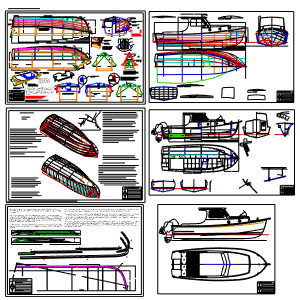
Product Videos
Custom field, product reviews.
- Recommended

Outer Banks 24' (Plans and Templates)

Outer Banks 26' Plans

Outer Banks 20 Kit Deposit

Core Sound 20 Plans

Ocracoke 20 original Plans

Ocracoke 20-B Plans

Study Plans: OB-20 (PRINTED)
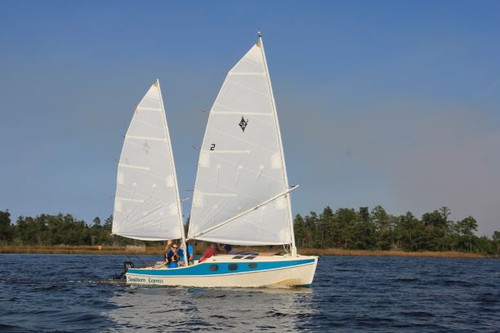
Core Sound 20 Mark 3 Plans

Study Plans: OB-20 (Instant Download)
- Places - Siberia and the Russian Far East
OMSK, NOVOSIBIRSK, TOMSK AND THE VASYUGAN MARSHES: HEART OF WESTERN SIBERIA
Western siberia.
Western Siberia has traditionally been defined as the area of land between the Ural Mountains and the Yenisei River. Much of it lies on the West Siberian Plain which is lower and slightly warmer than the higher Central Siberia Plain.
The forests are dominated by pine, spruce and fir. The hardier larch dominates on other side of the Yenisey. The large industrial cities of Yekaterinburg, Novosibirsk and Kransoyarsk are on the Trans-Siberian Railroad. Some of the most interesting area are in the Republic of Altay and Tuva near the Mongolian border.
Western Siberia is also quite swampy and has a lot of mosquitos. Ian Frazier wrote in The New Yorker, “ The country’s swampiness did not manifest itself in great expanses of water with reeds and trees in it, like the Florida Everglades. There were wide rivers and reedy places, but also birch groves and hills and yellow fields. The way you could tell you were in the swamp was, first, that the ground became impassably soggy if you walked at all far in any direction; and, second, by the mosquitoes....Western Siberia has the largest swamps in the world. In much of Siberia, the land doesn’t do much of anything besides gradually sag northward to the Arctic. The rivers of western Siberia flow so slowly that they hardly seem to move at all.” [Source: Ian Frazier, The New Yorker, August 3, 2009, Frazier is author of “Travels in Siberia” (2010)]
On driving through the region, Frazier wrote: “Beyond Yekaterinburg, the road lay straight through grain fields like Nebraska’s or Iowa’s, and the sky unfolded itself majestically outward and higher. Vistas kept appearing until the eye hardly knew what to do with them—dark-green tree lines converging at a distant yellow corner of the fields, and the lower trunks of a birch grove black as a bar code against a sunny meadow behind them, and the luminous yellows and greens of vegetables in baskets along the road, and grimy trucks with only their license numbers wiped clean, their black diesel smoke unravelling behind them across the sky.
“And everywhere the absence of fences. I couldn’t get over that. In America, almost all open country is fenced, and your eye automatically uses fence lines for reference the way a hand feels for a bannister. Here the only fenced places were the gardens in the villages and the little paddocks for animals. Also, here the road signs were fewer and had almost no bullet holes. This oddity stood out even more because the stop signs, for some reason, were exactly the same as stop signs in America: octagonal, red, and with the word “stop” on them in big white English letters. Any stop sign in such a rural place in America (let alone a stop sign written in a foreign language) would likely have a few bullet holes.”
OMSK OBLAST
Omsk Oblast covers 139,700 square kilometers (53,900 square miles), is home to about two million people and has a population density of 14 people per square kilometer. About 72 percent of the population live in urban areas.The city of Omsk is the capital and largest city, with about 1.15 million people. Omsk Oblast is home to more than 20 game reserves and attracts many people into hunting and fishing. For those interested in history, there are ancient settlements and villages, burial mounds, religious monuments and tombs and the historical sites of Chudskaya Mountain and Batakovo Tract, Website: Tourism Portal of the Omsk Region: omsk-turinfo.com
Some come to Omsk Oblast looking for Kolchak's gold. Others follow in the footsteps of the Decembrists, while others still come to see the prison camp where Dostoevsky spent several years. The climate here is sharply continental: with a warm and even hot summer, a cold long winter with the snow remaining on the ground a long time without melting. In the winter temperatures often reach -25 to -30°C; in the summer the average temperature is around 20°C. But the Siberian climate is unpredictable here and sometimes it warms up in the winter or cool spell shows up in the summer. The weather is very changeable in the winter and autumn.
Getting There: Aeroflot, Pobeda, Ural Airlines, Nordwind, and S7 airlines fly to Omsk daily from all Moscow. From St. Petersburg, one flight per day is operated by Rossiya Airlines. A one way tickets costs from 3,000 rubles. Regional traffic is developing. You can get to Omsk by direct flights from Kazan, Krasnoyarsk, Novosibirsk, Tyumen, Samara, Sochi, Irkutsk, Rostov-on-Don, Krasnodar, Surgut, Salekhard, Khanty-Mansiysk, and Novy Urengoy. Regular flights with AirAstana are also available to Nur-Sultan, the capital of Kazakhstan. By Train: Omsk is conveniently located for rail travel. The station is just outside the city center and all the main sights. A third class ticket from Moscow starts from 2,500 rubles; in second class, from 3,000 rubles. Transport in the Region: You can reach all districts of the region by buses and minibuses from the bus station; however, in certain directions, they leave from the railway station. The schedule, prices and tickets are available online: omskoblauto.ru
Omsk City (kilometer 2716 on the Trans-Siberian Railway) is an industrial city of 1.15 million people. The capital and largest city of Omsk Oblast, it is us where Dostoevsky did four years of hard labor from 1849 to 1854 and was periodically flogged. He wrote about is experienced in Buried Alive in Siberia. There is not much to see. Omsk is home to a large tank factory, a model pig farm. The Pushkin State Scientific Library contains the world’s smallest book. People can read a collection of poems through a microscope.
Omsk lies in the southern part of Western Siberia, at the confluence of the Irtysh and Om rivers, where a Cossack detachment led by Lieutenant Colonel Ivan Buchholtz landed and founded a fortress in 1716. The Omsk area was populated even before Christ and contains many settlements, burial grounds, and encampments, which date to between the 6th millennium B.C. and the A.D. 13th century. Omsk received the status of the town in 1782 and for a while after the 1917-1918 revolution was capital of White Russia. Today, the city stretches for 40 kilometers along the Irtysh River and lies on both banks of the river which is crossed by many bridges. Omski is named after the Om river. In the Siberian Tatarian language, “om” means “quiet”.
Omsk is one of the largest cities in West-Siberia and large transport hub at the intersection of air, river, rail, automobile, and pipeline transport lines. The Irtysh River, a key transport, waterway, and the Trans-Siberian Railway were key to the city's development. Currently, Omsk is the largest industrial, scientific, and cultural center of West Siberia with a high social, scientific, and manufacturing potential. Here, more than 40 organizations, including the Omsk Scientific Center of the Siberian Branch of the Russian Academy of Sciences, are engaged in research and development.
Omsk at one time was regarded as the greenest city in Russia and the theater capital of Siberia. It is the birthplace of the artist Mikhail Vrubel and the famous General Dmitry Karbyshev. City transport in Omsk includes buses, trolleybuses, trams, and minibuses. Transportation is regular up to 8:00-9:00pm.
On his brief encounter with Omsk, Ian Frazier wrote in The New Yorker: “ The next days took us to and through the city of Omsk. I had been to Omsk twice before, but only at the airport. This city presented the usual row on row of crumbling high-rise apartment buildings, tall roadside weeds, smoky traffic, and blowing dust. For a moment, we passed an oasis scene—a crowded beach beside the Irtysh River, kids running into the water and splashing—before the urban grittiness resumed. Solzhenitsyn wrote in “The Gulag Archipelago” that he spent time in an ancient prison in Omsk that had once held Dostoyevsky, and that the prison’s three-meter-thick stone walls and vaulted ceilings resembled a dungeon in a movie. I had wanted to explore Omsk looking for this prison, but forgot that idea entirely in our collective eagerness to get out of Omsk. We stopped just to buy groceries, then sped on. [Source: Ian Frazier, The New Yorker, August 10 and 17, 2009, Frazier is author of “Travels in Siberia” (2010)]
Sights in Omsk City
Sights in Omsk include the preserved house of K. A. Batyushkin, where, during the Civil War, the apartment of Admiral A. V. Kolchak was situated. The building is now occupied by the Supreme Governor of Russia. During the Russian Civil War in the late 1910s and early 1920s, Omsk was the home of three governments: 1) the Provisional Siberian Government, 2) the Provisional All-Russian Government, and the 3) Russian Government of the Supreme Governor. The are many structures left from this period when Omsk was a stronghold of the “White Guard Russia”.
Dostoevsky Literary Museum is located in the city’s historical center, in one of the oldest buildings of Omsk, constructed in 1799. Fyodor Dostoevsky, convicted of participating in the Petrashevsky circle (a group of progressive-minded intellectuals imprisoned for challenging the tsarist government), spent four years at prison camp in Omsk. Many future novels, including Crime and Punishment, were based at least in some parts on his impressions and experience while in Omsk. The museum boasts an excellent, well-thought-out exhibition dedicated to the writer, and in the basement, a reconstructed 19th century prison cell is found. You can go down there and get a taste of the hard life the prisoners of the Omsk fortress used to live, even try on the shackles.The museum occupies a building of historical importance: the Commandant’s of the Omsk Fortress House (built 1799). This house was visited by F.M. Dostoevsky. In 2006, new exhibitions — “Dostoevsky and Siberia” and “Writers of Omsk” — were opened.
Lubinsky Avenue is the main street of the city’s historical center. Here you can find and an ensemble of architectural landmarks dating back to the late 19th-early 20th centuries. All of Omsk most prominent building are found here: the Omsk Academic Drama Theater, the Jubilee Bridge over the Om, the Cadet Corps, the Concert Hall, the St. Nicholas Cossack Cathedral, the Organ Hall, the Vrubel Museum of Art, and the Hermitage-Siberia Center.
Tarsky District became a place of exile soon after the city was founded in the 18th century. The first exiled people were peasants, artisans, delinquent riflemen, tradespeople, Lithuanian war prisoners and Poles. Many of the exiles remained in Omsk after they served their time because they had nowhere else to go. Today descendants of these exiles still live here and national dishes from the exile’s places of origin can be found. Bobrovka is a place where you can try Latvian cuisine. The Latvians have been living in this village since the 19th century. However, they were not exiles, they moved there voluntarily during the Stolypin reform.
Omsk Fortress
Omsk fortress was erected in stages during the 18th-19th centuries to protect the southern borders from nomadic raids. Back in the days when Siberia was like the American Wild West, the barracks of the regiments that participated in the Patriotic War of 1812 stood there. Several surviving structures are concentrated in the fortress: the artillery store, engineering shop, treasury, Tobolsk and Irtysh gates, arsenal, kitchen/mess hall, and the Resurrection cathedral. some of them were restored in time for the city’s 300th anniversary.
History of Omsk started with the construction of the first Omsk fortress on the left bank the Om River. Peter the Great issued a decree in 1714 for Russian military forces to go deep into Siberia to find a "sandy gold" in Erkete. The man in charge of the expedition was Lieutenant Colonel Ivan D. Buchholz. After an unsuccessful campaign in 1716 two small redoubts were built at the mouth of the Om river to protect the military unit and its equipment. Then the first Omsk fortress was built in 1717. It was made of wood and covered an area of approximately six hectares. Castle defenses consisted of a three-meter-deep moat and a one-meter-high outer rampart. The main walls were comprised of 3.5-meter-high palisades dug deeply into the ground and made of tightly-placed-together birch logs. In the corners of the fortress were bastions on which the cannons and guns were positioned.
By the middle of the 18th century Omsk fortress was the focal point of the system of fortifications of the Upper-Irtysh, and later - Presnogorkoy line. However, despite the reconstruction and repair work, the fort gradually became obsolete and no longer meet the military requirements of the time. In the 1768 construction of a fortress began on the right bank of the Om. The fortress was one of the largest military facilities in the East and had a polygon plan enclosing an area of over 30 hectares. It had four bastions, three polubastiona and four gates: Omsk, Tara, Tobolsk and Irtysh. In the historical part of Omsk Tobolsk Gate survives. In 1991 Tara gate was restored and has become a kind of symbol of the city.
A distinctive feature of the new Omsk fortress were its stone structures. The first stone building, built in the fortress is now the oldest in the city. The first stone construction of Omsk was Resurrection Cathedral, founded in 1764 and built by the brothers Cherepanov. In 1920s, the church was closed by the Communists. In 1958 it was demolished.
Structures in the new Omsk fortress included a guardhouse building, which housed the commandant's staff, the fortress guards and garrisons (later Asian) school. Later a Lutheran church, topped by a wooden turret with a clock and a bell was built. At the end of the 18th century the fortress had of the parade ground, around which the architectural ensemble was situated. Among the buildings that have survived and have undergone restructuring and reconstruction, are the guardhouse building, the commandant's house (containing the Fyodor Dostoevsky Literary Museum) and the Lutheran Church (housing the ATC Museum) . All of these have been granted the status of historical and architectural monuments.
These days, buildings in the fortress house museums, art salons, workshops and exhibition spaces that host film screenings and performance and offices for staff of the historical and cultural complex. Six guided tours for groups and individual visitors are offered. Entrance to the fortress grounds is free, while a tour costs 100 rubles. A workshop where visitors can try their hand at weaving a belt with Russian spiritual pattern can be ordered for groups of 5 to 10 people. The cost is 1,000 rubles per group.
Arkhangelsk Sorority of the Holy Mother and St. Michael (60 kilometers southeast of Omsk) was founded near the Cossack village of Achair in 1905. In the late 1920s, like many monasteries, convents and churches it was closed and largely destroyed. In the 1930s, its territory became a penal colony for political prisoners and criminals, who were taken there by barges and wagons. The colony was designed for 800 to 900 people. The living conditions in the colony were very difficult: unheated barracks with very thin walls and floors, light clothes, thin cotton blankets in the -40 degree C Siberian cold. From 1938 to 1953, only one person managed to successfully escape.
A few days after Stalin's death, the colony was dissolved. Many documents were immediately destroyed and what remained of the monastery was blown up. In 1991, Theodosius, the Archbishop of Omsk and Tatarstan, announced the decision to rebuild the ensemble of Achairsky Convent of the Cross in memory of the victims of those times. Vitaliy Meshcheryakov, the director of the Rechnoy animal farm, located near Achair village, alloted 38 hectares for the construction, in memory of his father, who was a prisoner in this horrible colony. Today you can see the new Dormition Cathedral, a wooden summer church for weddings and other structures there.
Traveling Eastward from Omsk
Ian Frazier wrote in The New Yorker: “A day beyond Omsk, the vastness of the Barabinsk Steppe stretched before us. For hours at a time, the land was so empty and unmarked that it was almost possible to imagine we weren’t moving at all, and I often had trouble staying awake. Lenin himself had declared this a land “with a great future,” but what I saw resembled more the blankness of eternity. And yet it was not like other flat places I’ve seen. The Great Plains of America tend to undulate more than this steppe does, and when the Plains are flat-flat, as in southwest Texas, they’re also near-desert hardpan with only stunted brush and trees. On the Barabinsk Steppe, by contrast, stretches of real forest often appeared here and there, intruding into the flatland like the paws of a giant dog asleep just the other side of the horizon. [Source: Ian Frazier, The New Yorker, August 10 and 17, 2009, Frazier is author of “Travels in Siberia” (2010)]
“The villages now were fewer, and their names seemed to reach new levels of strangeness. In far-apart succession, we went through Klubnika (Strawberry), Sekty (Sects), and Chertokulich (hard to translate, but something like Devil Bread, according to Sergei). In the village of Kargat (meaning unknown, probably a Tatar word), we stopped for a break in the late afternoon. I sat in the van with the window open and my feet up, watching. First, a man went by on a motorcycle with a sidecar. In a few minutes, he passed by going in the other direction, with the sidecar now full of hay. A flock of sparrows burst from a cluster of bushes by the corner of a house with a noise like heavy rain. A moment later, a small hawk hopped from the bushes onto a nearby pile of firewood, looked around, hunched down, and flew off after them.
“A motorcycle again came by with its sidecar full of hay. I looked closely. It was definitely not the same as the previous motorcycle. This motorcycle’s driver was wearing an aviator’s hat with goggles, and the sidecar was blue, not brown. As I considered that, a tall, shapely woman came walking from a long distance up the road. She wore a plain dress and had curly black hair. She passed the van and I smiled at her. She did not smile back. Then a beat-up car lurched into sight towing an even more beat-up car. As the cars came near I saw that they were connected back to front by a loop made of two seat belts buckled to each other. That was the only time I ever saw a Russian use a seat belt for any purpose at all.
Lake Chany and Its Monster
Lake Chany (420 kilometers west of Novosibirsk, 300 kilometers east of Omsk) is one of the biggest lakes in the world, and the third largest in Siberia (after Baikal and Taymyr). The area of the lake exceeds 1,400 square kilometers but has a depth of only two to seven meters. The lake is almost 100 kilometers long and 60 kilometers wide. People living around the lake are convinced a monster lives in the lake. Ssome describe it as a giant lizard, while others claim it to be a giant snake. They say on numerous occasions the beast attacked the local fishermen. The easiest way to get to Lake Chany is by car.
The lake's shores are mostly covered with dense reeds. Chany consists of three lakes connected by canals: Bolshye Chany, Malye Chany, and Yarkul. Water in different parts of the lake has different levels of mineralization. In Malye Chany, where the Kargat River flows in, the water is fresh. In Bolshye Chany, it is subsaline, and in Yarkul, it is saline.
The water's composition provides it with therapeutic properties. Since the water in the lake is moderately saline, it influences the human body positively: it has a calming effect, normalizes a person's general condition, and improves a person's general physical and mental state; it also promotes purification of the body from waste and harmful substances.
The healing effect is provided not only by water, but by the air as well. The wind changes from quiet to strong and the air becomes saturated with evaporated salts and the intense scents of different herbs found on the Baraba steppe.
Lake Chany is a popular place for winter and summer fishing. Sixteen species of fish inhabit the lake: crucian carp, perch, mirror carp, ide, sander, roach, dace, bream, and others. In addition, Lake Chany is great place for birdwatching. Almost 300 species of birds live among its waters. Geese, ducks, swans, herons, cranes and even pelicans nest here. It is also home to one of the largest colonies of the common gull.
Water in the lake freezes in the second half of October or the first half of November, and unfreezes in May. There are almost 70 islands on the lake. The islands of Cheryomushkin, Kobyliy, Perekopnyi, Bekarev, Kalinova, Chinyaiha, Shipyagin, Kruglyi, Kolotov, Kamyshnyi are natural monuments and preserve unique landscapes containing rare spices of plants and animals.
NOVOSIBIRSK OBLAST
Novosibirsk Oblast covers 178,200 square kilometers (68,800 square miles), is home to about 2.8 million people and has a population density of 15 people per square kilometer. About 77 percent of the population live in urban areas. The city of Novosibirsk is the capital and largest city, with about 1.6 million people, or about 57 percent of the oblast’s population. Novosibirsk Oblast is located in the south of the West Siberian Plain between the Ob and Irtysh Rivers. The oblast borders Omsk Oblast in the west, Tomsk Oblast in the north, Kemerovo Oblast in the east, and Altai Krai and Kazakhstan in the south. The oblast extends for more than 600 kilometers (370 miles) from west to east, and for over 400 kilometers (250 miles) from north to south. The oblast is mainly plains and steppes in the south with huge expanses of forests and marshes in the north. The landscape starts its transition to a low mountain relief at Salair ridge. There are many lakes. The largest ones are located in the south. The majority of the rivers belong to the Ob basin, many of them falling into lakes with no outlets. Among the largest lakes are Chany, Sartlan and Ubinskoye.
Although Novosibirsk is the third largest city in Russia, it is not a center for tourism; most visitors come here on business. Nevertheless, there is plenty to see and do in the oblast including ski resorts, Zveroboy cliffs, Barsukovskaya Cave and Lake Karachi. The nature reserves and pine forests are great places to enjoy outdoor sports, walk, look at nature and gather mushrooms and berries. You can learn about the history of the Trans-Siberian Railway at the Museum of Railway Transport and exercise your brain in the city's Academic Town. Travel to the Ordynsky District and find out about the twists and turns of the last battle for Siberia between the Cossacks and the army of Kuchum Khan. Lake Chany is said to be the home of a Loch-Ness-like monster.. You can also visit the Bugrinsky Bridge; climb the Pikhtovy Ridge, the highest point of the region (495 meters) and go boating in vast Ob Sea.
Getting There: A flight from Moscow to Novosibirsk costs RUB 16,000 (adult round-trip ticket) and takes four hours. An economy class round-trip train ticket from Moscow for one adult costs RUB 7,000, and the journey takes from 48 to 55 hours. Novosibirsk is a stop on the Trans-Siberian Railway About ten major train routes from different directions go through Novosibirsk, including Moscow-Vladivostok and Moscow- Beijing. Transport in the Region: Buses from Novosibirsk bus station go to all major cities and districts of Novosibirsk Oblast, as well as many places in nearby regions. A Round-trip bus tickets to Tomsk costs RUB 1,520 per adult; a ticket to Barnaul costs RUB 1,300 (round-trip, per adult);, and a ticket to Kemerovo is RUB 2,000 (round-trip, per adult).
Novosibirsk City
Novosibirsk (kilometer 3343 on the Trans-Siberian Railway) is the largest city in Siberia and the third largest in Russia, with 1.6 million people. Located where the Trans-Siberian Railway crosses the mighty Ob River and founded in 1893, it grew into an important city in the 1920s when it became a major transport center and expanded greatly in World War II, when weapons factories were located there out of range of Nazi attacks. More than 50 defense plants were rebuilt in Novosbrink.
An industrial city about halfway between the Urals and Lake Baikal, Novosibirsk is the capital of Novosibirsk oblast, with about 57 percent of the oblast’s population living there. Just over a century ago it was a village with less than 700 people. No other place in Russia has experienced such astounding growth in such a short period of time. Novosibirsk is situated on the Priobskoe plateau near a reservoir, which is officially called Novosibirsk reservoir but is more commonly known as the Ob Sea. The right-bank part of Novosibirsk features many ravines, low ridges, and gullies.
Novosibirsk is a scientific, cultural, industrial, transportation, trade and business center of Siberia. It is the largest industrial center in Siberia, and a rail, river, and air transportation hub. The Siberian branch of the world-famous Academy of Science is located here. The huge railway station of the city, one of the largest in the country, has become a symbol of Novosibirsk, along with the letters on its roof which say: “Novosibirsk the Main”.
History of Novosibirsk
The first Russian settlement in the territory of modern Novosibirsk dates back to the last decade of the 17th century the beginning of Peter the Great's rule. At that time the village Krivoshchekovskaya (“Crooked Cheek”) was set up. It is named after a serviceman from Tomsk, Fyodor Krenitsyn, dubbed Crooked Cheek for the saber scar on his face.
At least until 1712, Krivoshchekovskaya acted as a trade center between the Russians and the Teleuts, who owned the lands on the other side of the Ob River. The settlement in the territory of modern Novosibirsk developed at various rates in different areas. The Russian colonialists preferred to settle on the left bank. By the end of the 18th century, this area was completely populated by Russians as most of the Teleuts had left. A Teleut fortress of one of the tribes and a few tribesmen remained they were subordinate to the Russians. Russian people called them the Chuts and, probably, did not really like them, as they only settled on the left shore.
Novosibirsk was known as Novonikolayevsk when it was formally founded in 1896. It was renamed Novosibirsk in 1925. The became a trade center during the building of the Trans-Siberian Railroad and after it was completed. During World War II entire industrial plants were moved here from area vulnerable to Nazi attacks in the western Soviet Union.
Accommodation in Novosibirsk
Novosibirsk is considered to be the capital of Siberia — naturally, the hotels here also meet the standards of a capital city. For example, the 4-star Doubletree Hilton Novosibirsk offers its visitors a variety of facilities, including a gym, business center, swimming pool, spa, restaurant and a bar, as well as a seven-room conference center. A room with a king size bed goes for RUB 11,000 per night. A Junior Suite with king size bed costs RUB 14,990 per night. The Presidential Suite is RUB 39,750 per night.
If you've arrived here by train you can find the 4-star Marins Park Hotel Novosibirsk just 300 meters away form the station. Standard room with a king-size bed costs RUB 2300 per night. A luxury suite costs RUB 7830 per night. In addition, female visitors might be interested in the hotel's beauty salon, while men can enjoy its snooker and pool club.
Hostels in Novosibirsk: BigBen has rooms for RUB 550 per night and a places in a room with four people in bunk beds for RUB 300 per night; At FunKey Hostel you can stay in a room for four people with bunk beds for RUB 500 per night, room for two people for RUB 1,600 per night.
Sights in Novosibirsk
Novosbirisk is not an old city. It was founded only in 1893. There are not many churches or old buildings and it has a very Soviet atmosphere. And, although Novosibirsk is the third largest city in Russia, it is not a center for tourism; most visitors come here on business. But that doesn’t mean there is nothing to see or do. Novosbirisk is home of the largest zoo in Russia and a large number of museums and theaters. The city boasts the largest Scientific and Technical Library and the largest railway station in Siberia. Among the places of interesti are a local studies museum, an art gallery, the Russian Institute of Archeology and Ethnography, Alexandre Nevsky Cathedral, recently restored and returning to working status, and the Central Park.
Probably the most famous feature of the city is Academgorodok (“the Academic City”), a place with relatively small area where more than twenty scientific and educational institutions are located. Cafe-club “Under the Integral” of Academgorodok has become one of the symbols of the “Khrushchev thaw”: for example, it is here that Alexander Galich had his only public concert in the U.S.S.R. The Pazyryk lady — one of the greatest archaeological finds in Russia — is (or was) displayed at the Russian Institute of Archeology and Ethnography The central market draws traders from all over Siberia.
Novosibirsk was built according to a preconceived plan, as were its main architectural landmarks. The main street is Krasny Avenue (former Nikolaevskiy Avenue). If the city's opera house seemed huge to you, you are right —it is the largest theater building of the former U.S.S.R. If you are feeling something Parisian in the city's landscape, it means you are walking past the 100-Flat Building (Krasny Prospekt 16). You will find wooden merchant mansions, red-brick houses from the years of Trans-Siberian Railway construction and even an example of the contemporary 21st century architecture — the unusual “walking” building of the Center of Information Technology.
Alexander Nevsky Cathedral (on Krasny Avenue) is the grandest church in Novosibirsk. It honors honors St. Duke Alexander Nevsky, the 13th century defender of the Russian Land. It is the first city’s stone church and one of the first stone buildings in Novosibirsk, In 1896 Tsar Nicholas II granted a piece of land for the construction of the cathedral and donated 5000 rubles to the cathedral construction and 6500 rubles to the iconostasis. In 1899 Nicholas II gave priest and diacon vestments, made of precious gold brocade, which had covered the coffin of the Grand Duke George Alexandrovich. He also donated to the cathedral icons of the Athos letter: the Iverskaya Icon of the Mother of God and the Icon of the Great-Martyr and Healer Panteleimon.
Novosibirsk State Academic Opera and Ballet Theater
The Novosibirsk State Academic Opera and Ballet Theater building is the largest theater building in the former Soviet Union. It required complicated architectural techniques to build. The most unique part of the building is its dome, which 60 meters in diameter and 35 meters high but only 8 centimeters thick. This dome was the first in Europe to be constructed without girders or buttresses. The roof of the dome is covered with thousands of silvery tiles that contributes in overall splendid appearance of the Theater. One cannot visit the main square of the city without being delighted with The Novosibirsk State Academic Opera and Ballet Theater.
Founded in May 12, 1945, and nicknamed “A Peer of the Victory” (as it opened when World War II was finally ending), the theater has hosted about 350 premieres and capital reconstruction of classical opera and ballet productions since 1945. Classical opera and ballet performances forms the basis of its repertoire but at the same time “The Siberian Coliseum” is at the cutting edge of modern theater life, ready to offer you modern up-to-date performances. The Novosibirsk State Academic Opera and Ballet Theater took part in global international projects implemented under the auspices of UNESCO.
The Novosibirsk State Academic Opera and Ballet Theater company is (was) so good it has been called the "Bolshoi of Siberia". During foreign tours the ballet and opera company successfully performed such productions as: “The Sleeping Beauty”, “The Nutcracker”, “Swan Lake”, “Spartacus”, “Legend of Love”, “Carmen”, “Boris Godunov”, “Prince Igor”, “Khovanschina”, “Dame Pique”, “Otello”, “Galka”, “Tosca” and many others. The leading opera and ballet soloists are often invited to foreign tours. Some of the performances in Novosibirsk feature foreign or non-company actors and dancers.
Theaters in Novosbirisk
It has been said that Novosbirisk has to keep its large population entertained, especially when you considers what a long winter the city’s residents have to endure, and that is why there are so many theater, opera and ballet companies in the city.
Among the theaters in Novosbirisk are: 1) Novosibirsk Drama Theater Red Torch founded in 1920 in Odessa by a group of young actors and relocated in Novosbirisk in 1932; 2) Novosibirsk City Drama Theater, stringly influenced by its longtime author, founder and artistic director Sergey Afanasiev; 3) Novosibirsk State Drama Theater Old House, whose repertoire is primarily classical texts but also with ultra-modern stagings; 4) Theater La Pushkin, which opened under Oleg Zhukovsky in 1999 in Dresden and came to Novosibirsk in 2013.
Youth and Puppet Theaters include: 1) Novosibirsk Academic Youth Theater Globus, the largest center in Siberia for the aesthetic and spiritual education of children and youth; 2) Novosibirsk Youth Theater Drama, founded in 2008. 3) Novosibirsk Regional Puppet Theater, opened in 1934 and today has a repertoire of more than 25 performances and is often on tour; and 4) Puppet Theater Cdc Them. Stanislavsky, opened in 2011.
Among the music oriented theaters are: 1) the Novosibirsk State Academic Opera and Ballet Theater (See Above); and 2) the Novosibirsk Musical Theater, opened in 1959 and now regarded as one of Russia's leading musical
Among the modern and avant garde theaters are Theater A Clockwork Orange, founded in 1997 by a group of leading actors of the academic theaters Red Torch and the Globe; 2) Theater Company Akademgorodok, featuring audience stories that actors create on the spot with no rehearsed roles, or even stage design; 3) Studio Theater The First House, established in 2008 by graduates of Novosibirsk State Theater Institute in 2008; 4) City Drama Theater On the Edge, located on city’s outskirts and found in 2005; and 5) Novosibirsk City Drama Theater On the Left Bank, one of the youngest theater collectives of Novosibirsk; created in 1997.
Museum of Death
The Museum of World Funeral Culture (unofficially known as The Museum of Death), was established by Sergei Yakushkin, the founder of the Novosibirsk crematorium. The museum's collection includes 19th century mourning dresses, hearse models, as well as engravings, paintings, sculptures, photos and postcards depicting death and funerals.
The museum collection numbers more than 1 million items, which are divided into collections on various topics, including the world's largest collection of postcards on the theme of death, which includes copies from the late 19th- early 20th century. There are also death masks, family memorials, exclusive funerary urns, coffins, copies of famous historical figures, paintings, sculptures, photographs, old books, household items and much more.
Of particular interest are: 1) unique mourning outfits from the 19th-20th centuries, which are annually used in the funeral parade of fashion in the museum and outside it; 2) a collection of old prints of famous Russian and foreign engravers; 3) works on the themes of death, mourning ceremonies, funerals of famous people; and 4) funeral carriages and hearses, including classic American ones from the 20th-21st centuries The history of funeral vehicles can be clearly traced back to the exhibits presented in the museum. There are the models made to scale, and actual samples.
Museum of World Funeral Culture is Russia's only museum of this kind. It is located in the Park o Memories of the Novosibirsk crematorium in the village of Sunrise in Novosibirsk region. The museum is part of the International Association of Museums of death and included in the program of conservation of world heritage funeral culture at UNESCO. Many visitors claim this museum has made them appreciate their life more. Address: Sunrise, st. Voentorgovskaya 4/16 Hours: 11:00am to 7:00pm; Closed: Monday; Phones:+7 (383) 363-03-29; + 7-913-712-3709 Entrance ticket prices can be found on the museum's website:musei-smerti.ru.
Novosibirsk Zoo and Aquarium
Novosibirsk Zoo is one said to be the biggest zoo in Russia. Spread over 65 hectares, it is home to home to 11,000 animals and birds in of landscapes ranging from African savannah to Arctic sea ice. About a half of the animal species found here are rare. Among these are tree-dwelling prehensile-tailed porcupines from South America; rusty-spotted cats from Southeast Asia; miniature dik-dik antelopes; and red flamingos. The zoo is open from 9:00am to 7:00pm. The entrance ticket prices are RUB 300 (for an adult ticket) and RUB 150 (for a reduced-fare ticket)
The Center of Oceanography and Marine Biology “Delfinia” is a unique facility for Siberia: a a large-scale aquarium in the middle of an industrial city in the taiga far from the seas and oceans and operates all year round. The halls of the complex cover more than 8000 square meters and its pools, basins and aquariums hold about 2.7 million liters of water. “Delphinia” can accommodate up to 650 spectators at once. It unique dome, which allows natural light in, helping to warm the place even on the coldest days.
Pacific bottlenose dolphins, white beluga whales, belugas, South American sea lions and the Pacific walrus perform for spectators. Also, along with performances of dolphins and sea animals, there is the aquarium with a tunnel that passes through the aquarium. The facility has 28 aquariums. There are more than 300 species of fish and marine animals, such as moray eels, stingrays, sharks and other inhabitants of seas and oceans.
History and Architecture Open Air Museum
Institute of Archeology and Ethnography of the Siberian Branch of the Russian Academy of Sciences (near Novosibirsk State University) opened in 1981. The first architectural object was the bell tower of the church from the polar city of Zashiversk, brought to Akademgorodok in 1969 as a result of the Institute expedition. The church itself was transported in 1971. The IAESB of the RAS museum covers the area of 46.5 hectares. Several recreational zones and archaeological, ethnographic, architectural monuments and an experimental site are located on it. Another exhibition is housed in the administrative building.
The central exhibit in the architectural monument area is the masterpiece of Russian wooden architecture, the Church of the Increate Savior from the Zashiverski Ostrog, built by the philistine Andrei Khabarov in 1700. The monument was donated to the Siberian Branch of the Academy of Sciences of the U.S.S.R. by the government of the Yakut Autonomous Soviet Socialist Republic and was transported from the banks of the Indigirka River.
The Yuil (Kazym) jail, a monument to the era of the Siberian development by the Russian population, from the Lower Ob region is partly exhibited on the museum territory. The third architectural object is the peasant household of Russian Eastern Siberia. There's a separate archaeological zone, where stone steles and statues of various eras, from the Paleolithic to the Middle Ages, are represented. A polygon with the reconstructions of tools and devices for catching animals and hunting is located in the zone as well. The ethnographic zone is a reconstruction of the Mansi family shrine.
In 2012, after the construction of the administrative building, an exhibition dedicated to the culture of the Slavic population of Siberia was opened on the second floor. The commissioning of the administrative building allowed conducting master classes and mass events.
Near Novosibirsk
Travel agencies offers one-day and overnight cross-country ski outings in the region during the winter, picnics during the summer and trips to Russian bathhouse where you get to whack yourself with birch boughs and everything, year round. Novosbirisk is a jumping place for trips in the Altay Mountains, Kazakhstan and Central Asia. The 1,442-kilometer Turkestan-Siberia Railway to Alma Ata branches off here.
Big Horde Ring Tours (70 kilometers southwest of Novosibirsk) are tours organized in Ordynsky District. The Ordynskoye Koltso (The Horde Ring) is a chain of local historical and cultural landmarks that includes: 1) the site of the Battle of Irmen (August 20, 1598), the last battle for Siberia between the Cossacks and the army of Kuchum Khan; 2) the church in the village of Chingis, reconstructed on the site of the original consecrated in 1756, featuring unique murals made of colored clay rather than not with paints. The tours cost RUB 1,500–2,000 per one person.
Akademgorodok
Akademgorodok (32 kilometers south Novosibirsk) means "Academic City". Founded in 1958, it is a former center of military research that attracted the best and brightest scientist from all over Russia and put them to work designing atomic bombs, sophisticated missile systems and other weapons and defensive systems.
During the Soviet era, the scientists enjoyed high salaries and many perks. They came up with grand schemes like using nuclear bombs to dig canals and changing the courses of rivers that "wastefully" flowed into the Arctic Ocean.
After the collapse of the Soviet Union, Akademgorodok fell on hard times. Scientist suddenly found themselves without wages and goals. Some where paid by the United States to keep from revealing weapons secrets to Iran and Iraq. In the 2000s, the research center was reborn as "Silicon Taiga," the home of 120,000 people and many computer, software and Internet firms.
Akademgorodok is a pleasant place full of terraces and well planned neighborhoods. One of the main gathering places is the "Ob Sea," a 200 square kilometer reservoir that is used for swimming and boating in the summer and skating and fishing in the winter. Thee is also a variety of museums.
Heading East from Novosibirsk
Ian Frazier wrote in The New Yorker: ““Ravens and Crows—For weeks as we drove, flocks of ravens and hooded crows remained a constant, ubiquitous in western Siberia no less than in St. Petersburg. The birds are easy to tell apart, because the ravens are all black, the hooded crows black and gray. On the Barabinsk Steppe, both kinds sometimes wheeled in great numbers that vivified the blank sky above the wide-open horizon. Past the city of Novosibirsk, however, it suddenly occurred to me that although I was still seeing ravens, I hadn’t seen any hooded crows for a while. I began keeping a special watch for them, and did see a few stragglers. But after another few hundred kilometers no more hooded crows appeared. [Source: Ian Frazier, The New Yorker, August 10 and 17, 2009, Frazier is author of “Travels in Siberia” (2010) ]
“Prisons—Sometimes I caught a glimpse of a prison, but invariably it went by too fast. Prisons cropped up in unexpected places on the outskirts of a city. Suddenly, I’d see a guard in boots carrying a machine gun and standing on a catwalk directly above an exercise yard. But always, it seemed, we were in traffic and couldn’t stop. Outside Novosibirsk, I saw derelict guard towers, tumbledown buildings, and drooping barbed wire in a broad, open place beside the road. Whenever I pointed to such a site, Sergei and Volodya would say, “Military,” without even turning their heads. My ongoing search for prisons did not sit well with either of them. After a while, I decided that pursuing it too much was impolite, and I let it drop for the time being.
“Pigs—Although roaming herds of pigs were occasional in villages in western Siberia, east of Novosibirsk they became more common. Now every village we went through seemed to have big gangs of them. Because the weather was so hot, the pigs had generally been wallowing in a mudhole just before they got up to amble wherever we happened to see them ambling. Evidently, the wallowing technique of some pigs involved lying with just one side of themselves in the mud. This produced two-tone animals—pigs that were half wet, shiny brown mud, and half pink, relatively unsoiled original pig. The effect was striking—sort of harlequin. The other animals that roamed the villages in groups were geese. When a herd of pigs came face to face with a flock of geese, an unholy racket of grunting and gabbling would ensue. I wondered if the villagers ever got tired of the noise. Whether challenging pigs or not, the village geese seemed to gabble and yak and hiss non-stop. The pigs grunted and oinked almost as much, but always at some point the whole herd of pigs would suddenly fall silent, and their megaphone-shaped ears would go up, and for half a minute every pig would listen.
“Birthplace of Volodya—About a half-day past Novosibirsk, we passed close by a town called Yashkino. Seeing it on our road map, Volodya remarked that he had been born there. His mother’s people were originally from this area, he said. His father, a tank officer who had been stationed in the Far East at the end of the war, had met his mother while crossing Siberia on his way back to western Russia. Volodya was still a baby when he and his parents left Yashkino, so he had no memory of it; no relatives he knew of still lived there. He felt no need to go there.
“Cottage Cheese—Called tvorog in Russian, this was a favorite lunch of Volodya’s and Sergei’s. Usually it could be obtained in very fresh supply from the grannies along the road. Sergei and Volodya especially liked their tvorog drenched in smetana (“sour cream”). I got to like it that way, too. Once or twice, we had tvorog so smetanoi not only for lunch but for a snack later in the day. The only drawback to this diet was that it made us smell like babies. And as we were able to bathe only infrequently our basic aroma became that of grownup, dusty, sweaty babies: the summertime smell of Mongols, in other words.
“Talk Radio—There is talk radio in Russia just as in America, and call-in radio shows, and “shock jock” hosts who say outlandish things. Sergei and Volodya enjoyed listening to these shows sometimes. Usually I understood nothing that was said on the radio, except for one time when the host told a joke that Sergei and Volodya both laughed at. I picked out the word “Amerikantsi,” so I knew the joke was about Americans. I asked them to tell me the joke, but they wouldn’t. I kept bugging them, but Sergei said the joke was not important. Finally, when he was off doing something in the campsite, I asked Volodya about the joke again, and he told it to me. The joke was: “Why do American men want to be present when their wives are in childbirth?” Answer: “Because maybe they weren’t present during conception.”
Ob River (flowing northeast of Novosibirsk and Tomsk) is the forth longest river in the world if you include its major tributary the Irtysh River and the seventh longest without it. The westernmost of three great rivers of Asiatic Russia, the Ob is 3,650 kilometers (2,270 miles) long and is an important commercial waterway that transports goods back and forth between the Trans-Siberian Railway and the resource rich regions of northern Siberia. Since it is frozen over half the year activity on the river is concentrated mostly in the summer months. The Ob-Irtysh is over 5570 kilometers (3461 miles) long
The Ob and the Irtysh River begin in the Altay Mountains, a range located near where Russia, China, Kazakhstan and Mongolia all come together, and flow northward. Although the Ob and the Irtysh begin at points within a couple of hundred miles of one another the two rivers don't join until the Irytysh has traveled over 1,600 kilometers (1000 miles). Once the two rivers have dropped down out of the highlands the meander lazily through open steppes, then rich farmland, and meet in flat, swampy plains, where the width of river ranges between a half a kilometer and a kilometer and a half. The Ob then passes through fir and spruce forests of West Siberia, then through Arctic tundra before finally emptying into the Kara Sea, an arm of the Arctic Ocean.
The Ob is one of the great Asiatic Russian rivers (the Yenisei and the Lena are the other two). According to the Guinness Book of World Records, it has the longest estuary (550 miles long and up to 50 miles wide) and is widest river that freezes solid. The mouth of the river on the Arctic Ocean is ice free only a couple of months a year. Huge flood sometimes form in the spring when high waters fed by melting snow and ice meet still frozen section of the river.
The main city on the Ob is Novosibirsk. Parts of the Ob are very polluted and nearly void of life. At the mouth of the river so much land has been degraded by gas exploration that huge chunks of permafrost land have literally melted into the sea. [Source: Robert Paul Jordan, National Geographic, February 1978, ♬]
Traveling on the Ob and Irtysh Rivers
There is a regualr ferry the Ob and Irtysh Rivers that travels between Omsk – Tobolsk – Khanty-Mansiysk – Berezovo and Salekhard (Yamal Nenets Autonomous Region). Omsk and Tobolsk both have train stations on the Trans-Siberian Railway. Khanti-Mansiysk is accessible by bus from Tyumen, which has a train station. After Khanti-Mansiysk you are beyond the road network. As well as the major stops listed on the route above, the boat also stops at plenty of isolated indigenous villages in between them. Salekhard is the only city in the world located exactly on the Arctic Circle.
The name of the ferry is the Rodina. It travels three times a month in June and September and four times a month in July and August. Going from Salekhard to Omsk: Day 1): departs Salekhard at 5:00pm; Dat 2) stops at Berezovo for 30 minutes ay 7:30pm; Day 3) stops at Oktobraskaya Market for one hour. Day 4) stops at Khanty-Mansiysk for two hours at 8:00am; Day 6) one hour stop in Tobolsk at 7:30. Day 9) arrive in Omsk at 3:00pm. Traveling the other direction, with the current, takes one third less time.
On the Salekhard - Tobolsk - Omsk trip on person posted on Lonely Planet’s Thorn Tree forum in 2013: “I'll start by saying that this boat is amazingly good value for money. Here some example prices. The first is for beds in the common area, similar to platzkart on the train, the second is for a bed in a private 4-, 6-, or 8 bed cabin and the third is for a bed in a private 2 bed cabin. 1) Salekhard - Omsk (8 days): 1162 / 1437 / 3926 roubles; 2) Salekhard - Tobolsk (5 days): 774 / 969 / 2632 roubles; 3) Tobolsk - Khanty-Mansiysk (2 days): 429 / 526 / 1394 roubles. Children go half price!
“Tickets can be bought in advance at the airport in Salekhard or on the boat itself an hour before departure (it's apparently never full). Most people get off at one of the stops in the first 24 hours when going south from Salekhard, leaving only one or two people in most of the cabins for most of the route. The beds are comfortable , both longer and wider than on trains. Everything is cleaned several times a day, there's a shower, laundry, restaurant with simple but tasty meals and alcohol. Breakfast about 70 roubles, lunch and dinner 150 - 300, beer 50 - 80, wine, vodka and so on also available. Theres also a small room where films are shown starting in the afternoon and a shop selling all sorts of useful stuff such as toiletries, mugs, books.
“You can walk around on deck as much as you want or sit and read a book on the benches up there. The scenery is more or less the same all the way - endless taiga forest with absolutely no sign of civilisation. There are a few villages such as Pitlyar for which the boat is their only access to the outside world and a couple of towns where you can get off the boat and walk around - Beryozovo 24 hours after Salekhard and Khanty-Manskiysk 3 days from Salekhard. From Khanty Mansiysk there are regular buses to Tyumen on the Trans Siberian which take 8 hours. At Tobolsk the boat stops next to the stunning kremlin, the only one in Siberia.
“Anyone can freely sail the whole route between Omsk and Pitlyar, a small village of 500 and the last stop before Salekhard. Salekhard and areas north are closed to outsiders, Russian or otherwise, unless they get a temporary permit. See the Yamal Peninsula link in my signature line for how to get this permit. Permit in hand, you can continue the journey north from Salekhard a further two days to Antipayuta, well beyond the Arctic Circle, with a similar level of comfort and price.
“It sails the whole route from June to September and once in October from Khanty-Mansiysk to Omsk. Check www.irsc.ru for timetables and fares. Only about half the boats from Salekhard go as far as Omsk, the rest stopping in Tobolsk. Eg in July and August, the most frequent sailing months, 6 boats go from Salekhard - Tobolsk each month but only 3 continue to Omsk. Check the timetable carefully when planning if you want to sail all the way to Omsk!”
TOMSK OBLAST
Tomsk Oblast is situated in the heart of Western Siberia and, some say, is the best place to experience real Siberian nature: the endless taiga forests, rivers, lakes and swamps. It covers 316,900 square kilometers (122,400 square miles), is home to about 1 million people and has a population density of only 3.3 people per square kilometer. About 70 percent of the population live in urban areas. The city of Tomsk is the capital and largest city, with about 525,000 people. Website: The Tourist Portal of Tomsk Oblast: travel-tomsk.ru
Attractions include unique museums, fun festivals, fishing, hunting, and folk crafts. The region has a rich intellectual tradition: Tomsk contains the oldest university in Siberia. If you have the time take a flight to the remote, isolated towns of Strezhevoy and Kedrovy to see the unusual lifestyle of the people there. For adventure head off into the taiga or penetrate the Vasyugan marshes. Pine nuts are the oblast’s symbol. There are many fine examples of Siberian wooden architecture.
Getting There: A round-trip air ticket from Moscow to Tomsk costs about RUB 23,000. The travel time is 4 hours 30 minutes. A branch off the Trans-Siberian Railway reaches Tomsk. A ticket for express train No. 038N from Moscow to Tomsk will run you RUB 11,000 for a round trip in third class. The one-way travel time is 54 hours 40 minutes. When flying from Saint-Petersburg to Tomsk, you will have to make a transfer in Moscow. The travel time is seven and a half to eight hours. A round trip costs you ca. RUB 30,000. If you decided to take a train from St. Petersburg, you’ll need to transfer in Moscow, Novosibirsk or Vladimir. A third class round trip ticket will set you back about RUB 15,000. The travel time is up to 60 hours.
Transport in the Region: Some of the districts of the Tomsk region are in remote areas, accessible only by air or water. Tomsk airport offers flights to the towns of Strezhevoy and Kedrovy. The historic village of Narym, known from 1598, can be reached by water in the summer, on a snow road in the winter, or by air in autumn and spring.
Tomsk (170 miles northeast of Novosibirsk, kilometers 3771 on the Trans-Siberian at Taiga is where you catch the branch line to Tomsk) is one of Siberia's oldest cities. Founded in 1604, it went into decline when it was by bypassed by the Trans-Siberian Railway, but was later reborn as a nuclear research facility. The city and oblast is named after the Tom River which flows through the city.
Tomsk is the capital and largest city ot Tomsk oblast , with about 525,000 people. It is home to several universities, an active academic community and many old wooden houses. There is a fine arts and local studies museum, a botanical garden, a Polish cathedral and the SS Peter and Paul Cathedral.
Tomsk is regarded as the educational, scientific and entrepreneurial center of Siberia, and also maintains the title of historic city. More than 100 monuments of wooden architecture of the 18th-19th centuries are preserved here, more than 700 houses are included in the program of preservation of a unique architectural landscape. At the same time, a special technical and innovation type economic zone operates in Tomsk. Large scientific forums and conferences are regularly held here.
Accommodation: There is a wide range of hotels to suite a range of tastes and budgets.The Scandinavia four-star hotel at Mikushina street, 12, boasts excellent location and rooms from a basic single standard (RUB 3,325 a night) to luxury (RUB 9,025). The hotel has a restaurant and a laundry room. Transfers are available for visitors on arrival or departure. Guided tours can be booked in the hotel with English-speaking guides available. The Gogol Hotel at Gogol street, 36A is a small hotel with only 24 rooms in downtown Tomsk. The prices range from RUB 3,600 for a basic room to RUB 8,000 for a premium suite. The hotel boasts a sauna, a Turkish bath and a steam room. Hostel prices in Tomsk begin from 480 rubles, although the amenities will naturally be very basic at this rate. Apartments can be rented from 1,500 rubles per day.
History of Tomsk
The history of the city of Tomsk begins in 1604, with Tsar Boris Godunov giving the order “to put the city in a strong place”. In the spring of 1604 the Cossacks, led by V. Tyrkov and G. Pisemsky, arrived on the territory of present-day Tomsk with the order to establish a military fortress and settlement here. It was decided to put a prison on the right bank of the Tom river, as this place was protected on its three sides by nature: by bogs, a river and a steep precipice. The ledge, on which the prison was placed, was later called the Resurrection Mountain. In the 17th century, Tomsk was the most important strategic military center of Siberia and withstood attacks by nomads and hostile tribes.
In the 18th century, the borders of the Russian state moved closer to the north and east, the nomadic raids ceased and Tomsk lost its importance as the military center of Siberia. From the middle of the 18th century, Tomsk became a place of exiles. Many streets in Tomsk are named after the exiles: the disgraced writer A.N. Radishchev, Decembrist G.N. Batenkov, and the ideologist of anarchist M.A. Bakunin.
After 1804, when Tomsk was chosen as the administrative center of the new province, the first stone buildings began to appear, churches were built, and an administrative center of the city was formed. Around this time more than 25,000 people lived in Tomsk. From the middle of the 19th century, Tomsk began to grow and develop rapidly. Thanks to the gold mines discovered in the Tomsk area, many hotels, shops, and, along with them, mansions of wealthy merchants, were built. By the 19th century, Tomsk, was a major trade center, a role that was affirmed when a railway line reached the city in 1896.
In 1888, Siberia Imperial Tomsk University (now Tomsk State University) opened in Tomsk, which still attracts thousands of students throughout Russia and the CIS countries. The first technical university in Trans-Urals, now known as the Tomsk Polytechnic University, opened soon afterwards. Around this time the first theater was organized, three public libraries opened and the Department of the Russian Musical Society was launched. Tomsk suffered during the period of the 1917 Revolution and the Civil War. Afterwards it went decline as began moving to the fast-growing Novosibirsk.
During World War II, about 30 enterprises were transferred from the European part of Russia to Tomsk, which kicked off the city’s industrial development. After the war, the city got a second wind. In the 1960s, Tomsk industry begins to grow and the city became a major scientific center and attention was paid to the architecture of the city.
Tomsk, Nuclear Weapons and Contamination
In the Cold War era, Tomsk was a secret city. It was one of the main nuclear weapons sites in the Urals and Siberia. Plutonium production and weapons-grade uranium enrichment and processing was carried out there. It is considered one of the three most potentially dangerous nuclear sites in Russia.
Nuclear reactors used to create weapons-grade plutonium outside Tomsk were connected to the city by four steel pipes, each 4 feet in diameter, that carried steam from the reactors 19 miles away to heat apartments and homes in the nine-month winter. The city depended on the reactors for about a forth of its heat.
In 1993, a 9,246-gallon tank full of plutonium and uranium exploded at the Tomsk-7 nuclear installation. A northwest wind blew radioactive material to nearby villages and towns. After the disaster radioactive material began being injected into the earth
Sights in Tomsk
In Tomsk, be sure to take a walk through the old city, among the red-brick merchant mansions and wooden houses adorned with lacy carving. After that maybe check out the university areas. Tomsk, a small city compared to, say, Moscow, has ten large higher education institutions. As a result, a quarter of the locals are students. Every year university graduates cover the boots of the monument to Sergei Kirov in bright paint, scarlet or yellow. Back in his day, the famous revolutionary studied at the local university, also engaging in clandestine activities under the “Serge” alias. In 2016, Kirov was painted to resemble Superman with his red boots and blue overalls.
Tomsk is a city with a great sense of humor. Only here you can find a monument to the Lover, a fat man in baggy underwear clinging onto a window sill of the house on Bakunin street, 3. On the quay another well-known monument shows Chekhov drunk in a ditch. Why is Tomsk’s Chekhov depicted like that? Ask the locals when you’re in Tomsk. On Shevchenko, 19/1, you can find a bronze caste of the Wolf who muttered: “Gonna sing now!”
Tomsk Regional Art Museum contains paintings by famous Russian and Soviet masters such as Orest Kiprensky, Valentin Serov, Vasily Tropinin, Boris Kustodiev, and Georgy Choros-Gurkin as well as European art with masterpieces by such artists as David Teners, Jr. (17th century) and a collection of icons from different eras starting with 17th century.
Mansion of the Merchant Golovanov (intersection of Soldier (now Krasnoarmeyskaya) and Yarlykovskoy (now Kartashov)) is surrounded by towering pine trees and has a octagonal tower with a spire topped with a tent. Also known as the Russian-German House and built in 1902, it is the former house of the Tomsk merchant G.M. Golovanov,. The facades have decorative elements that bring to mind smooth terrain forms of different conifers and deciduous trees. And this blends with the silhouette of the main tent and the surrounding firs and pines.
“2+Ku” (Two plus Dolls) is the name of the theater, conceived and created by Vladimir Zakharov, a Tomsk master puppeteer who helped adults and children alike explore the real world through a fairy tale. In 2004, for the 400th anniversary of Tomsk, the theater — also known as the Theater of Living Dolls — moved into its own building, a wooden house resembling a fairy tale outside and inside. In 2019, Zakharov died in a fire. But the theater is still active. These days, its repertoire consists of twelve plays for children and adults.
NKVD Museum
Tomsk Memorial NKVD Prison Museum is housed in the former prison of the Tomsk Municipal Department of the Joint State Political Directorate-NKVD. The building was constructed in 1864-1866. From 1923 to 1944, it basements housed the internal prison of the Tomsk OGPU-NKVD department
Established in 1989, the Tomsk Memorial NKVD Prison Museum was the first museum of the history of political repressions to appear in the post-Soviet landscape. It’s aim is keeping the memory of the many thousands of people who were held here against their will. The former prison courtyard is now Remembrance Square, with memorials to repressed Kalmyks, Poles, Estonians and Latvians. The museum is not for the faint of heart. Still, you should visit. If for nothing else but to understand what suppression of reason and hope that everything will eventually work itself out entail.
The permanent exhibition of the museum includes a renovated jail corridor, a detainee cell, and the interior of an investigator's office. In the four halls of the museum (former cells), the permanent exhibitions are arranged: The Chronicle of Repressions in Tomsk region; the Great Terror; Execution Quest; Kolpashevsky Yar; and The Gulag and Narym krai Settlers. The halls also contain stands with biographical materials and copies of documents of poet N.A. Klyuev, philosopher and linguist G.G. Shtepp, geologist and soil scientist R.S. Ilyin, duke meters.M. Dolgorukov, and others.
Among the exhibits are original documents, copies of investigation files, letters and notes from prisons, personal belongings of repressed Tomsk oblast citizens, as well as everyday items made by prisoners in prison camps and exile. Nobel Prize winning author Alexander Solzhenitsyn was the first honorable visitor of the museum. He visited Tomsk in 1994 when returning home from exile. The first exhibition was opened for visitors in 1995.
The museum operates as an interregional Siberian museum and historical resource and information center. It has an electronic database with information about more than 200,000 people who endured the suffering and hardships due to the activities of the Cheka, NKVD troikas, de-kulakization, and mass deportations of peoples in Tomsk oblast.
Adjacent to the building is Memory Square, where there is a monument to the victims of Bolshevik terror in the Tomsk region and other memorials dedicated to repressed peoples: Kalmyks, Poles, Estonians, and Lithuanians. “Memory watches,” requiem concerts, the lighting of memorial candles and other activities take place on the square every year. The Museum and the Square are a single memorial complex that has become one of the most visited sites in Tomsk.
Museum of Wooden Architecture and Okolitsa Park
Museum of Wooden Architecture has a permanent exhibition is dedicated to the architectural decor of Tomsk. Among the exhibits are carved platbands, pilasters, cornices and other fragments. A vast collection of antique joinery tools is also presented. None less impressive are cast iron stoves — in the 19th century, even stove doors were richly decorated with artistic images! The museum also provides bus and walking tours to the historical sites of Tomsk.
Okolitsa Rural Park is the traditional venue for the Axe Feast in Zorkaltsevo village (10 kilometers west of Tomsk). Today Okolitsa has been turned into a veritable open-air museum and is one of the favorite recreation areas for residents of Tomsk.
Throughout the park one can find works made by Axe Feast participants and carpentry craftsmen from all over Russia and many foreign countries: from unusual park sculptures and carved benches to a part of a Cossack dungeon restored according to building traditions of the 17th century and even a real chapel. There is also a whole range of informative and entertaining areas dedicated to the multinational culture of the Tomsk region: a Selkup mini-village, a Tatar farmstead, a Russian druzhina squad camp, and an Uzbek courtyard.
During the warm months. the park operates an extreme rope park and a mini-farm, where various species of domestic and wild animals live, from pot-bellied pigs to elks. A Chinese cultural zone is to be opened in the future. During the Axe Feast, the petting zoo is one of the main attractions. Every weekend, special events are held for families, including competitive games, master classes, and stage performances.
Kemerovo Oblast
Kemerovo Oblast is in Western Siberia, more than four 4 hours by plane to the east of Moscow. Often called the Kuzbass, the region is home to one of the largest coal fields in the world and the main area of coal mining of Russia. Mines and slagheaps are a staple of the local landscape. Among the tourist sights in Kemerovo Oblast are the Dinosaur Graveyard, the first Siberian rock art museum and one of Russia's main ski resorts — Sheregesh. There is a Dostoevsky Museum in the family home of his wife.
Kemerovo Oblast covers 95,500 square kilometers (36,900 square miles), is home to about 2.8 million people and has a population density of 29 people per square kilometer. About 80 percent of the population live in urban areas. The city of Kemerovo is the capital and largest city, with about 530,000 people. Kemerovo Oblast borders Tomsk Oblast to the north, Krasnoyarsk Krai and the Republic of Khakassia to the east, the Altai Republic to the south, and Novosibirsk Oblast and Altai Krai to the west.
Ian Frazier wrote in The New Yorker: “Until we left Novosibirsk, we had seen none of the large-scale environmental damage that Siberia is famous for. Then we hit the small, smoky city of Kemerovo, in the Kuznetsk Basin coal-mining region. Russians don’t bother to hide strip mines with a screen of trees along the road to spare the feelings of motorists, as we Americans do. Beyond Kemerovo, the whole view at times became the gaping pits themselves, sprawling downward before us on either side while the thread-thin road tiptoed where it could between. Strip mines are strip mines, and I had seen similar scenery in North Dakota and southern Ohio and West Virginia, though never quite so close at hand. Often through this Siberian coal region the road strayed and forgot its original intention, and more than one fork we took dead-ended without warning at a city-size strip-mine hole. We meandered in the Kuznetsk Basin for most of a day and drove until past nightfall in order to camp on the other side. [Source: Ian Frazier, The New Yorker, August 10 and 17, 2009, Frazier is author of “Travels in Siberia” (2010)]
“After the Kuznetsk Basin came a long interval of meadows. We saw dark-clothed people working the hay fields in big groups as in an old bucolic painting, or riding to or from the work in horse-drawn flatbed wagons whose hard rubber wheels bouncing on the uneven pavement made the flesh of the passengers’ faces jiggle fast. In this more peaceful region, we camped one night on the banks of the Chulym River at a popular spot with a gravel bank more convenient for bathing and washing than the usual swampy mud. While we ate supper, a group of Christians waded in not far from us, some of them in flowing white baptismal clothes. The worshippers sang songs accompanied by a guitar, held hands in a circle, swayed. A man in the middle of the circle took another man and a woman and two girls in his arms and then immersed them one by one.”
Getting There: There are two airports in the region, in Kemerovo and Novokuznetsk. A flight from Moscow to Kemerovo will run you around 24,000 rubles (adult round trip); to Novokuznetsk, 26,000 rubles. There are no direct flights from St. Petersburg. With a transfer in Moscow, the flight to Kemerovo will set you back 30,000 rubles; to Novokuznetsk, 34,000. A train ride from Moscow to Kemerovo costs 11,000 rubles (third class, adult, round trip); from Moscow to Novokuznetsk, 7,400 rubles. Buses run from the neighboring regions to Kemerovo and Novokuznetsk. A ticket from Novosibirsk costs 1,300 rubles (adult, round trip); from Barnaul, 2,300 rubles; from Tomsk, 1,000 rubles. Transport in the Region: Cities and towns in the region are connected by quality roads, so travel by car and bus is possible. A bus transfer from Kemerovo to Novokuznetsk costs 523 rubles; to Mariinsk, 310 rubles; to Prokopievsk, 471 rubles.
Kemerovo City
Kemerovo (150 kilometers east of Novosibirsk) is the capital and second largest city of Kemerovo oblast, with about 530,000 people (Novokuznetsk is the largest city). Kemerovo stretches along the both banks of the Tom River, at the confluence of the Iskitimka River. The city is best known for coal mining, which has been practiced here for more than a hundred years, but has a large chemical industry.
About a third of the population is employed in heavy industry, which leaves a heavy imprint on the city but it also a major educational center. At the beginning of the 20th century, present-day Kemerovo was occupied by the villages of Sheglovka and Kemerovo, which were united in a city called Sheglov in 1918. Later the city was renamed Sheglovsk, and then to Kemerovo in 1932.
There are 126 objects of cultural heritage in Kemerovo. Places of interest include the Kemerovo Regional Museum of Local Lore, the Archeology, Ethnography and the Ecology of Siberia museum, the Church of the Holy Trinity and the main church of Kemerovo is Znamensky Cathedral. There is a monument called In Memory to the Miners of Kuzbass by sculptor Ernst Neizvestny on Krasnaya Gorka; and the Holy Great Martyr Varvara — Patroness of Miners sculptural composition and a monument to Mihailo Volkov, the discoverer of Kuznetsk coal, were erected in the same area nearby. Various military equipment and weapons — including an T-55 tank, BTR-60 armored personnel carrier and BMP-1 infantry fighting vehicle — are on display in Park Pobedy.
Accommodation: In Kemerovo, try Kuzbass hotel: rooms from standard (2,200 rubles per day) to three-room suite with a hot tub (8,000 rubles per day) are available there. Conveniently, there is no single billing hour: you pay from the moment you check in. Breakfast, dinner, transfer to the airport or railway station, and registration for foreign citizens are available. Hostels in Kemerovo cost from 700 rubles; apartments, from 1,200 rubles per day.
Near Kemerovo City
Shestakovo Dinosaur Graveyard (200 kilometers from Kemerovo) has been known since 1953, when geologists found the bones of a psittacosaurus in Shestakovsky Yar. There are only two dinosaur cemeteries in Russia: one is Shestakovsky Yar, the other is near the village of Kundur in the Far East. Bones of the Shestakovo dinosaurs can be seen in the Chebula district museum and the Kemerovo regional museum. The cutbank is further washed away by the river every year, so you have the chance to find petrified shells, bones and prehistoric younger artifacts on your own. If that's your kind of thing that worries the soul, this is where you should visit! The distance from Kemerovo to Shestakovsky Yar is
Tomskaya Pisanitsa (50 kilometers northwest from Kemerovo) is Siberia's first rock art monument and museum. There are about 280 images in the ancient natural-historical sanctuary. The earliest paintings date back to the late Neolithic period in the 4th-3rd millennium B.C. and depict elks, bears, anthropomorphic beings, sun signs, birds, and boats. Pictures from the Bronze Age (2nd millennium B.C.) show a deer-sun, masks, and birdmen. Many of the images are masterpieces of primitive art. The unique outdoor museum was established in 1988.
A rock with drawings of ancient people was discovered on the banks of Tom river at the turn of the 16th-17th century. The site has attracted the attention of researchers for centuries. Famous scientists and explorers in the 17th-19th centuries described the paintings in their work. The final stage of this long research effort was the fundamental work of A.P. Okladnikova and A.I. Martynov (Treasures of the Tomsk Pisanitsa, 1972, as well as dozens of articles in scientific journals in the U.S.S.R. and abroad). Science helped contemporaries to understand the meaning of life and worldview of the ancients, but they were unable to protect the monument from natural deterioration and, more importantly, from vandals.
In the 1960-80s, a group of scientists, teachers, and students led by professor Anatoly Martynov campaigned to have the rock drawings protected. Thanks to these people, the first monument restoration was carried out. The famous staircase that is today the main descent to the rock was built, and the first excursions were organized. In 1968, the territory adjacent to the neolithic rupestrian drawings was declared a preserved area.
Tomsk Pisanitsa includes three main exhibition complexes devoted to archaeology, ethnography, and ecology. Ninety percent of the museum-reserve is occupied by pine forest. An ancient elk path leads across the reserve to Tom river crossing, where elk can often be seen. In the winter, wolves and lynxes come to the reserve. A small zoo operates in the Tomsk Pisanitsa Museum-Reserve. It is the only permanent zoo in Kemerovo oblast. There are 16 animal species and 7 bird species in the zoo.
Novokuznetsk
Novokuznetsk (120 kilometers south of Kemerovo) is the largest city in Kemerovo Oblast, just barely, with about 548,000 people. It was previously known as Kuznetsk (until 1931), Stalinsk (until 1961). Novokuznetsk is a heavily industrial city and is located in the heart of the Kuzbass coal-mining region. Factories in the city include: the West-Siberian Metal Plant, Novokuznetsk Iron and Steel Plant, Factory "Kuznetsk ferroalloys" and Novokuznetsk aluminium factory
Novokuznetsk was founded in 1618 by men from Tomsk who set up a a Cossack ostrog (fort) on the Tom River, which was was initially called Kuznetsky ostrog. Fyodor Dostoevsky married his first wife, Maria Isayeva, here in 1857. Joseph Stalin's rapid industrialization of the Soviet Union transformed the sleepy town into a major coal mining and industrial center in the 1930s.
Dostoevsky Museum (in Novokuznetsk) is located in the house where Maria Isayeva lived in a rented apartment. The writer fell in love with her back in Semipalatinsk, but she was married then. Maria Dmitrievna's husband died in Kuznetsk. Dostoevsky came here several times, and in 1857, after his wedding with Maria Dmitrievna, he lived in this house for three weeks. The house itself is the main artifact. However, the exhibits, photos, and paintings create a unique atmosphere, an immersion effect. The street on which the house is located now bears the name of Dostoevsky, but back then it was the Police Street, which can be seen as a grin of fate. Maria Dmitrievna died of tuberculosis in 1864. Literature experts believe that this story of unhappy love is reflected in the Crime and Punishment and Humiliated and Insulted novels.
Kuznetsk Fortress (on the Voznesenskaya Hill in Novokuznetsk) began as a stockade established in 1620. It was built for protection against raids by local tribes, and in early 19th century the stockade was rebuilt into a fortress. It was, however, the time when the attacks had already subsided, so the fortress never had to fight. There's not much left of it after two centuries. The restoration of the fortress as a historical landmark began in the 1990s. These days, the Kuznetsk Fortress museum-reserve includes military fortifications and architectural objects.
Near Novokuznetsk
Sheregesh is famous not only for its world-class ski trails, but also for its spectacular nature, which adds a special charm to the Mountainous Shoria region. In Sheregesh there are many beautiful places and Camel (Verblyuda) Butte is one of them. The buttes in the region, located on the slopes of Kurgan Mountain, were formed by magma withdrawal. They have an interesting shape as a result of the influence of wind, frost, and water. One of the best locations for observing the buttes is from the highest point in the area, Zelenaya Mountain, where most of the ski trails are located. From there it is possible to take a walk or take a snowmobile to the buttes.
Sheregesh Ski Resort is a major ski area with 15 ski trails from 700 meters to 4.2 kilometers in length, and from 120 to 800 meters in elevation. The trails are built for different levels of difficulty, their total length is 42 kilometers. There are 18 ski lifts, from J-bars to gondola ones.
One of the main attractions of Sheregesh ski resort is its unique snow conditions. The season welcomes skiers from the early November until early May, and the thickness of snow cover reaches over two meters. Sheregesh attracts the extreme skiers seeking for “off-piste” rides. Resort facilities include a snowpark with springboards, handrail, fs 314 air bag, a trampoline and an indoboard. Instructors will help both beginners who try downhill skiing for the first time and people who want to master freestyle. There is almost no avalanche danger at the resort because of the presence of many trees on the slopes. Acclimatization is quite easy because the resort is not very high. Sheregesh provides equipment rental centers and accommodation. Other facilities include a bowling center, an indoor ice rink, a tennis court, entertainment centers, and even “the upside down house”, an attraction where all things are fastened to the ceiling for unusual photoshoots.
VASYUGAN MARSHES
The Vasyugan Marshes (north of Omsk, Novosibirsk and Tomsk) is the largest swamp system in the world and the largest peat deposit in the world (more than 1 billion tons). Covering 53,000 square kilometers, an area larger than Switzerland, and formed about 10,000 years, the swamp stretches for 320 kilometers from north to south and 537 kilometers from west to east. The swamp occupies the northern part of the Ob and Irtysh interfluve (a region between the valleys of adjacent watercourses), mostly within Tomsk Oblast and partially Omsk and Novosibirsk oblasts. Every year the swamp grows by an average of eight square kilometers due primarily to ice the blocking the flow of the Ob and Irtysh rivers.
The Vasyugan Swamp has called the second “green lungs” of the planet after the Amazon Basin. In 2007, it was included in the Tentative List of UNESCO World Heritage Sites. The swamp is the main source of fresh water in the region, with some 800,000 small lakes. The left tributaries of the Ob (Vasyugan, Parabel, Chaya, Shegarka) originate there, as well as the right tributaries of the Irtysh (Om and Tara) and rivers, feeding fishing lakes of the inner basin of Western Siberia.
The nature here has remained completely untouched. Ten percent of the swamp is included in the Vasyuganskiy Regional Nature Reserve (Bakcharsky District). The swamp is home to large shorebirds (curlews and godwits) and a number of rare species of birds. The swamp is the last place the slender-billed curlew — now on the verge of extinction or maybe extinct — was last recorded. Birds such as white-tailed eagles, peregrine falcons, golden eagles, gray shrikes, and falcon all live in the swamp. Sable, squirrels, reindeer, grouse, hazel hen, ptarmigan and wood grouse can all be found here. There is quite a high probability of encountering a moose. The swamp is rich in blueberries, cranberries, and cloudberries.
Kayaking, hiking, skiing, and cycling expeditions are organized in the swamp with the support of the Tomsk branch of the Russian Geographical Society. Among the things you can seek out are vast unspoiled forests and marshes, animals, and abandoned villages. Make sure to bring a strong insect repellent.
See Separate Article VASYUGAN MARSHES factsanddetails.com
Image Sources: Wikimedia Commons
Text Sources: Federal Agency for Tourism of the Russian Federation (official Russia tourism website russiatourism.ru ), Russian government websites, UNESCO, Wikipedia, Lonely Planet guides, New York Times, Washington Post, Los Angeles Times, National Geographic, The New Yorker, Bloomberg, Reuters, Associated Press, AFP, Yomiuri Shimbun and various books and other publications.
Updated in September 2020
- Google+
Page Top
This site contains copyrighted material the use of which has not always been authorized by the copyright owner. Such material is made available in an effort to advance understanding of country or topic discussed in the article. This constitutes 'fair use' of any such copyrighted material as provided for in section 107 of the US Copyright Law. In accordance with Title 17 U.S.C. Section 107, the material on this site is distributed without profit. If you wish to use copyrighted material from this site for purposes of your own that go beyond 'fair use', you must obtain permission from the copyright owner. If you are the copyright owner and would like this content removed from factsanddetails.com, please contact me.
- Bahasa Indonesia
- Slovenščina
- Science & Tech
- Russian Kitchen
Omsk: Garrison city on the Irtysh
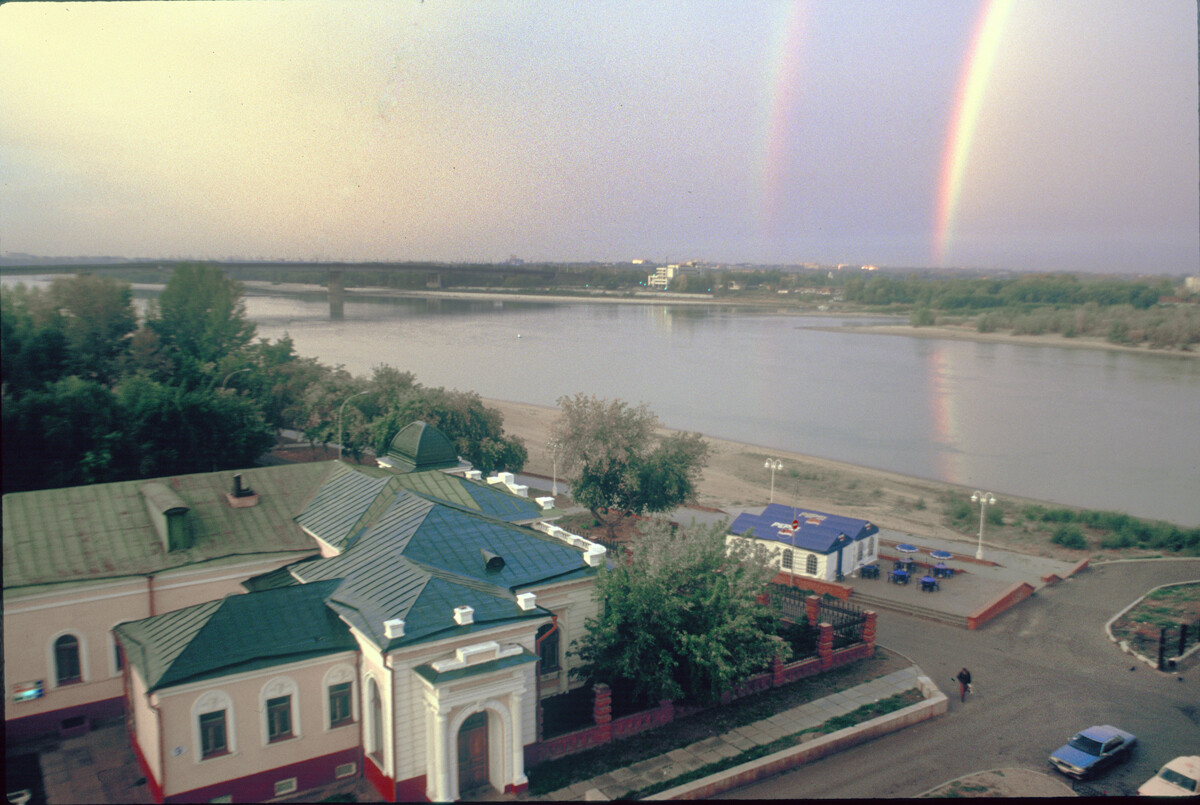
Omsk. Irtysh River, morning panorama with rainbow. Foreground: K. A. Batiushkin mansion (residence of Admiral Alexander Kolchak in 1919). September 19, 1999
At the beginning of the 20th century, Russian chemist and photographer Sergey Prokudin-Gorsky developed a complex process for vivid color photography. His vision of photography as a form of education and enlightenment was demonstrated with special clarity through his images of architectural monuments in the historic sites throughout the Russian heartland.
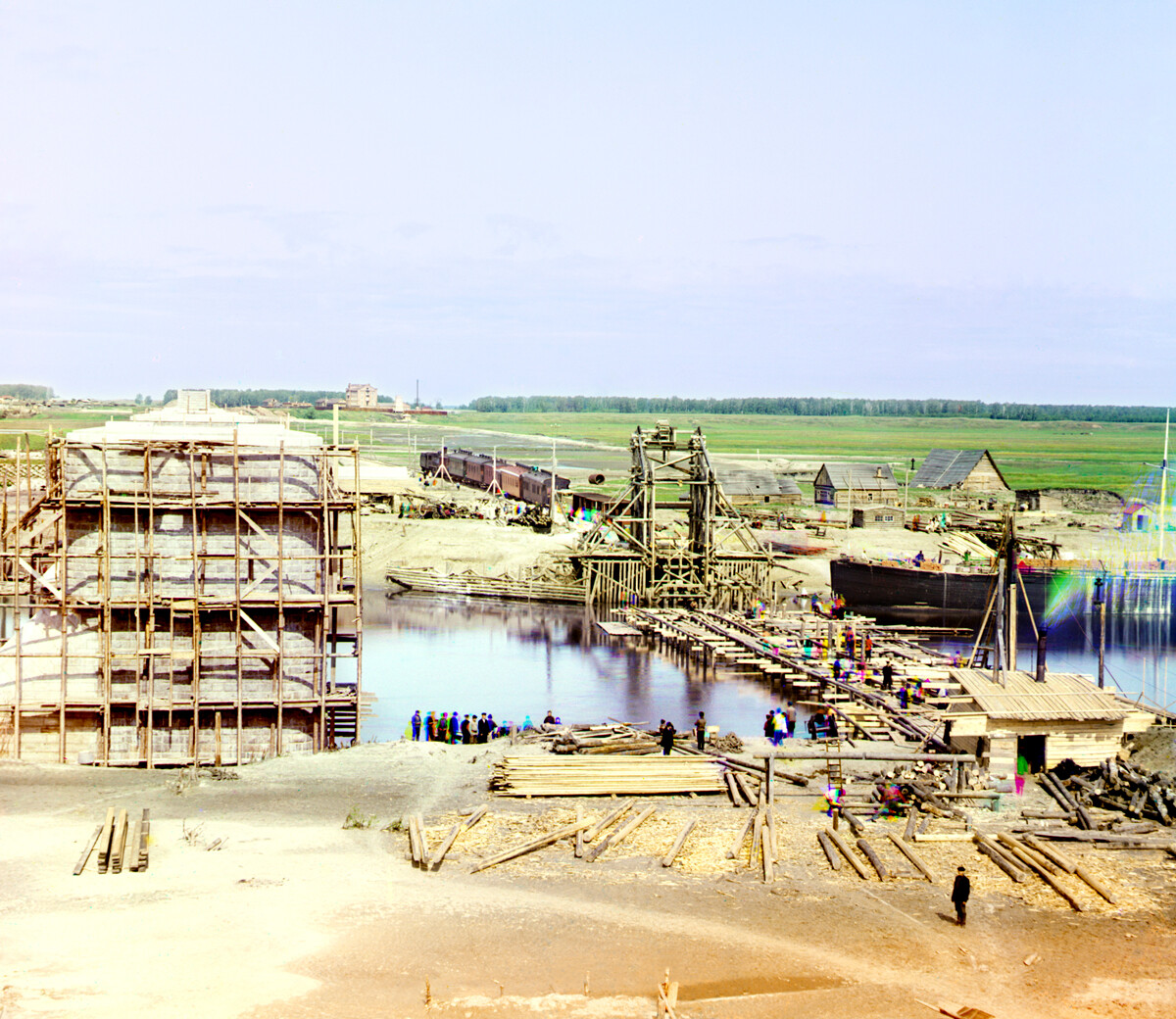
Yalutorovsk. Construction of Tobol River railroad bridge leading to Omsk. Summer 1912
In June 1912, Prokudin-Gorsky ventured into western Siberia as part of a commission to document the Kama-Tobolsk Waterway, a link between the European and Asian sides of the Ural Mountains. The town of Tyumen served as his launching point for productive journeys that included Shchadrinsk (established in 1662 on the Iset River) and Yalutorovsk (on the Tobol River).
Omsk origins
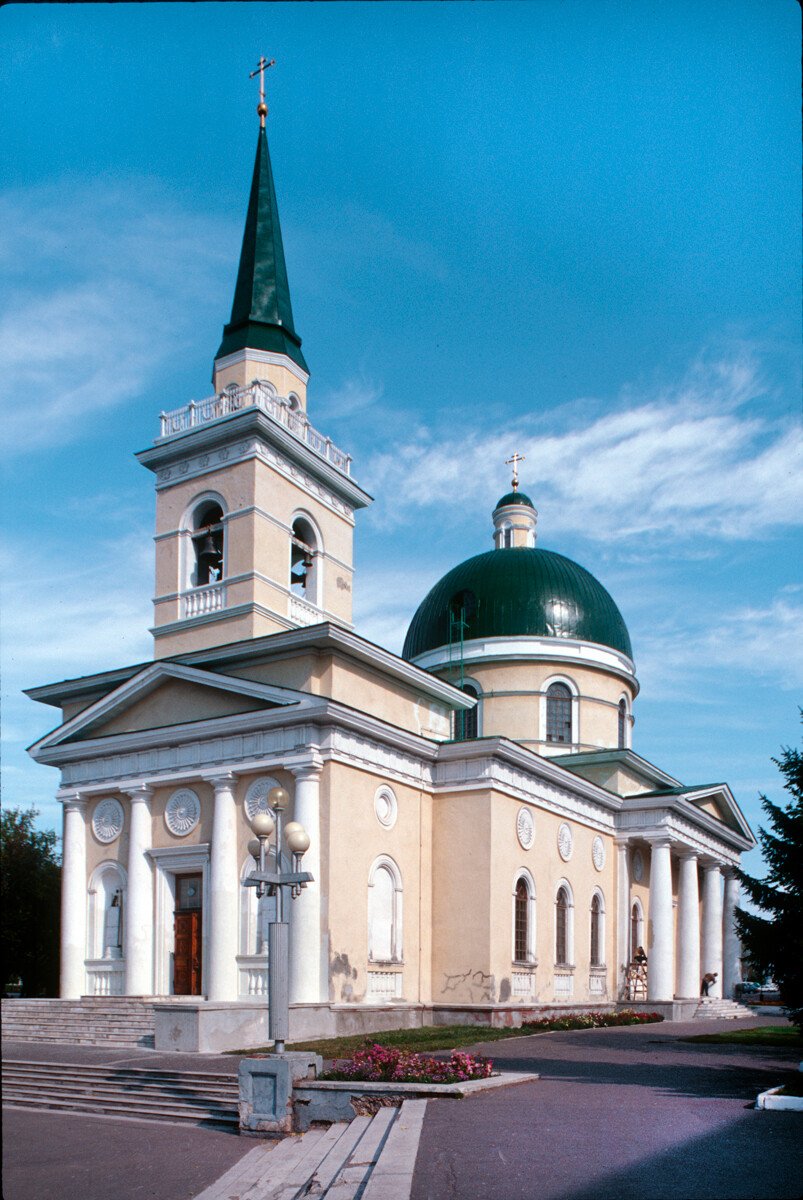
Omsk. Cossack Cathedral of St. Nicholas, southwest view. September 15, 1999
Founded in 1659 at a former Tatar settlement, Yalutorovsk was the construction site of a massive railroad bridge across the Tobol River, part of the new Tyumen-Omsk rail link that opened on the Trans-Siberian Railway in October 1913 (Before then, the railroad to Siberia went through the southern Urals town of Chelyabinsk ).
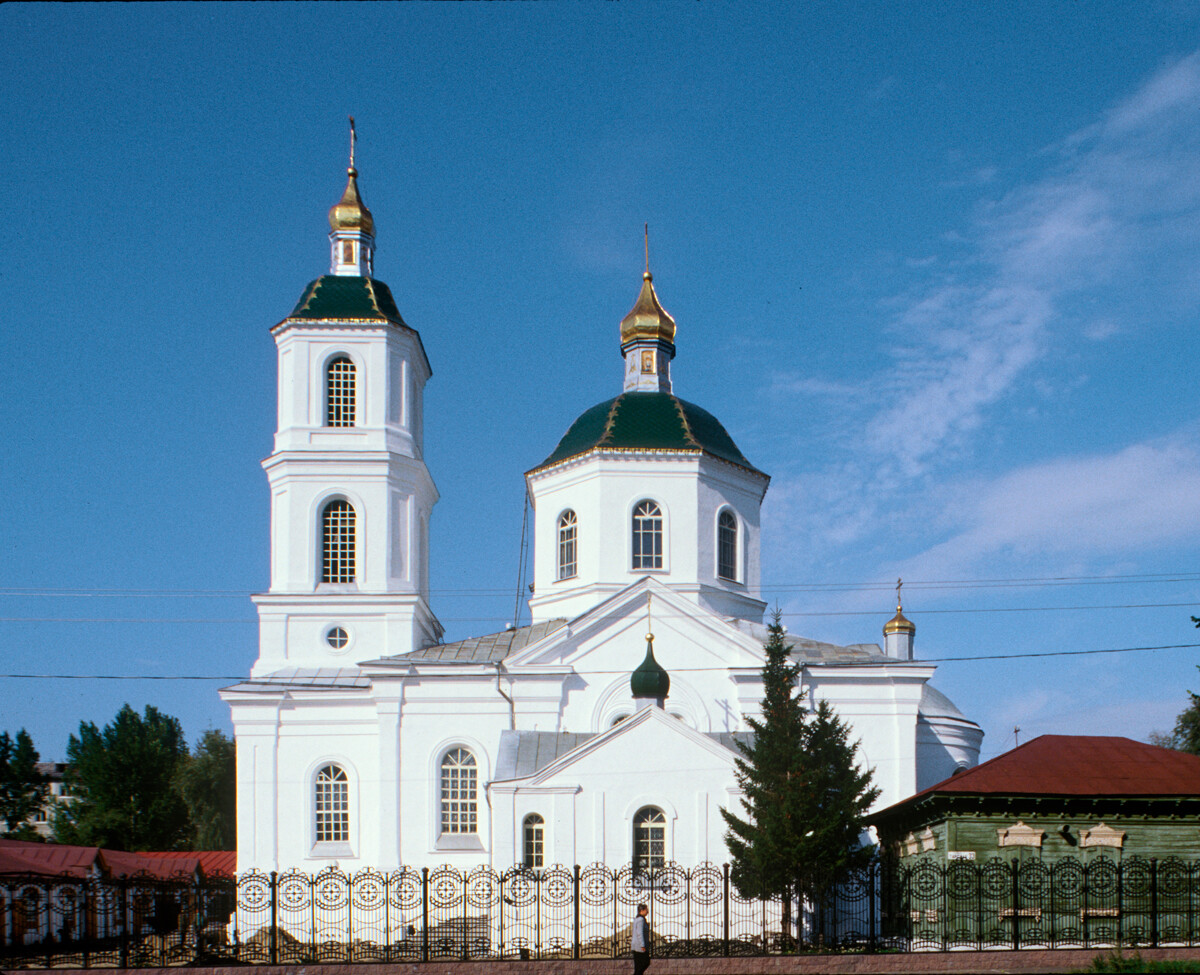
Omsk. Cathedral of the Elevation of the Cross, south view. September 15, 1999
Although Prokudin-Gorsky did not travel to Omsk, his photographs of Yalutorovsk show the making of a crucial rail link to the “capital” of western Siberia. I, however, reached Omsk in the late Summer of 1999.
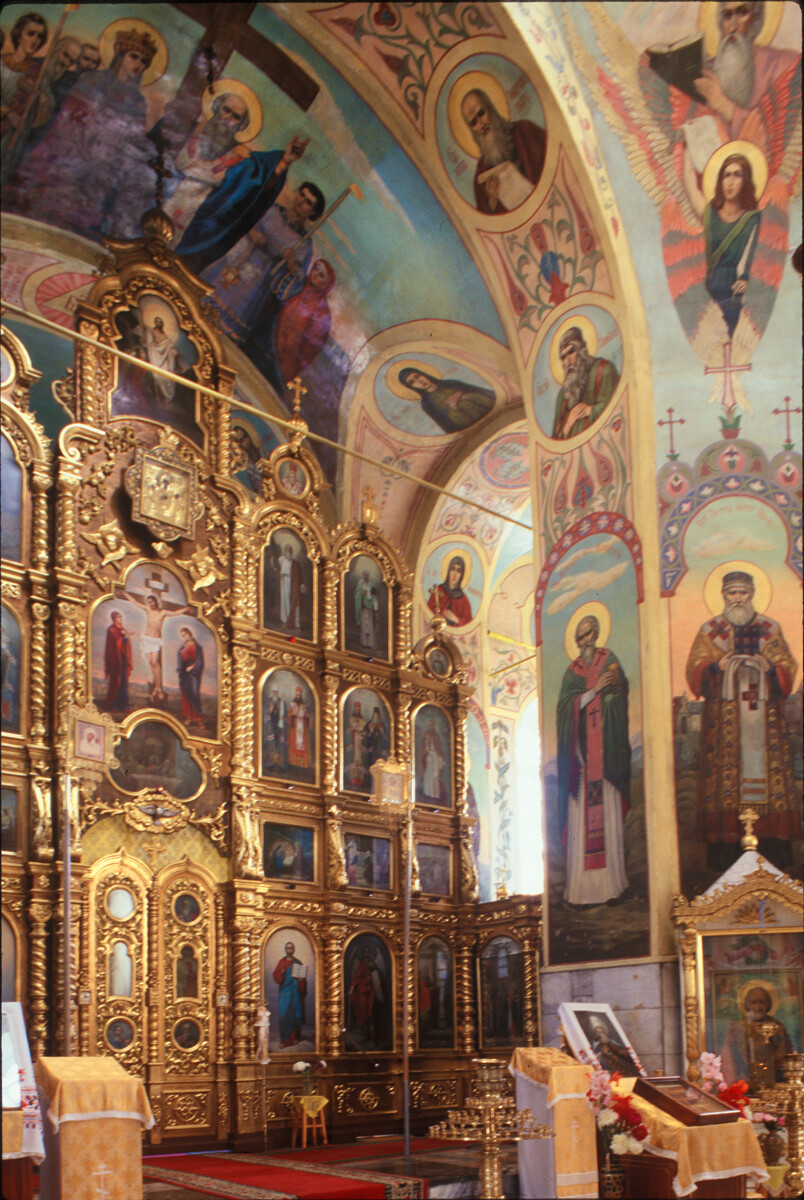
Cathedral of the Elevation of the Cross. Interior view southeast toward icon screen. September 15, 1999
Omsk (current population around 1,110,000) was founded in 1716 as a fort on the middle reaches of the Irtysh River. During the 18th century, its primary purpose was to protect Russia’s southern border and establish authority over the aboriginal steppe tribes.
Rising regional importance
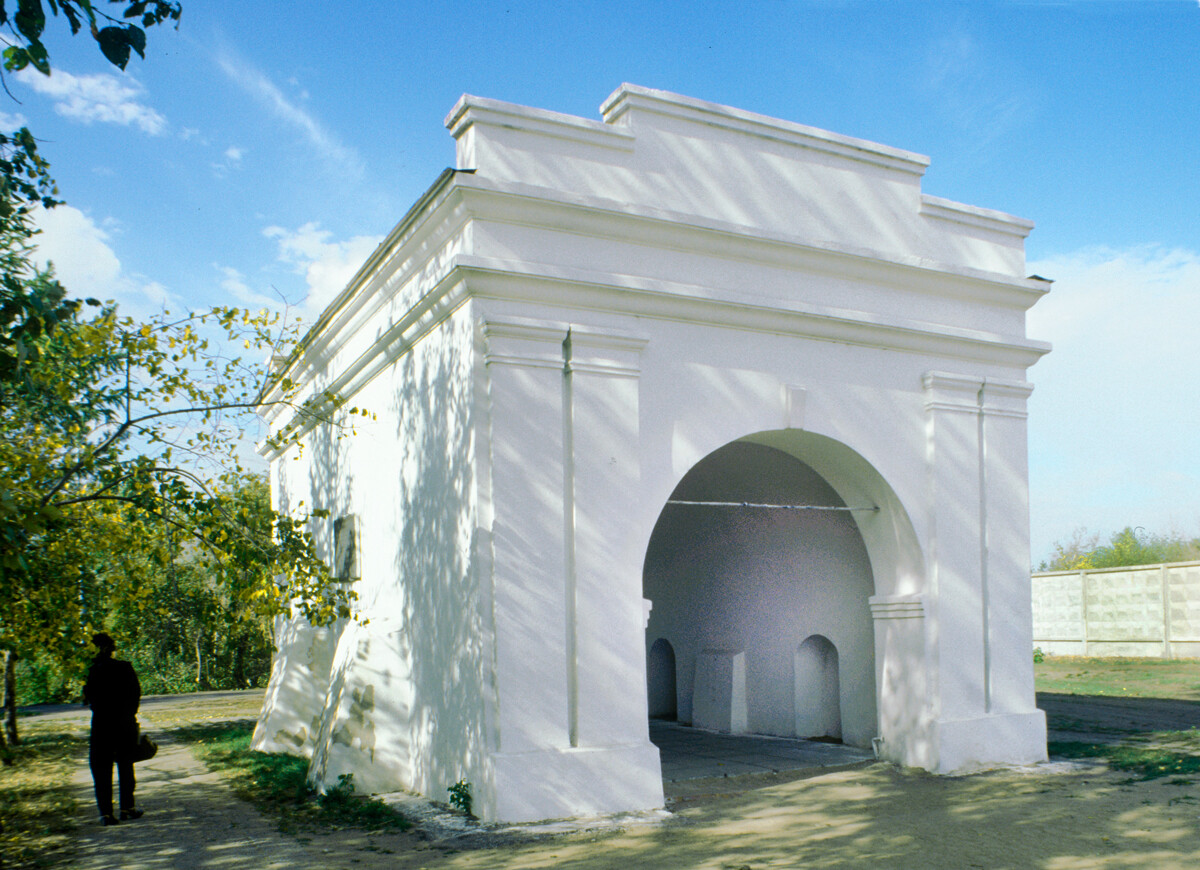
Omsk Fortress. Tobolsk Gate (originally built in 1792), the only one of the historic Omsk fortress gates to have survived. September 15, 1999
Although administratively subordinate to Tobolsk throughout the 18th century, Omsk gained increasing power in the 19th century. From 1808 until 1917, Omsk served as the headquarters of all Siberian Cossack troops and, in 1822, a separate Omsk Province was formed.
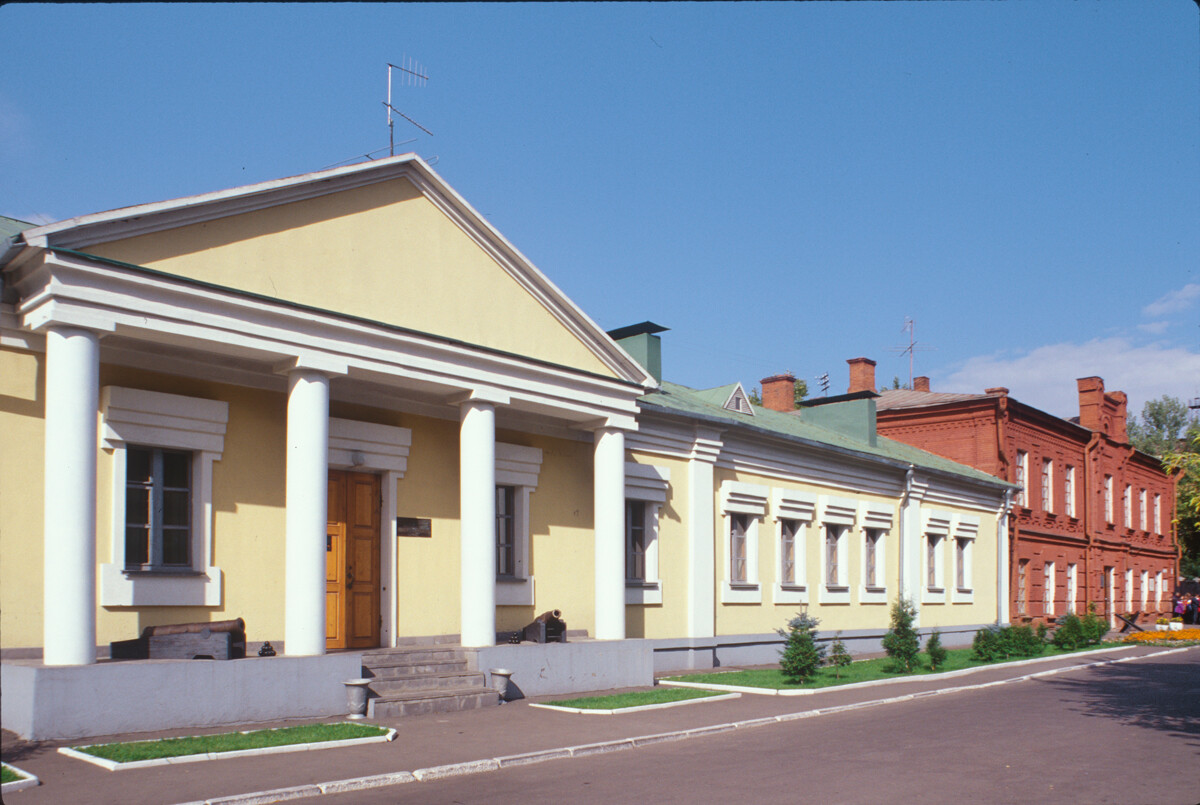
Headquarters of Omsk Fortress (Taube Street), originally built in 1810s, modified in 1997. Red brick building on right (1915-17): Staff of Omsk Military District. September 15, 1999
Shortly thereafter, construction began on the Cossack Cathedral of St. Nicholas (1833-1840), based on a plan by the noted Russian architect Vasily Stasov. The St. Nicholas Cathedral was severely disfigured during the Soviet period, but has now been restored. It is, once again, the repository of one of the area’s great relics, the banner of Yermak , the late 16th-century Cossack leader who first established Muscovy’s presence in Siberia.
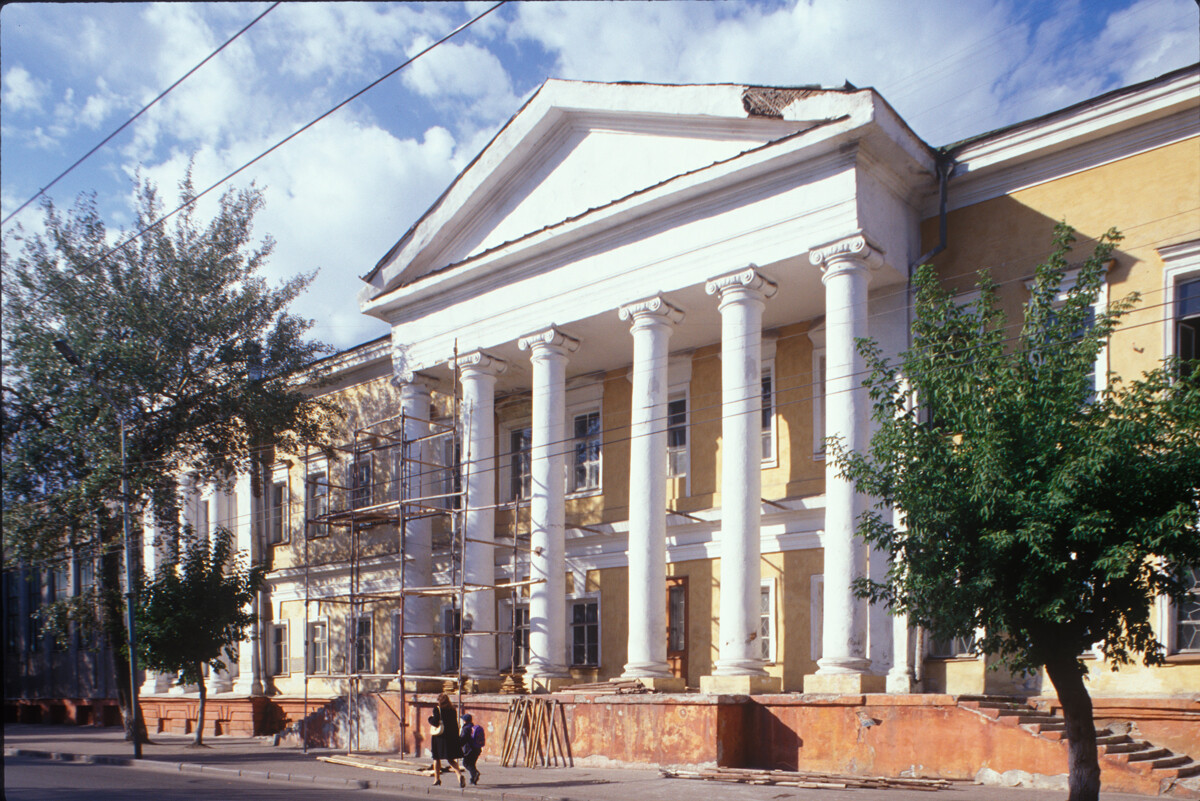
Siberian Cadet Corps building (Lenin Street 26), built in 1820s. In the prerevolutionary period, the street was known as Chernavin Prospekt, after a popular progressive mayor. September 15, 1999
In 1865-1870, Omsk witnessed the construction of another cathedral, dedicated to the Elevation of the Cross. It, too, survived the devastation of the 1930s and was reopened for worship in November 1943. In addition to its Orthodox churches, Omsk has mosques (the administration of the Iman of Siberia is located in Omsk), a remarkable wooden synagogue and a large Baptist church built in 1907.
Omsk’s dark history

Residence of Governor-General of Western Siberia (Lenin Street 23), built in 1859-62 by Friedrich Wagner for Governor Gustav Gasford. Now one of the three buildings of Omsk Museum of Art. September 18, 1999
Its pervasive military presence linked Omsk with the Siberian exile system. The most famous of the fortress’ exiles was the writer Fyodor Dostoevsky, condemned in 1849 for associating with intellectual “radicals” in St. Petersburg. In January 1850, Dostoevsky arrived under guard at the Omsk fort and, for the most part of three years (1850-54), he lived the harrowing existence of a convict sentenced to hard labor, which included unloading barges on the Irtysh River.
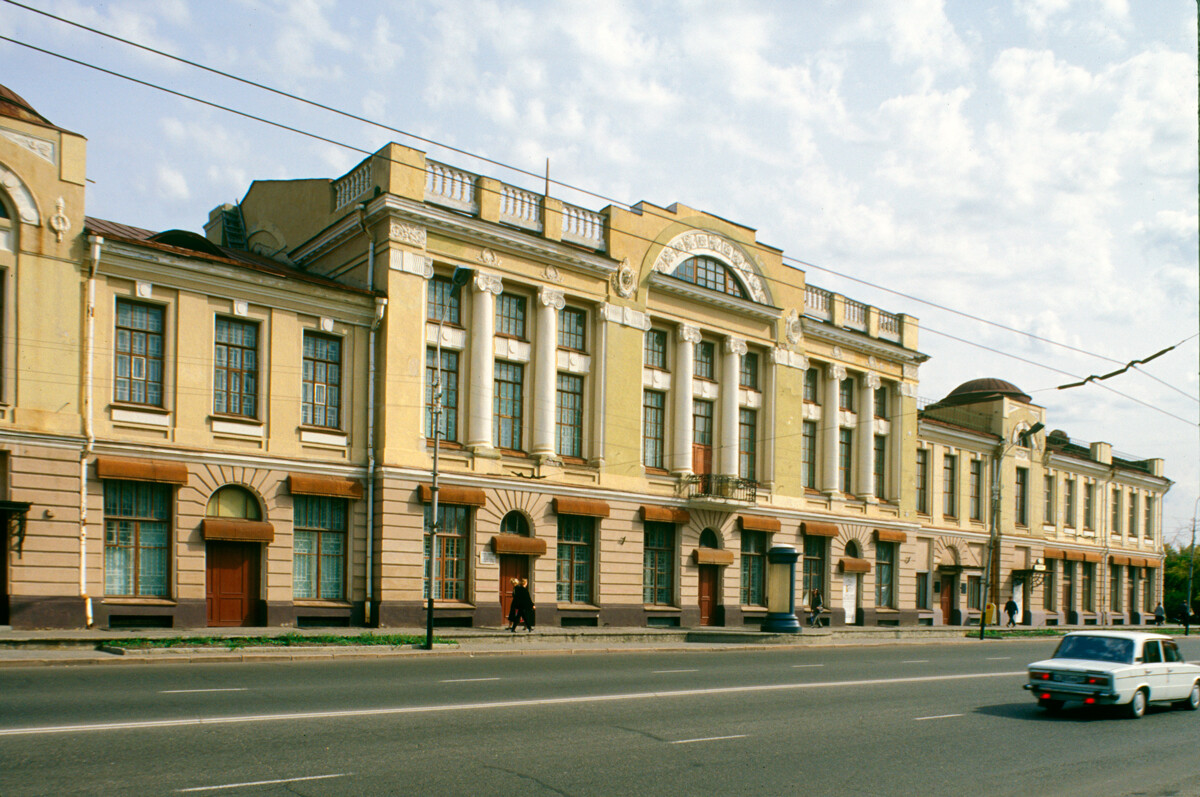
City Trade Building (Lenin Street 3), built in 1914 by Andrei Kriachkov. Now the main building of Omsk Museum of Art. September 16, 1999
When his health broke down under the physical and psychological strain, Dostoevsky was hospitalized under the care of a sympathetic medic. It was during his stay in the infirmary that Dostoevsky began the writing of one of his seminal works, ‘Notes from the House of the Dead’. A few buildings still survive from that time, including one of the fortress gates.
Railroad revolution
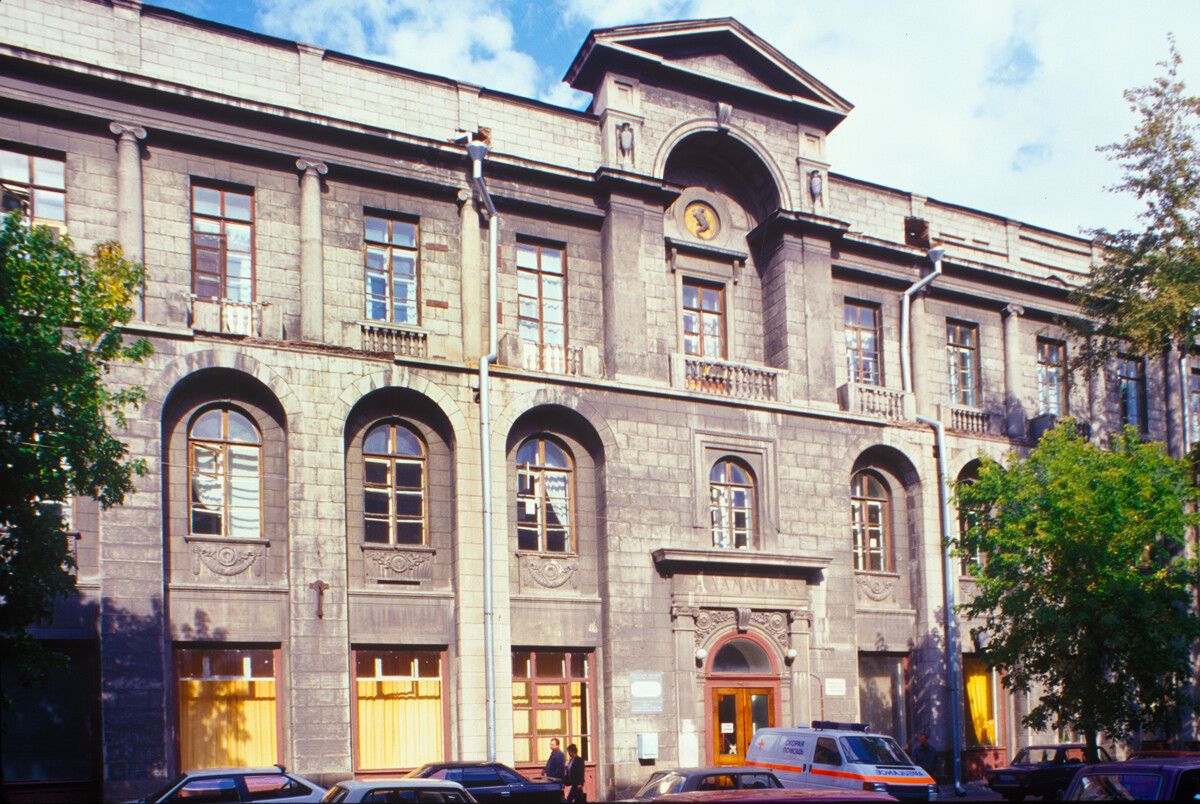
"Salamander" Insurance Company building, K. Liebknecht (formerly Gasford) Street 3, built by Nikolai Verevkin in 1913-14. Now one of the three buildings of Omsk Museum of Art. September 15, 1999
During the latter part of the 19th century, Omsk began a period of heady expansion, as the town became a transportation center for Russia’s vast interior. Regular steamboat service along the Irtysh River to Tobolsk began in 1862.
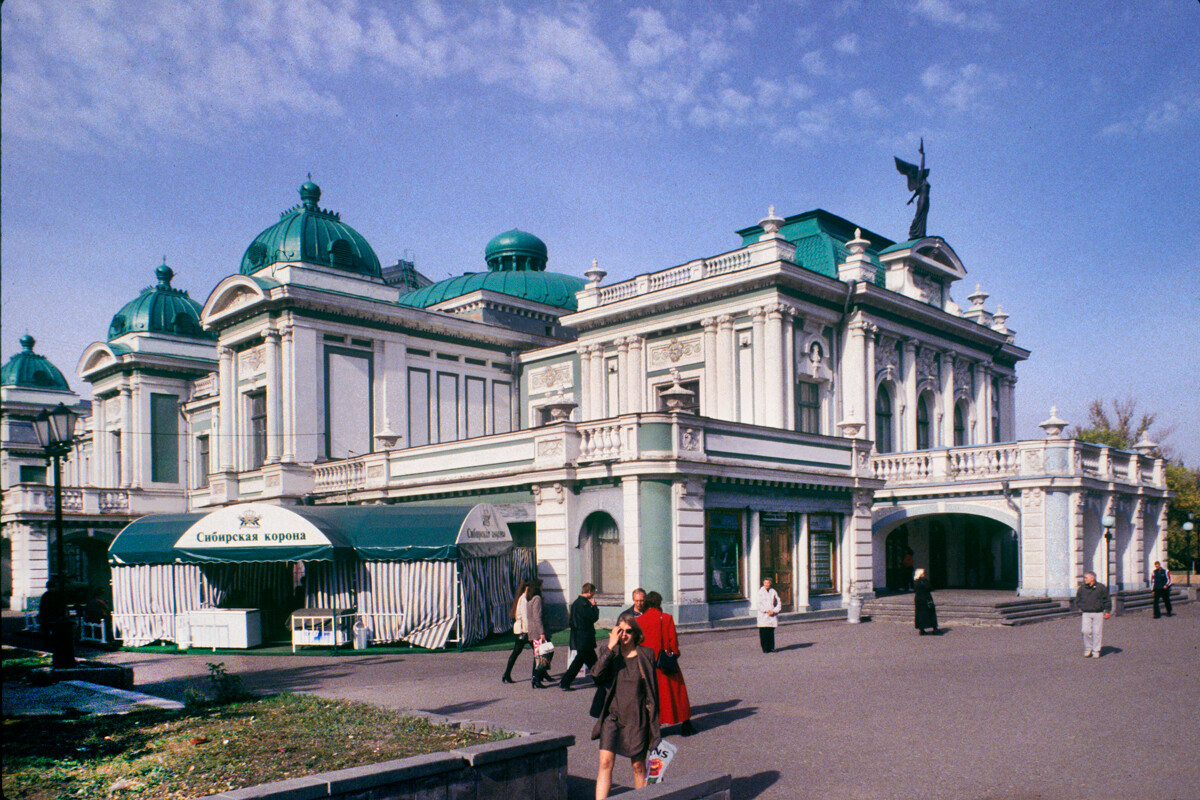
Omsk Drama Theater, Lenin Street 8A. September 15, 1999
But, it was the railroads that made Omsk a boomtown. In 1894-1895, Omsk was linked by the Trans-Siberian Railroad to Chelyabinsk in the west and Novonikolaevsk (later Novosibirsk) in the east. In 1913, another rail line was completed from Omsk to Tyumen in what would become the new Siberian mainline. By the beginning of the 20th century, the population of Omsk had tripled to over 60,000 inhabitants.
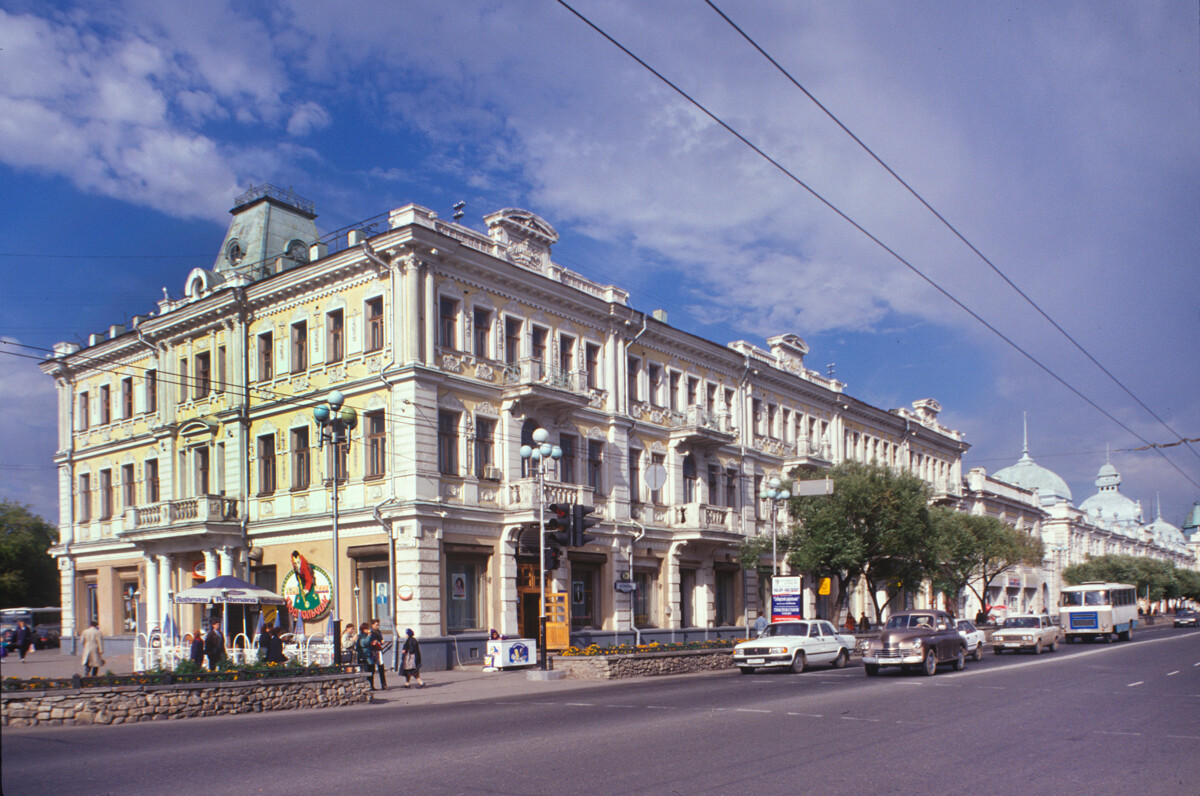
"Rossiya" Hotel (Lenin Street 18). Built by Iliodor Khvorinov in 1905-07; expanded in 1915. September 15, 1999
This development as a transportation nexus led to a surge in the city’s commercial district. What had formerly been a provincial garrison town consisting primarily of wooden structures punctuated with large churches, now became a preeminent site for banks, educational institutions, industry and retail trade in Siberia.
International appeal
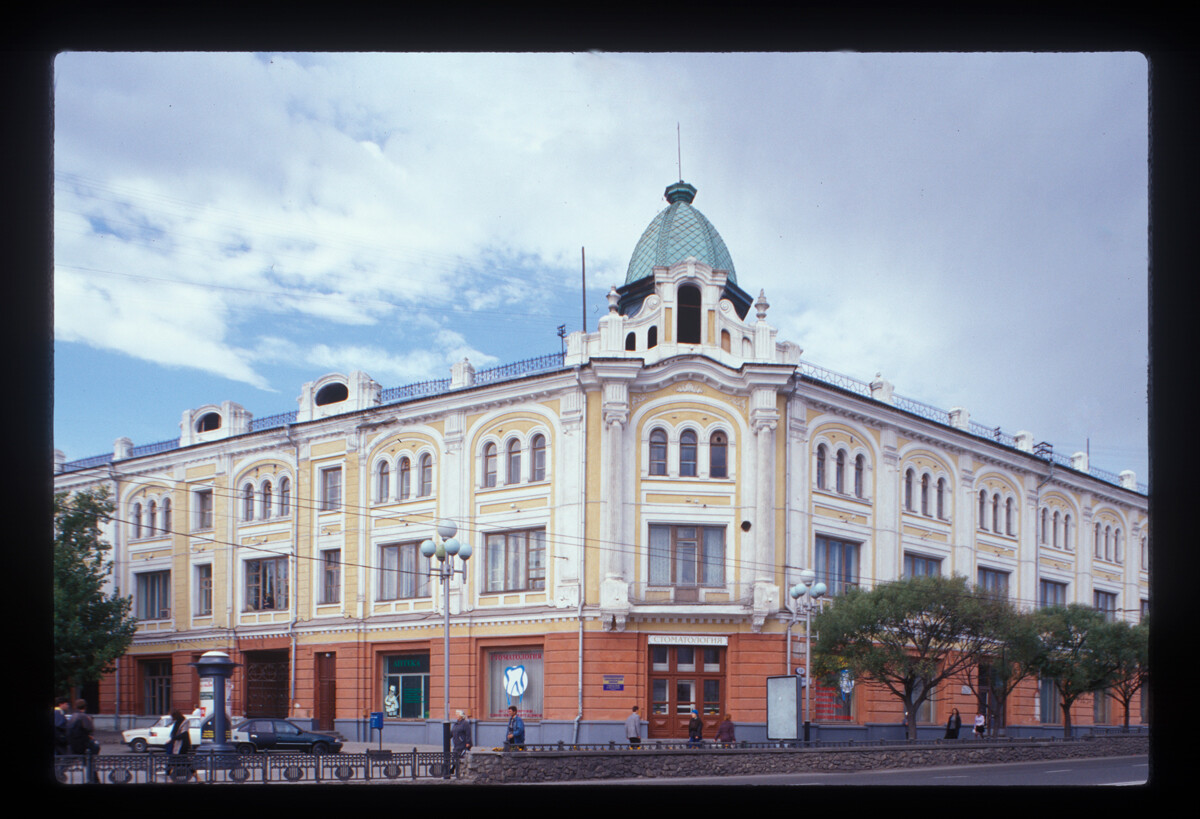
Brothers Ovsiannikov-Ganshin & Sons building (Lenin Street 12), originally completed in 1906 for a major textile company. Now the Omsk Medical Academy. September 15, 1999
In addition to branch offices for major banks and firms in Moscow and St. Petersburg, Omsk received investment from companies in the United States, Germany and Great Britain. The central part of Omsk had buildings whose design rivaled Moscow’s business district. Many of the new commercial projects were built in styles derived from the Florentine Renaissance.
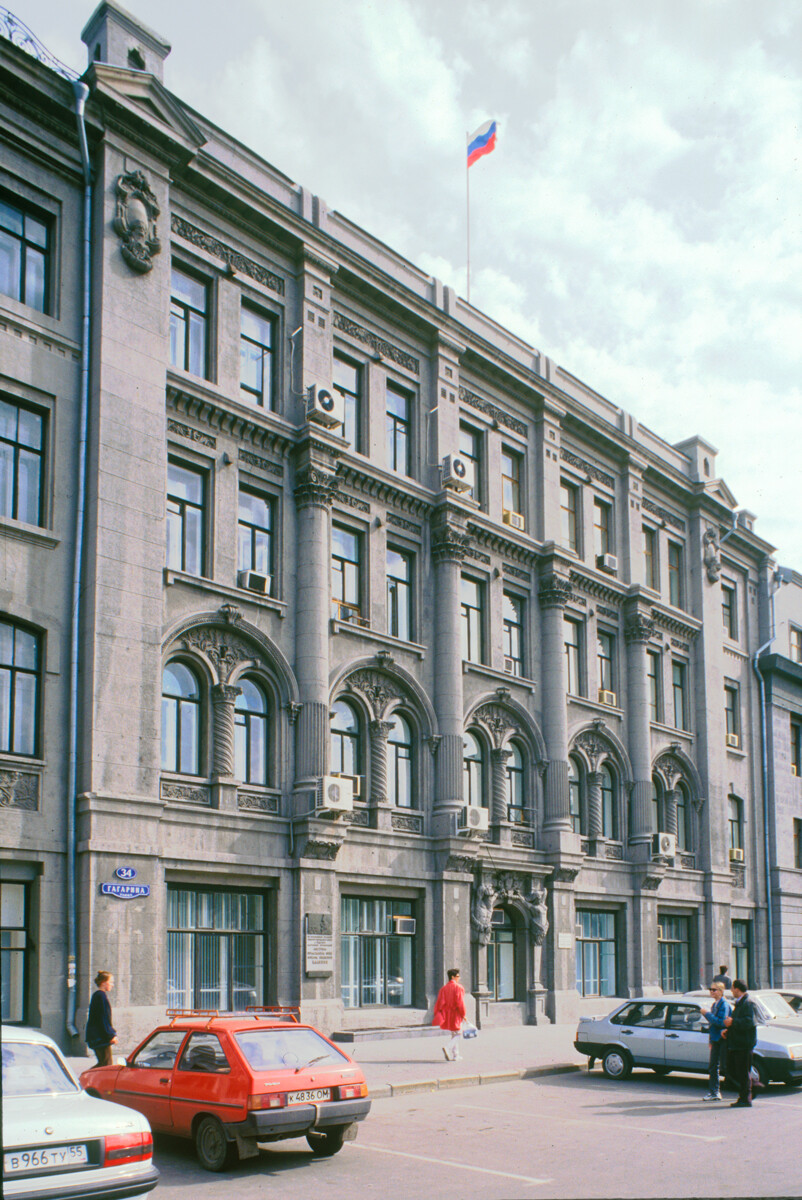
Russo-Asiatic Bank (Gagarin Street 34), built in 1915-17 by Fyodor Chernomorchenko. Now Omsk City Hall. September 16, 1999
Cultural institutions also took root. In 1901-05, a large theater was built in a florid Beaux Arts style designed by the architect Iliodor Khvorinov. The theater still stands as an object of civic pride. Wooden houses with decorative detailing also grace the city, but their number has steadily decreased under the pressures of urban development and inadequate maintenance.
Soviet era…
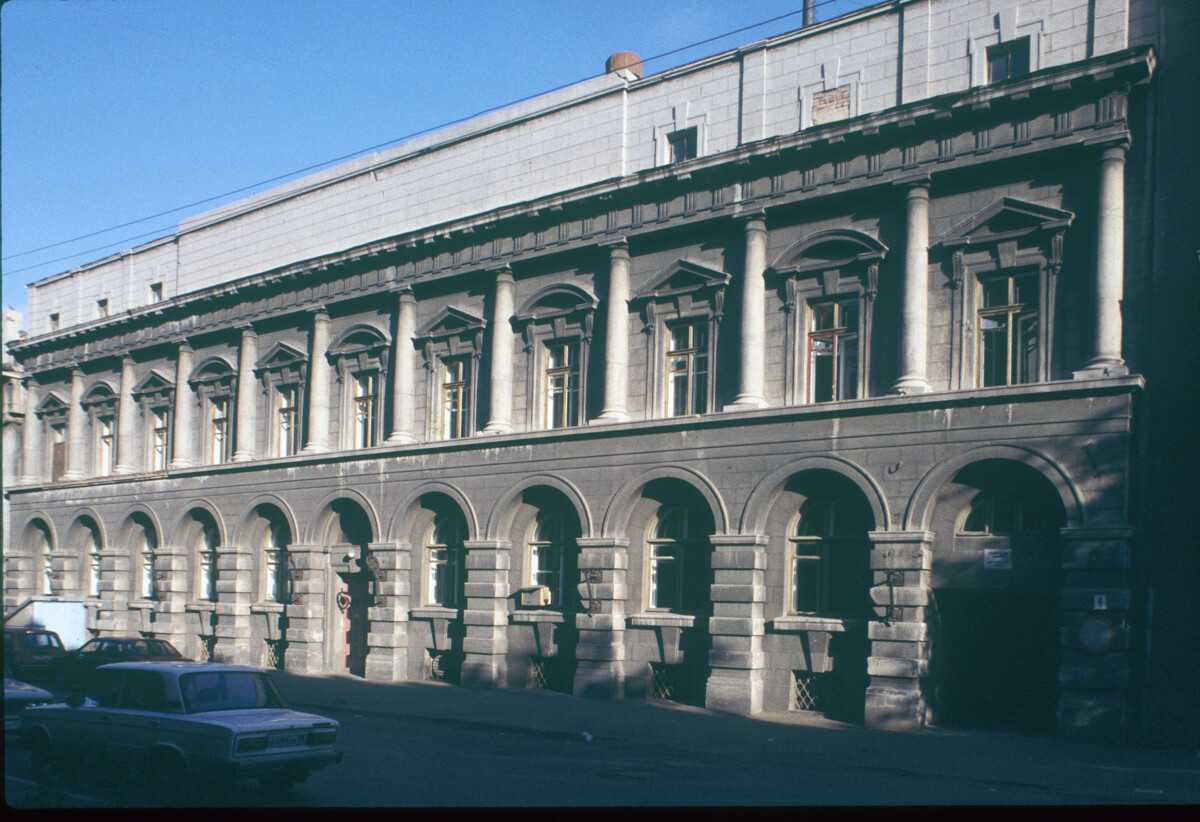
"Treugolnik" (Russian-American Rubber Co.) Building, K. Liebknecht (formerly Gasford) Street 4, built by Nikolai Verevkin in 1914-15. September 15, 1999
During World War I, the then strategically located Omsk grew still further and, by 1917, the city’s population had reached 100,000. Following the October Revolution, Bolshevik power was proclaimed almost immediately in Omsk, but, with little local support, the Bolsheviks were driven from the city in June 1918.
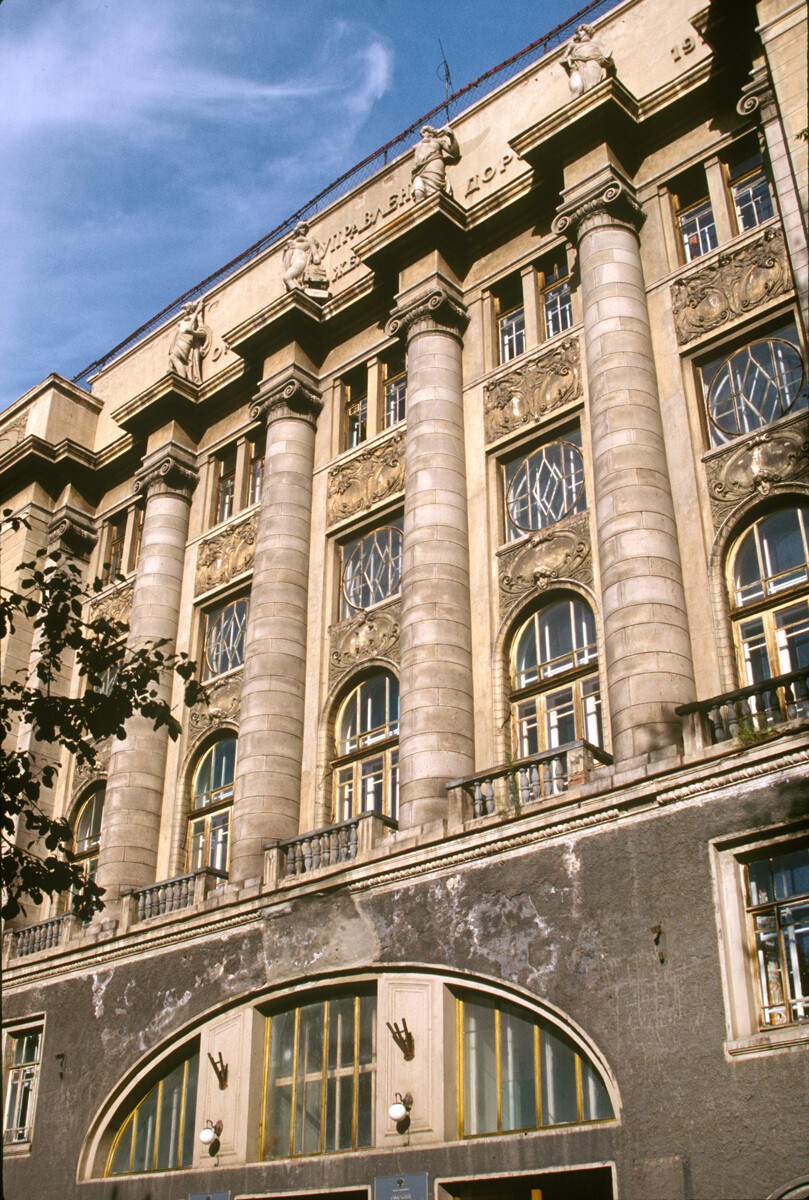
Omsk Railroad Administration (Karl Marx Street 35), de factor headquarters of western Trans-Siberian Railway. Built in 1914-16 by Fyodor Lidval. September 18, 1999
Opposition to the Bolsheviks was fatally divided and, in November 1918, a military coup installed a dictatorship headed by Admiral Alexander Kolchak (1874-1920), a renowned polar explorer and gifted naval commander, but incapable of dealing with the chaos of the Russian civil war (The mansion where Kolchak had his headquarters is a prominent landmark).
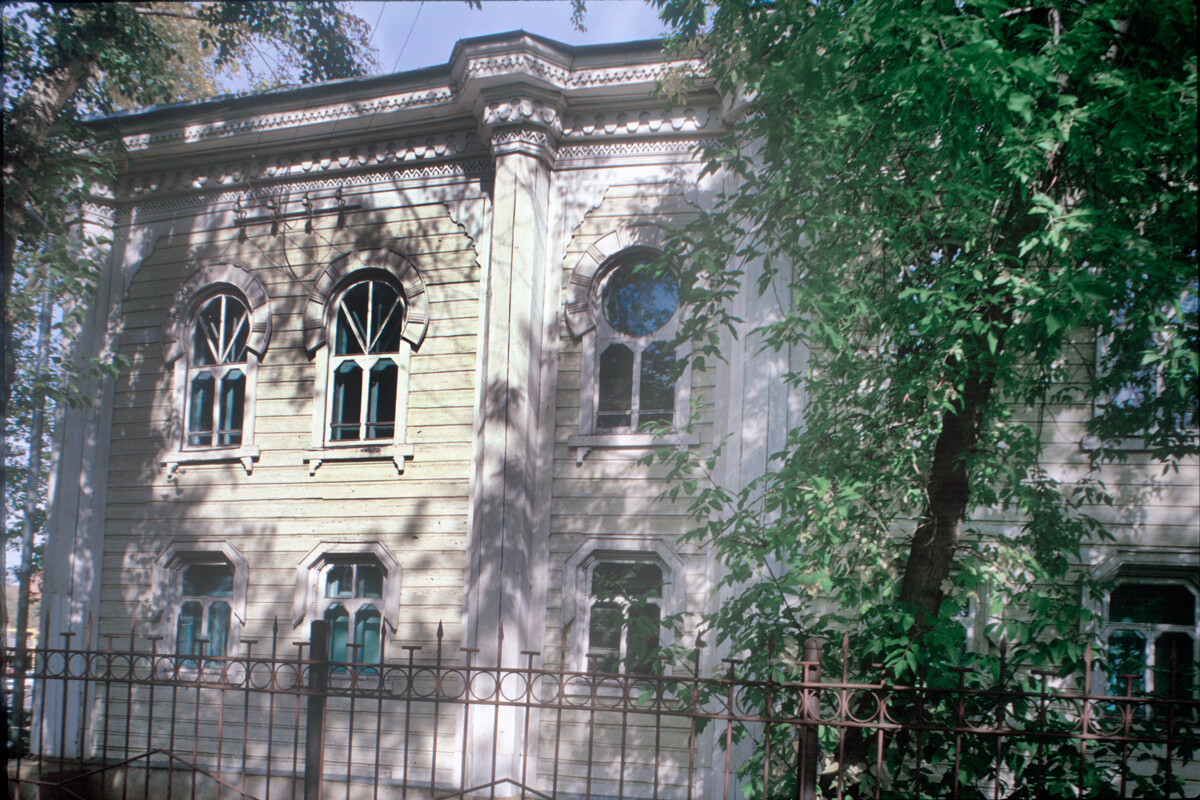
Omsk Synagogue (Marshal Zhukov Street 53). Known as "Soldiers Synagogue," built in 1855. September 18, 1999
For almost a year, Omsk could be considered the “capital” of the White forces in the Russian Civil War. In November 1919, Kolchak’s forces were driven from Omsk. In 1921, Omsk became one of the centers of the American Relief Agency during the terrible famine that afflicted vast territories in the Volga basin.
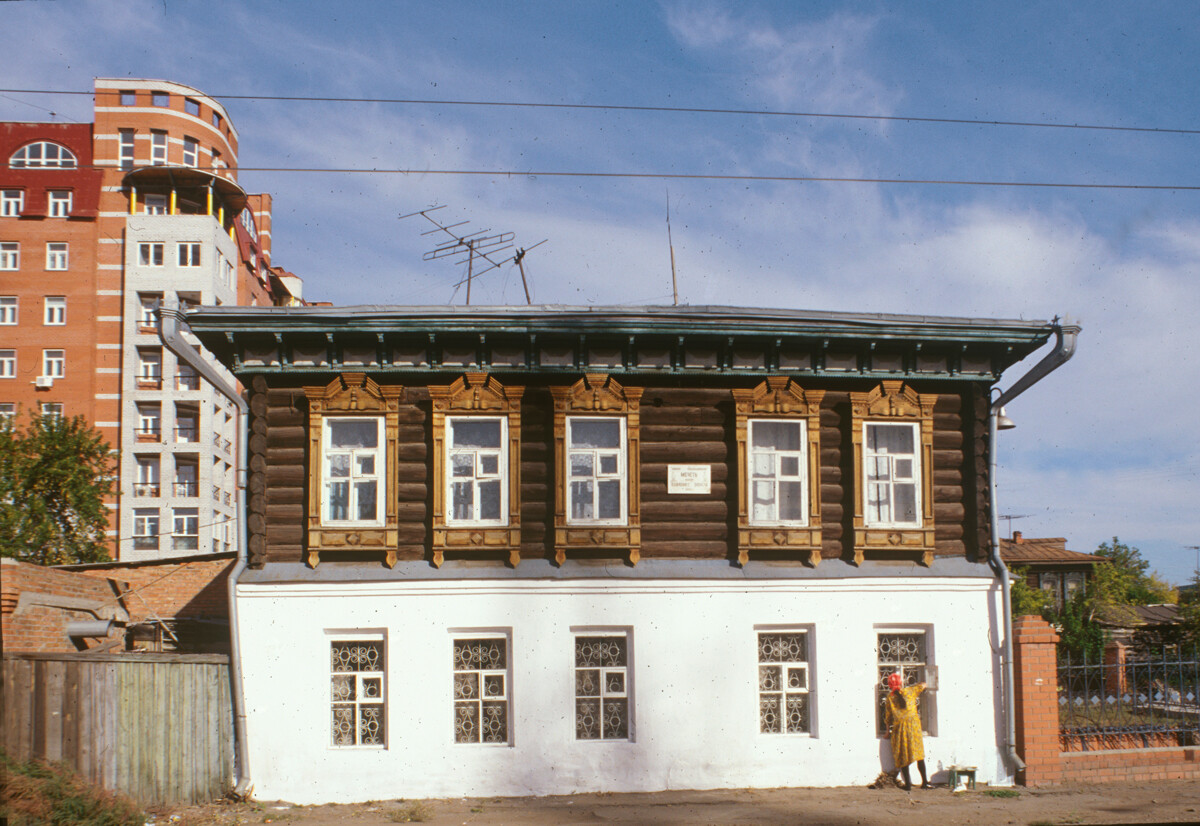
Hodja Akhmed Mosque (Marshal Zhukov Street 97). September 18, 1999
With its economy shattered and the countryside still recovering, Omsk struggled through the 1920s and achieved renewed industrial growth in the 1930s. Like many Siberian cities, it expanded rapidly during World War II as an evacuation haven and as a center of transportation and production.
…and beyond
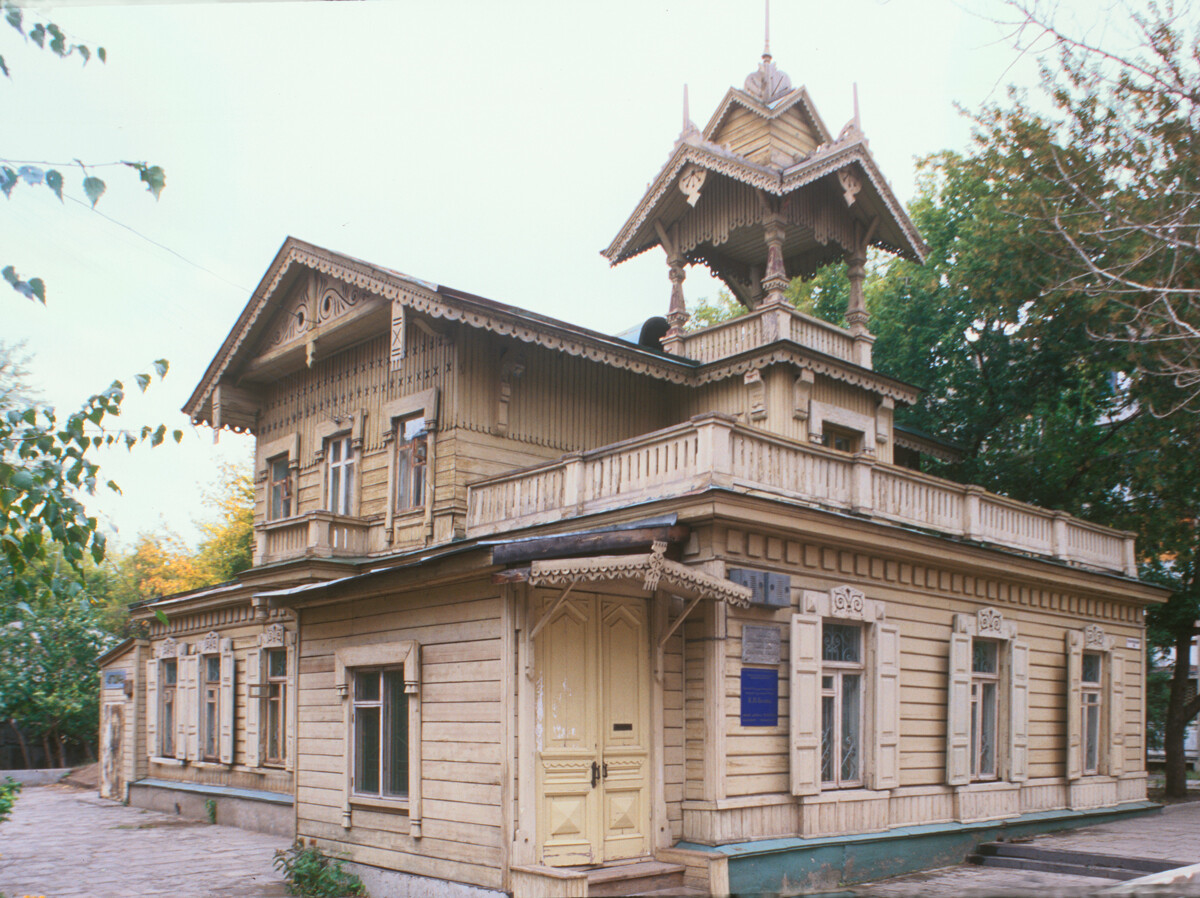
Philip Shtumfp house (Valikhanov Street 10), built at turn of 20th century for a prominet agronomist, entrepreneur, civic activist. September 19, 1999
Development of the city’s military-industrial complex continued after the war and, by the end of the 1970s, the population exceeded 1,000,000 – a benchmark of major significance. Omsk also became a center of the oil and gas industry.
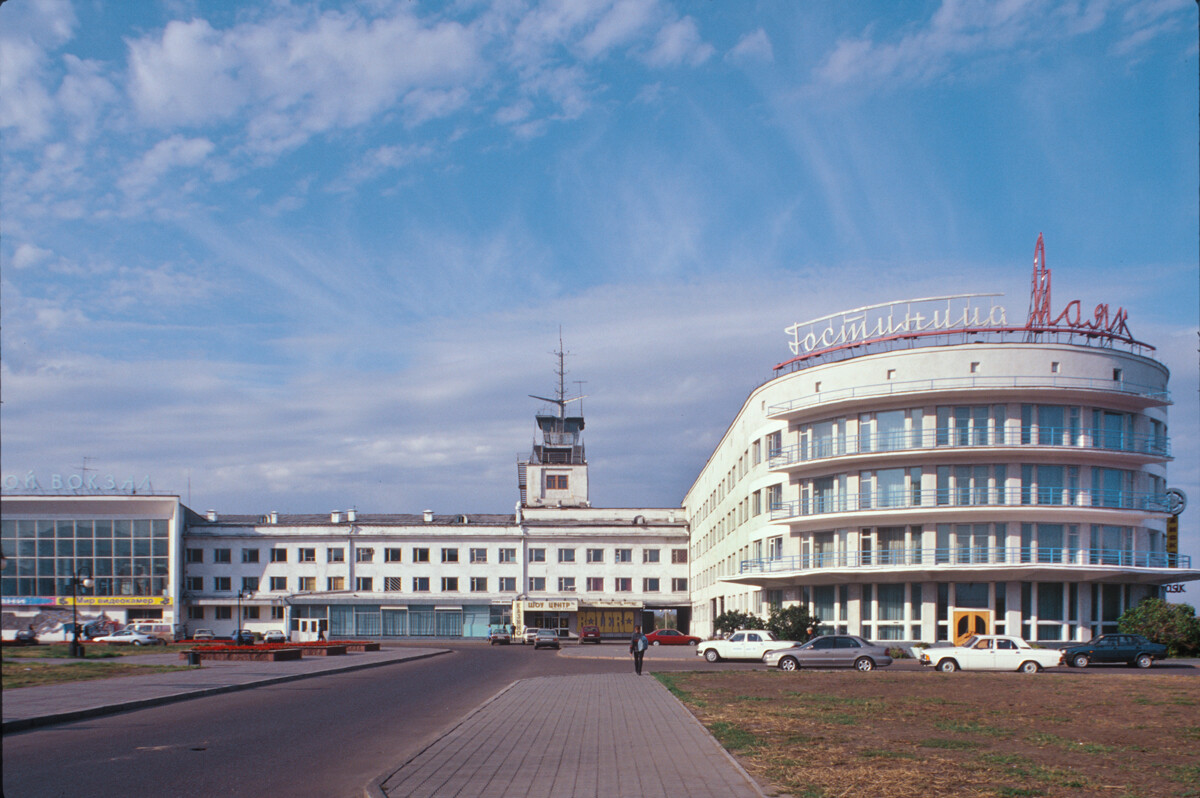
Omsk River Station & Hotel "Mayak". Excellent example of "neo-Constructivist architecture, built on site of original Omsk fortress in 1958-64 by Leningrad architect Timofei Sadovsky. September 15, 1999
The city’s major cultural institutions include a leading state university, established in 1974 and, since 2004, named in honor of Fyodor Dostoevsky. Omsk also has one of the largest regional libraries in Siberia and a major art museum--named in honor of painter Mikhail Vrubel, an Omsk native – that now occupies three landmark buildings in the center of the city.
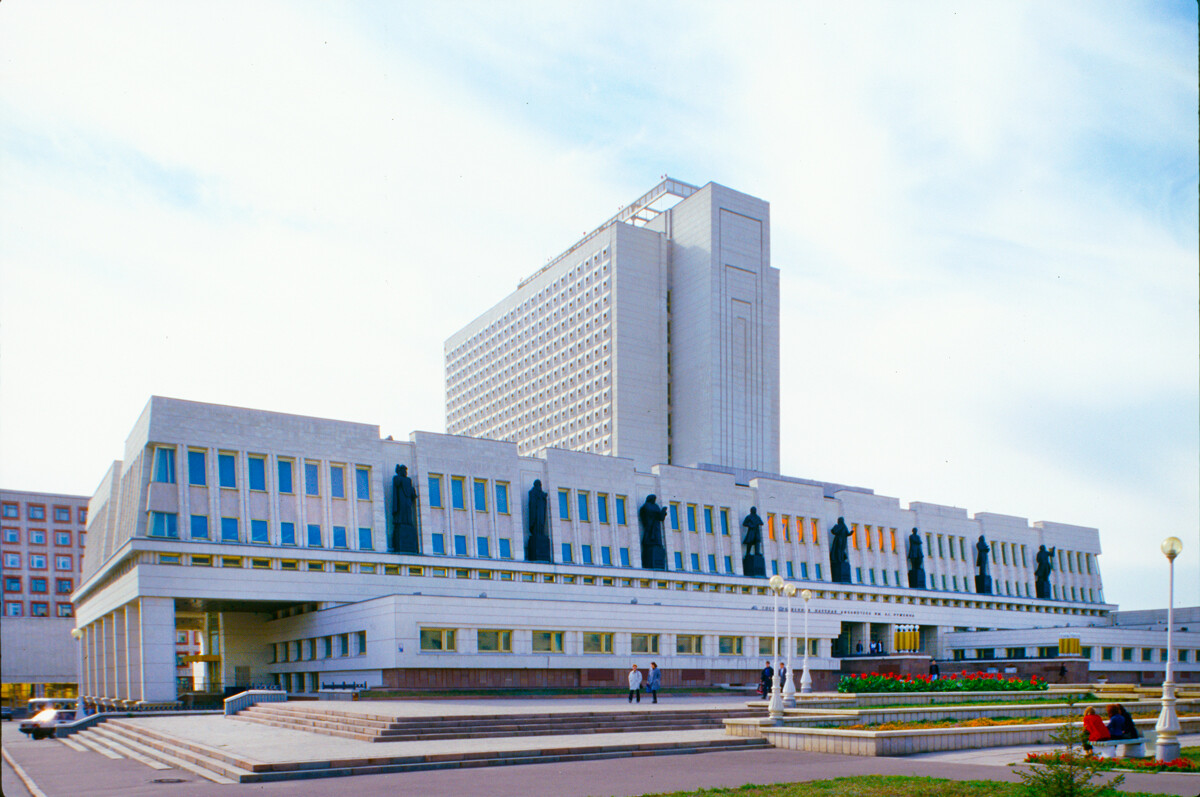
Omsk Regional Library. Built in 1986-95 by Omsk architects Galina Naritsina & Yury Zakharov. September 18, 1999
In the early 20th century, Russian photographer Sergey Prokudin-Gorsky developed a complex process for color photography. Between 1903 and 1916, he traveled through the Russian Empire and took over 2,000 photographs with the process, which involved three exposures on a glass plate. In August 1918, he left Russia and ultimately resettled in France, where he was reunited with a large part of his collection of glass negatives, as well as 13 albums of contact prints. After his death in Paris in 1944, his heirs sold the collection to the Library of Congress. In the early 21st century, the Library digitized the Prokudin-Gorsky Collection and made it freely available to the global public. A few Russian websites now have versions of the collection. In 1986, the architectural historian and photographer William Brumfield organized the first exhibit of Prokudin-Gorsky photographs at the Library of Congress. Over a period of work in Russia beginning in 1970, Brumfield has photographed most of the sites visited by Prokudin-Gorsky. This series of articles juxtaposes Prokudin-Gorsky’s views of architectural monuments with photographs taken by Brumfield decades later.
If using any of Russia Beyond's content, partly or in full, always provide an active hyperlink to the original material.
to our newsletter!
Get the week's best stories straight to your inbox
- U.S. professor continues photographic legacy of Prokudin-Gorsky in new book
- Exploring the Stroganov Baroque in the Russian North
- Taltsy: Preserving folk architecture in the Lake Baikal area (PHOTOS)
This website uses cookies. Click here to find out more.

IMAGES
VIDEO
COMMENTS
As the premier Yacht Charter in the Wilmington, NC, we know that nobody truly offers what we do. Our beautiful Mangusta 72 features three staterooms, three bathrooms, a full kitchen, a living room, and an entertainment area that will have your guests in awe. Able to sleep 8 and carry up to 12, bring the family and some friends - we have the ...
Sunset Sailing Cruises Outer Banks- OBX. Our mission is to inspire conscious living through coastal experiences. The ocean constantly reminds us of who we are. It gives us a purpose, a sense of adventure, and connects us to something bigger than ourselves. Our vision is to create a community of Coastal Sols, who appreciate, discover, and ...
Private Outer Banks Sailing Charters. Trade in the stillness of land to go with the flow of the open sea. The breathtaking views of the water set the background for a tranquil adventure on a private Catamaran with your closest friends and loved ones. Design your own event for this private Outer Banks Sailing charter. LEARN MORE
855-410-7245. 48962 NC Hwy 12. Buxton, NC 27920. Outer Banks Sailing Charters and Sunset Sails on Hatteras Island. Book a boat tour with Phillips Boatworks and sail the Pamlico Sound.
The Downeast Rover crew is excited about another great season on the Outer Banks! We take sailing charters and reservations from May through October. If you would like to reserve your seat on any of our daytime or sunset cruises or inquire about a private sailing charter on the Outer Banks, please book online or contact us via phone: 252-473-4866.
We had the pleasure of having our OBX 32 Center Console Sportsfishing Boat recognized on by Florida Sportsmans' Best Boat review. OBX Boatworks creates custom designed boats drawing on the experience of a noted naval architect, design engineers, and master craftsmen. We strive to create boats that maximize performance and improves safety while ...
Private sail charters in the Outer Banks, day sails and sunset sailing for 2-1/2 to 3 hours on the Roanoke and Albemarle Sounds. We sail from Manteo, NC located on Roanoke Island in the OBX. Our sail boat is a 41' Gulfstar ketch.
We got there and they put us in a ski in a matter of 10 minutes. Of course call ahead if you have a big party. Worth the prices!" Come enjoy a day out in the Outer Banks with a boat rental, jet skis, and more! We also offer SUPs and kayak. Book your boat rental in North Carolina now!
Set sail on a trip that was made just for you. With a custom charter, you can explore the Outer Banks or celebrate any occasion just the way that you envision. CHARTER TIME 2-3 Hrs - Starting 10 AM up to Sunset. CHARTER COST (Min 8, up to 18 people) - Starting at $560. ADDITIONAL HOUR COST - Please call 252-261-2900.
For over 30 years we've been operating our party boat in the Outer Banks of North Carolina, taking both first-time visitors and regular customers on offshore and inshore fishing trips, as well as on our popular evening scenic cruises. On the Miss Hatteras, we provide an affordable, fun, and memorable experience for everyone who steps onboard ...
Colington Yacht Club is a boating and social club located on the picturesque Outer Banks of North Carolina. The club offers a variety of boating activities for members and guests alike. From sailing and powerboating to kayaking and fishing, there's something for everyone at Colington Yacht Club.
The Bluewater Outer Banks Yachting Yard offers full sales and service capabilities and boasts the tallest building in Dare County. ... Bluewater Yacht Sales at Safe Harbor Outer Banks. The Bluewater Yacht Sales Wanchese yacht brokerage office is an authorized dealer for new Back Cove, ...
Wanchese, NC 27981. Mailing Address. P.O. Box 300. Wanchese, NC 27981. Let's Chat. Phone: (252) 473-9797. Fax: (252) 473-9922. Newsletter Sign Up. Bayliss Boatworks builds custom built sportfishing yachts and has a full-service boatyard and repair facility on the Outer Banks, in Wanchese, NC.
B&B Yacht Designs. 252-631-0015. Gift Certificates. Wishlist. All of our plans and kits you've come to know and love are designed, refined and produced right here at our workshop in Bayboro, North Carolina. We know first hand the labor of love it takes to build a boat and we have the sophisticated shapes you want with the performance you expect.
Outer Reef Yachts are ruggedly built to withstand the fury of Mother Nature, built to Ocean, category A Standards, ... Two (2) engine banks with two (2) 8D batteries for each bank; One (1) house bank with eight (8) 8D batteries with a total 1020 amp-hours (24VDC)
The Outer Reef 620 Trident has been specifically designed to combine contemporary style with superior overall performance. The attractive plumb bow hull design, chic interior styling elements, and additional length options including the 720, 980, and 106 models, create a perfect yacht for long-range passagemaking or spontaneous weekend excursions.
Please contact Captain Randy at (252) 619-7987 to make arrangements. Outer Banks boat tours located in Nags Head, NC. Charter inshore pontoon boat tours can be made all year long, view our half day OBX fishing and crabbing and tubing, full day Outer Banks Inshore fishing, crabbing and tubing, two hour tours or Outer Banks sunset evening cruises.
Outer Banks 24. Builders Logs Estimated Materials List. The Outer Banks 24 is designed to be an economical cruiser for a couple. She has substantially more living accommodation than her 20′ little sister, the Outer Banks 20 but is also a larger vessel. With 6′ 3″/1.9m standing head room in the pilot house, which is fully enclosed.
The Outer Banks 20 was designed to be an economical cruiser for a couple. The design brief was for a boat with two bunks forward, a portable head under a V berth filler, an ice box, and enough galley to make coffee and simple meals. All of this had to be able to cruise comfortably on a plane at around 15 mph with a 25 hp motor and use no more ...
Section T has the highest building height permitted in the Outer Banks. All of these sections have the right to rearrange density on a pre-approved basis. One of the parcels has the potential to build a marina/boat launch facility with water access to Currituck Sound, which is an allowed use under the development agreement with Currituck County.
NEW YORK, NY AND COROLLA, NC / ACCESSWIRE / September 16, 2024 / NAI Global announces a rare land listing of 177+ acres for sale in North Carolina's Outer Banks, a region known to millions of ...
FRANKLIN, Va. (WAVY) — Twenty-five years ago Monday, Hurricane Floyd and the devastating flooding it brought to Franklin changed the small city forever. The story was, essentially, not known for ...
Outer Banks 20 (Plans and Templates) B&B Yacht Designs. $300.00) Current Stock: Quantity: ... jig plan dimensions and interior layout and details. A great gift for someone potentially interested in the boat! Deduct the cost of study plans (less shipping) from the future purchase of a complete plans set (within 1 year). ...
Omsk on a map Omsk Omsk. Omsk is a city in Russia in the Siberia region, capital of Omsk Oblast.As of the census in 2010, Omsk had been declared one of the cities in Russia with over 1 million people. Omsk is close to the border of Kazakhstan.Omsk is the only city in the world which has Metro with only one station. [source?
Saint Nicholas Cathedral in Omsk. The St. Nicholas Cossack Cathedral is the oldest church in Omsk, Siberia.It was built in 1843 to Neoclassical designs by Vasily Stasov.For a long time, ministers of the cathedral have kept the banner of Yermak Timofeyevich, the Cossack Ataman who conquered Siberia. In 1929, by order of the communists, a cinema was housed in the building.
Castle defenses consisted of a three-meter-deep moat and a one-meter-high outer rampart. The main walls were comprised of 3.5-meter-high palisades dug deeply into the ground and made of tightly-placed-together birch logs. ... As well as the major stops listed on the route above, the boat also stops at plenty of isolated indigenous villages in ...
September 15, 1999. William Brumfield. Omsk (current population around 1,110,000) was founded in 1716 as a fort on the middle reaches of the Irtysh River. During the 18th century, its primary ...